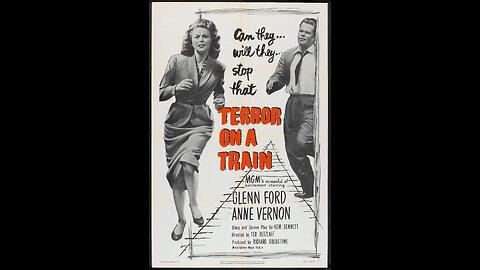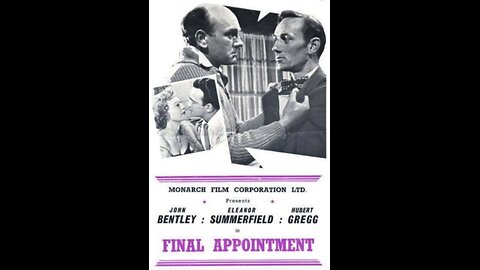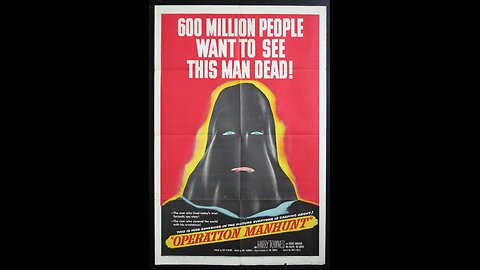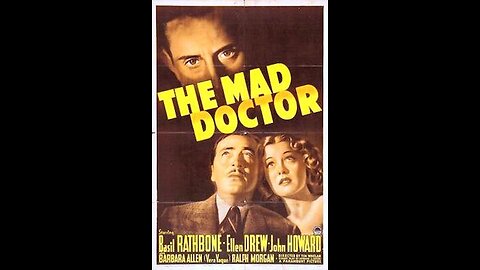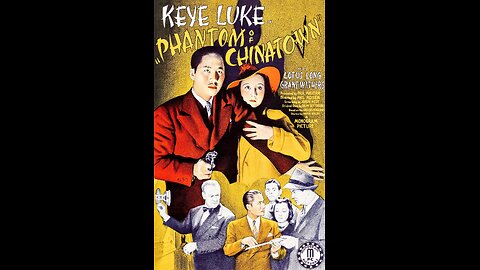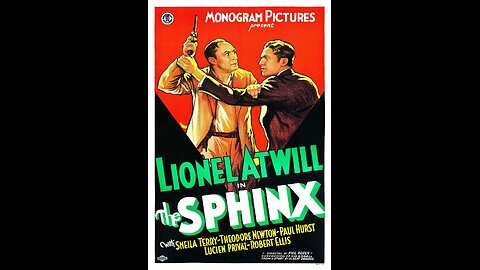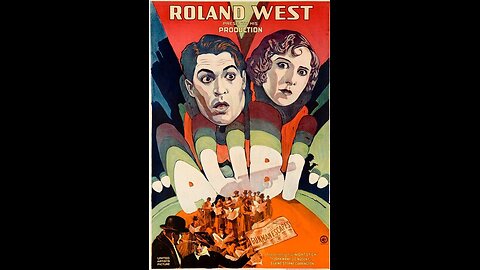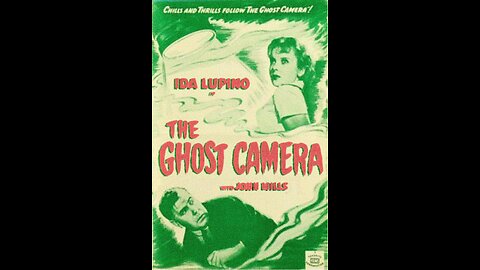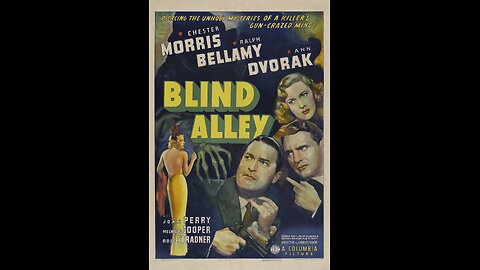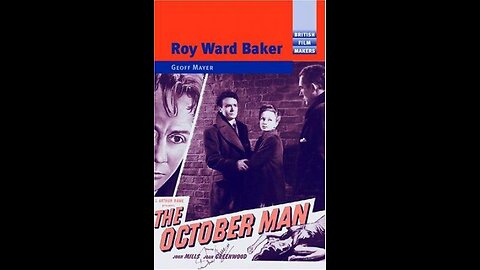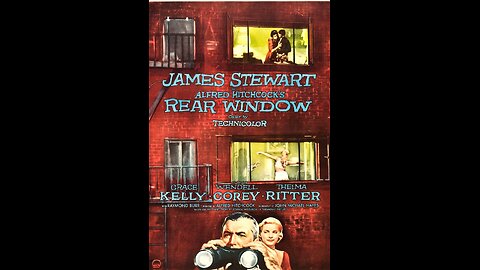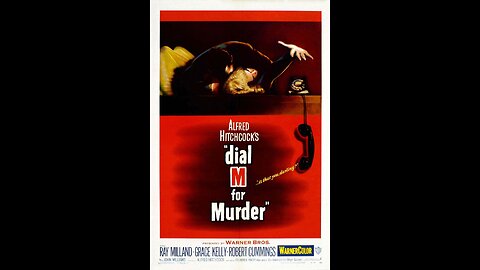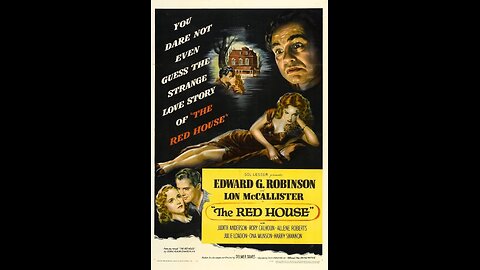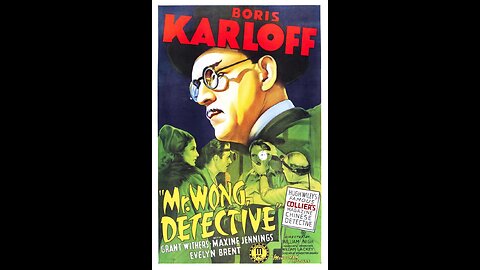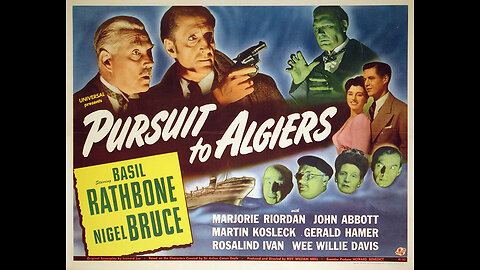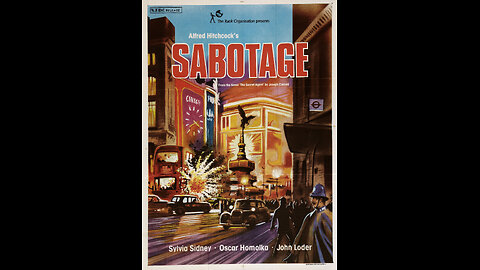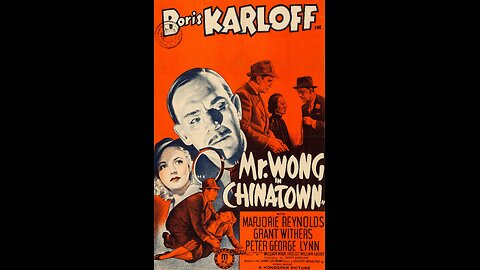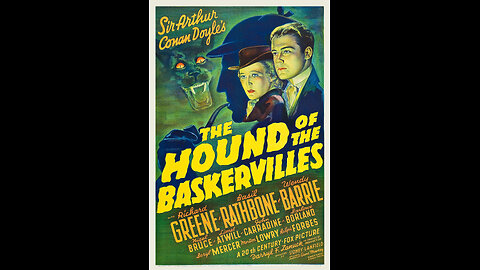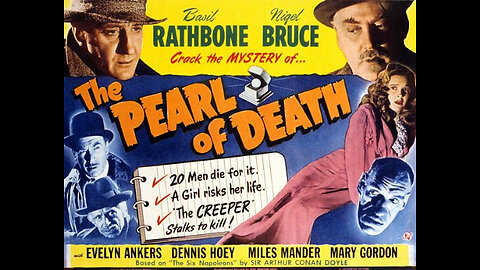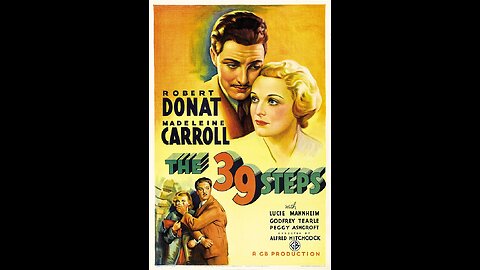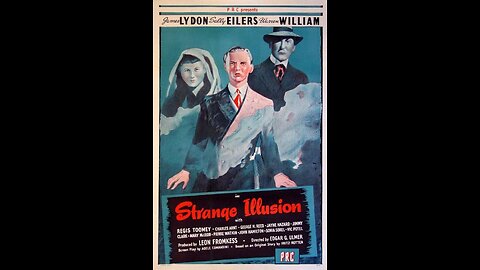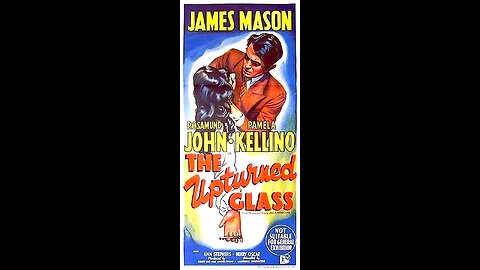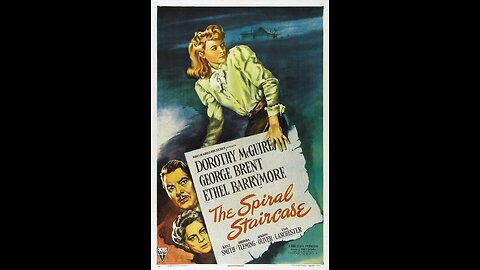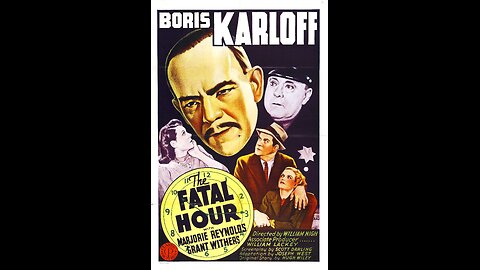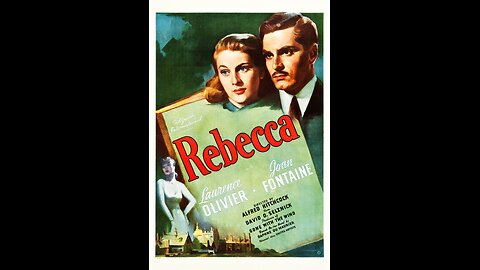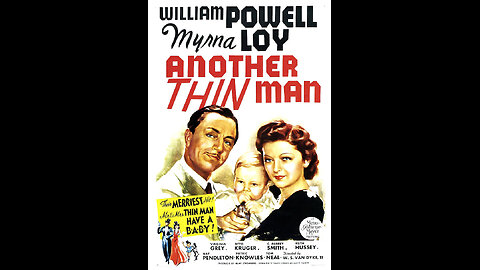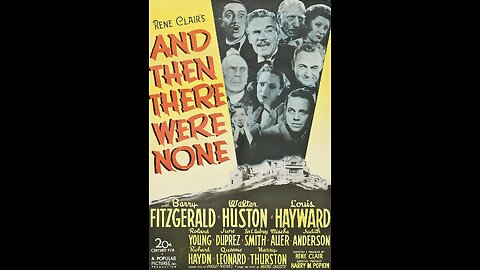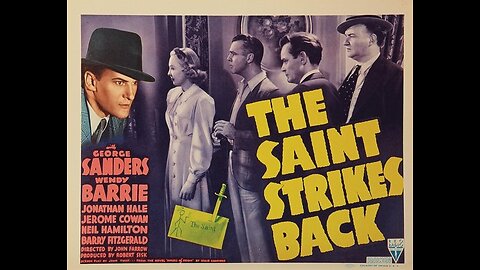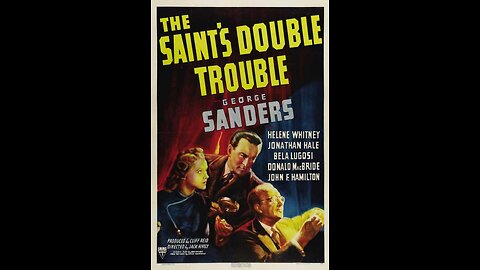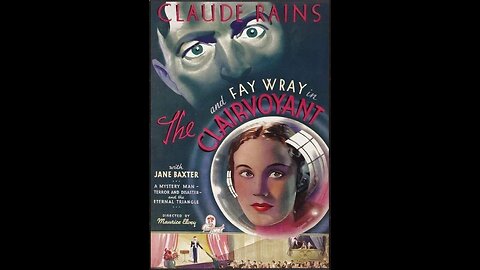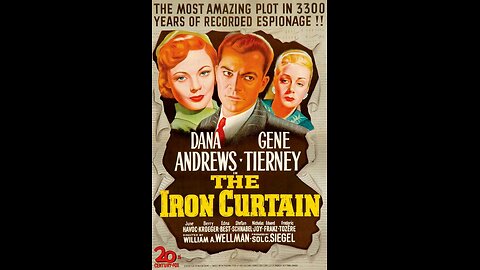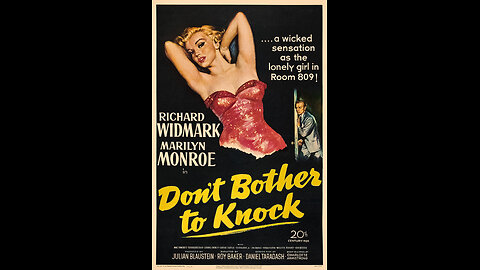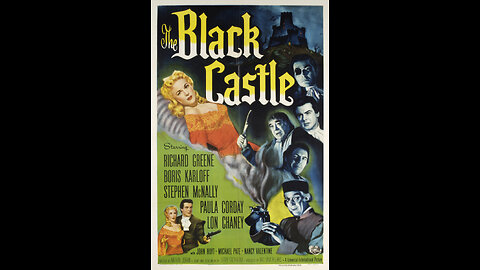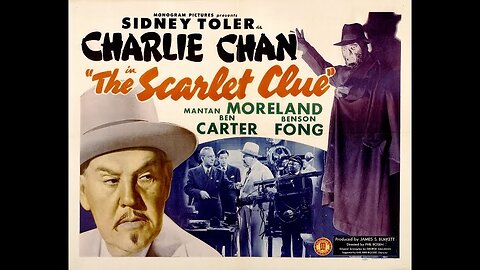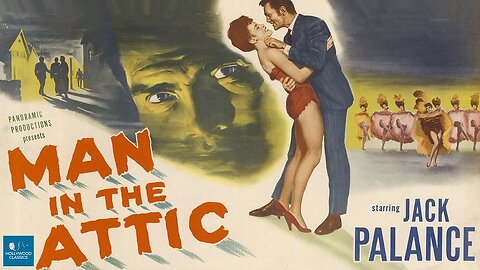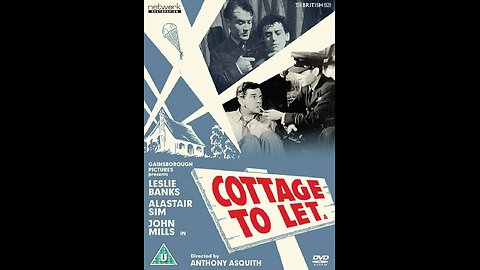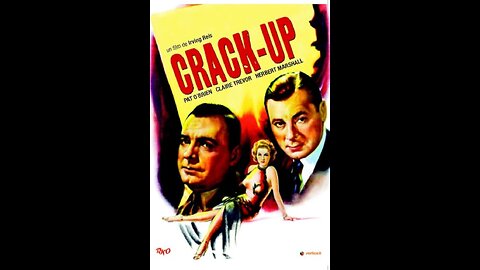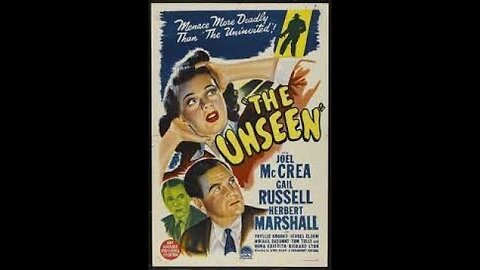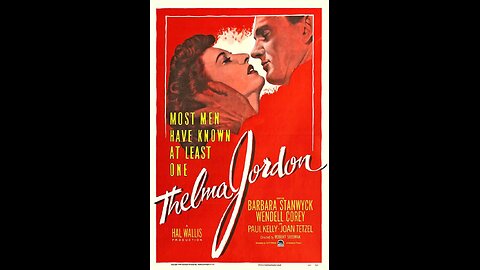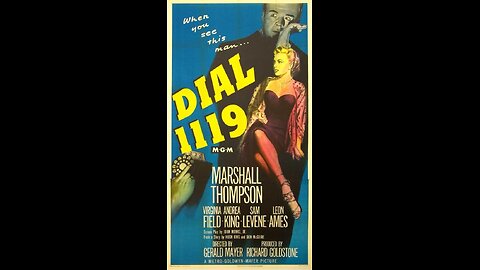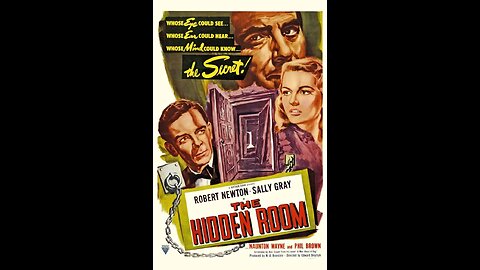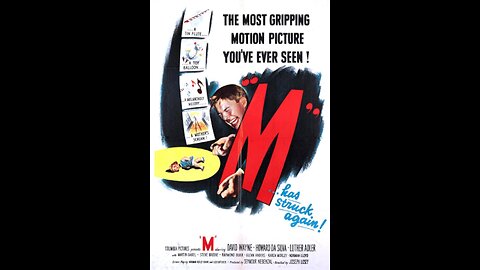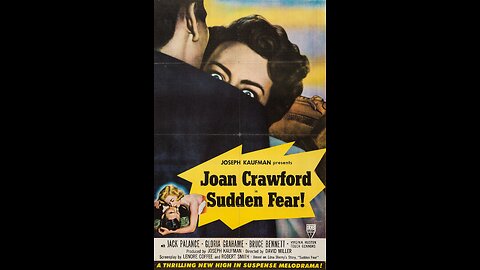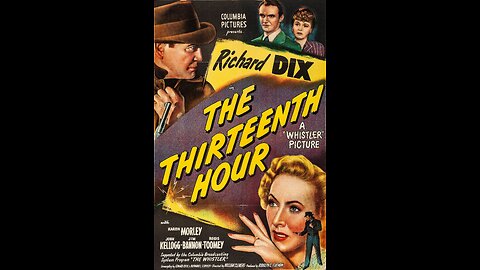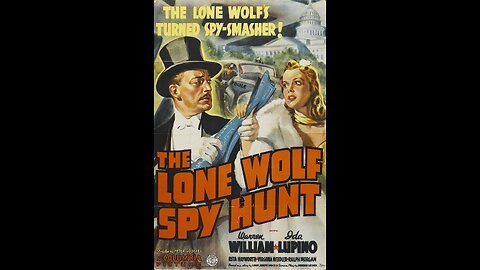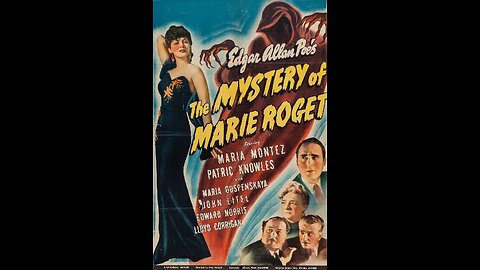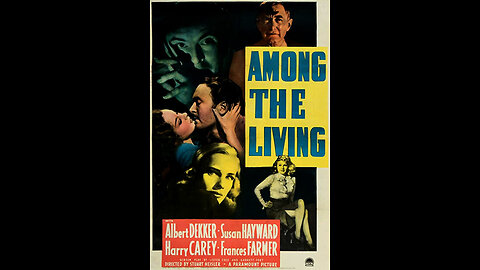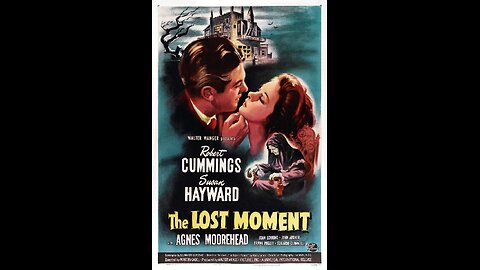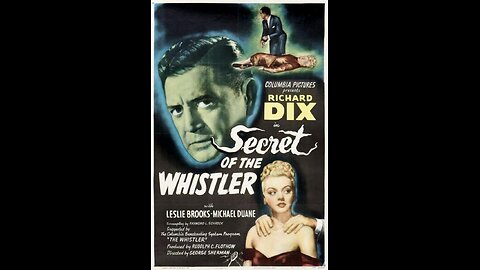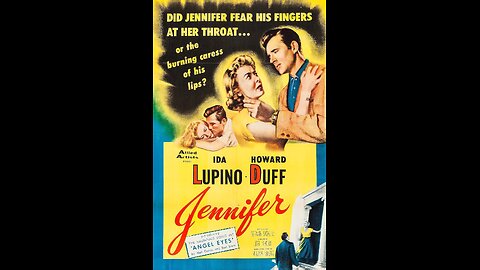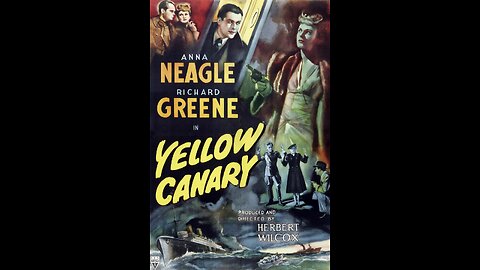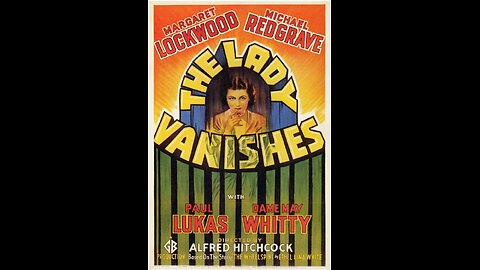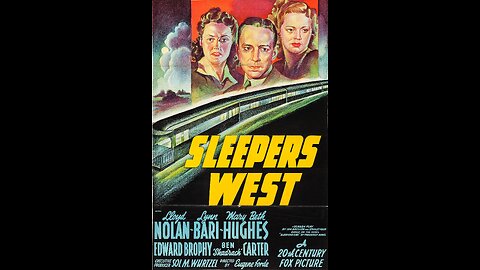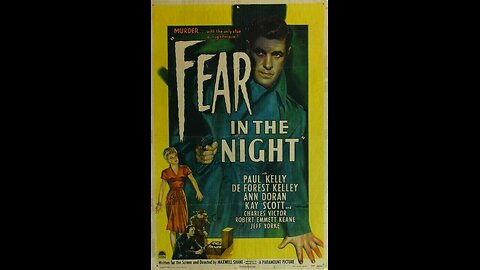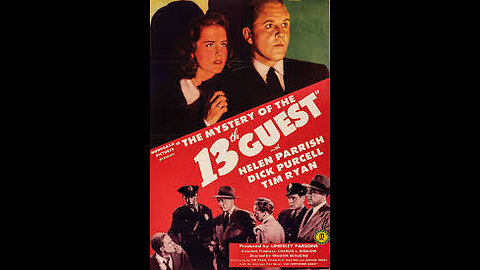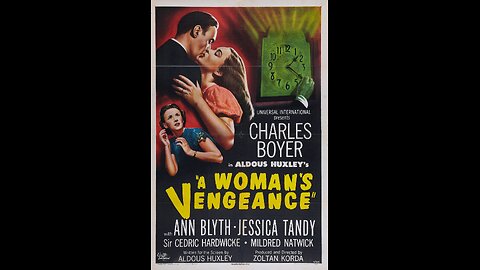Premium Only Content
This video is only available to Rumble Premium subscribers. Subscribe to
enjoy exclusive content and ad-free viewing.
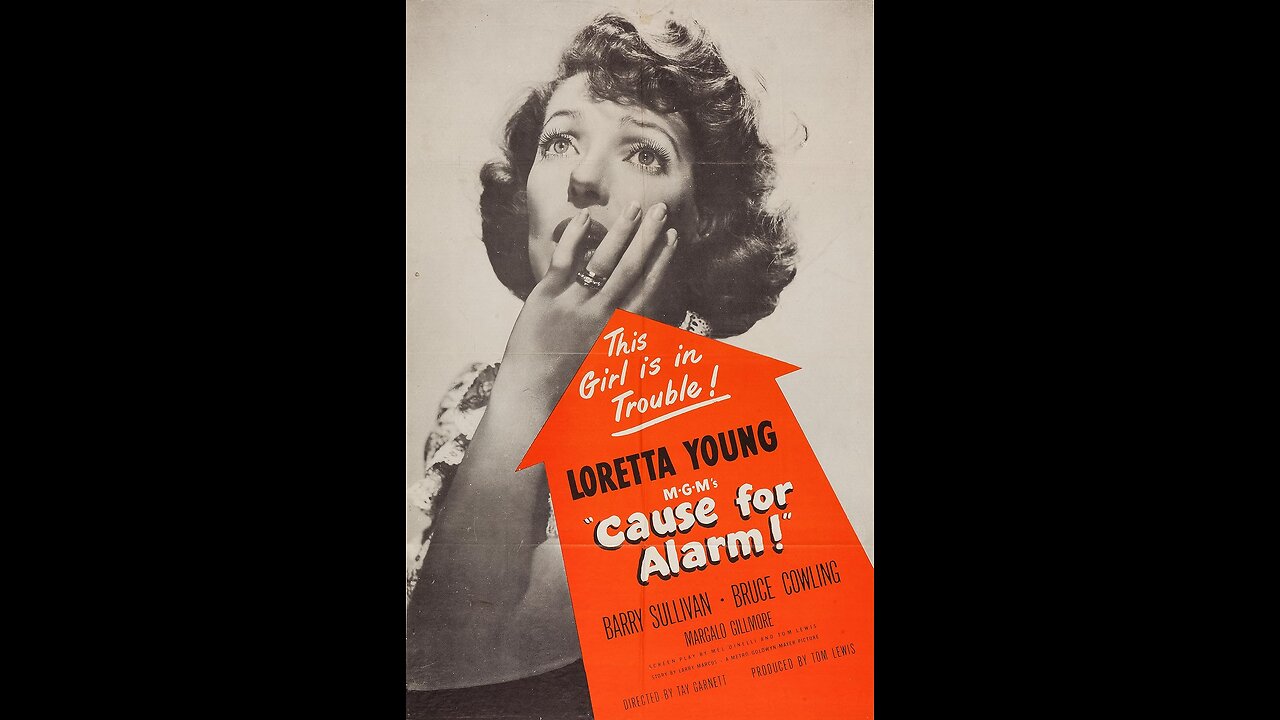
Mystery Thrillers
Cinema2000
- 80 / 101
1
Terror on a Train (1953) | Directed by Ted Tetzlaff
Classic Films & Movies Archive
"Terror on a Train" is a tense British suspense thriller centered on a Canadian bomb disposal expert called in to defuse an explosive device placed on a munitions train in England. As the train is shunted onto a remote siding to avoid catastrophe, the expert races against time to prevent a potential disaster while dealing with personal conflicts and mounting pressure.
Genre: Thriller, Crime, Drama
Director: Ted Tetzlaff
Ted Tetzlaff was an American cinematographer turned director. He began his career behind the camera on films such as "My Man Godfrey" (1936) and Alfred Hitchcock's "Notorious" (1946), before transitioning into directing in the late 1940s. His directorial efforts often emphasized taut storytelling and visual style, influenced by his cinematography background.
Star Cast:
* Glenn Ford as Peter Lyncort
* Anne Vernon as Frankie Lyncort
* Maurice Denham as Superintendent Spencer
* Harcourt Williams as Father
* John Boxer as Sergeant Robbins
At the time of its release, "Terror on a Train" was considered a modest, well-crafted thriller. Though not a major commercial success, it was praised for its efficient pacing, realistic tension, and Glenn Ford’s reliable performance. Critics appreciated the film’s grounded take on bomb disposal, a subject rarely portrayed in such detail at the time.
Fun Facts:
* The film was released in the United States under the alternative title "Time Bomb".
* Glenn Ford, an American star, was cast to increase the film’s appeal in the US market, though the rest of the cast was largely British.
* The film’s story is loosely inspired by real-life bomb threats and disposal practices during and after World War II.
* Director Ted Tetzlaff, known for his eye for visuals, brought a documentary-like realism to the railway yard sequences.
* The film was shot on location in the UK, using actual train yards to enhance authenticity.
* This Rumble Movie Channel is comprehensively indexed on https://kinoquick.com - find you favourite movies fast & free!
* Follow this channel to be notified of daily movie updates.
2
Final Appointment (1954) | Directed by Terence Fisher
Classic Films & Movies Archive
Final Appointment is a British crime thriller that follows an intrepid journalist and his photographer fiancée as they attempt to unravel a series of mysterious murders. The killer appears to be targeting ex-army officers connected to a wartime court martial, and the pair's investigation leads them deep into a web of military secrets, revenge, and danger.
Genre: Crime, Thriller, Mystery
Director: Terence Fisher
Terence Fisher was an English film director known especially for his work with Hammer Film Productions during the 1950s and 1960s. Born in 1904, he became renowned for revitalising the horror genre with a distinctively Gothic style. Fisher is best remembered for classics such as The Curse of Frankenstein (1957) and Horror of Dracula (1958), though he directed in multiple genres including crime thrillers and sci-fi.
Star Cast:
* John Bentley as Mike Billings
* Eleanor Summerfield as Jenny Drew
* Hubert Gregg as Inspector Corcoran
* Meredith Edwards as Inspector Lane
* Peter Bathurst as Major Osborne
* Arthur Lovegrove as Fred
* Liam Redmond as John Harvey
Final Appointment was generally well-received as a solid low-budget British thriller. Viewers appreciated its tight pacing and the chemistry between Bentley and Summerfield, who would reprise their roles in a follow-up film. Though not a blockbuster, it found a steady audience among fans of mid-century British mystery cinema.
Fun Facts:
* The film was successful enough to spawn a sequel titled Stolen Assignment in 1955, featuring the same lead characters.
* Final Appointment is notable for being one of Terence Fisher’s early directorial efforts before he became a major figure in British horror.
* The storyline incorporates post-war themes, reflecting British society's lingering concerns about wartime justice and military conduct.
* This Rumble Movie Channel is comprehensively indexed on https://kinoquick.com - find you favourite movies fast & free!
* Follow this channel to be notified of daily movie updates.
3
Operation Manhunt (1954) | Directed by Jack Alexander
Classic Films & Movies Archive
Operation Manhunt is a Cold War espionage thriller centered on the real-life defection of Igor Gouzenko, a former Soviet cipher clerk whose revelations in 1945 exposed a major Soviet spy ring operating in Canada and the United States. The film fictionalizes his story, focusing on the threats and dangers he faces as the Soviets attempt to silence him for his betrayal.
Genre: Thriller, Spy Drama
Director: Jack Alexander
Jack Alexander was a relatively obscure director with few known credits. Operation Manhunt is his most recognized work, and he is noted for his involvement in politically charged, low-budget productions during the 1950s. His directorial work often focused on sensational or topical subjects, and he brought a documentary-style intensity to this film.
Star Cast:
* Harry Townes as Igor Gouzenko
* Irja Jensen as Anna Gouzenko
* Jacques Aubuchon as Soviet agent
* George Spaulding
* Albert Miller
Operation Manhunt received moderate attention upon release, largely due to its topical nature and basis in actual espionage events. Critics acknowledged its earnest attempt to dramatize a true and unsettling episode of Cold War history. While not a major box office success, the film drew praise for its suspenseful pacing and was noted for its semi-documentary feel. It held particular interest for audiences concerned with Cold War tensions and Soviet infiltration.
Fun Facts:
* The film is based on the real-life defection of Igor Gouzenko, who in 1945 walked out of the Soviet embassy in Ottawa with over 100 classified documents.
* Gouzenko's disclosures led to several arrests and significantly influenced North American policies toward Soviet espionage during the early Cold War.
* Due to threats against his life, Gouzenko lived under police protection in Canada, and in the film, his identity is portrayed by an actor to preserve his anonymity.
* The movie was partially shot in Canada and features a mix of dramatized scenes and semi-documentary narration, enhancing its realism.
* This Rumble Movie Channel is comprehensively indexed on https://kinoquick.com - find you favourite movies fast & free!
* Follow this channel to be notified of daily movie updates.
4
The Mad Doctor (1940) | Directed by Tim Whelan
Classic Films & Movies Archive
In this atmospheric psychological thriller, a mysterious and suave physician with a shadowy past marries a series of wealthy women—each of whom meets an untimely and suspicious death. As suspicion mounts, a determined psychiatrist and an intrepid journalist race to expose his deadly secrets before another victim falls prey to his sinister charm.
Genre: Mystery / Thriller / Horror
Director: Tim Whelan
Tim Whelan was a versatile American director and screenwriter known for both comedies and suspense films. Born in 1893, he worked in both Hollywood and Britain, co-directing some of the early sound-era classics such as "The Thief of Bagdad" (1940). His career spanned from silent films to mid-1940s sound pictures, and he was admired for his stylish visual storytelling and pacing.
Star Cast:
* Basil Rathbone as Dr. George Sebastian
* Ellen Drew as Linda Boothe
* John Howard as Gil Harding
* Martin Kosleck as Maurice, the assistant
* Ralph Morgan as Dr. Downer
* Charles Lane as the hospital intern
Upon release, *The Mad Doctor* received a mixed critical reception. Audiences were intrigued by Basil Rathbone’s chilling performance, especially given his popularity as Sherlock Holmes at the time. However, some reviewers criticized the film’s predictable plot and its reliance on genre clichés. Over the years, it has gained a modest cult following among fans of early horror-thrillers and Rathbone's darker roles.
Fun Facts:
* The film was released by Paramount Pictures during the height of Basil Rathbone’s fame as Sherlock Holmes, making his turn as a villain particularly striking for audiences.
* The studio reportedly had to tone down some elements to satisfy the Production Code, especially regarding the doctor’s methods and motivations.
* Martin Kosleck, who played the doctor’s eerie assistant, became known for playing sinister characters, including several portrayals of Joseph Goebbels during World War II.
* Though not a major hit, the film is often cited as an example of 1940s Hollywood blending Gothic horror with modern psychological suspense.
* This Rumble Movie Channel is comprehensively indexed on https://kinoquick.com - find you favourite movies fast & free!
* Follow this channel to be notified of daily movie updates.
5
Phantom of Chinatown (1940) | Directed by Phil Rosen
Classic Films & Movies Archive
Phantom of Chinatown is a mystery-adventure film and the final entry in the "Mr. Wong" detective series. Unlike previous installments featuring Boris Karloff as the titular sleuth, this film introduces Keye Luke as the lead, playing detective James Lee Wong. The plot follows Wong as he investigates the sudden death of an archaeologist who had just returned from a dig in Asia with a secret scroll. The search for a hidden tomb and a legendary treasure leads to murder, deception, and a climactic reveal in San Francisco’s Chinatown.
Genre: Mystery, Crime, Adventure
Director: Phil Rosen
Phil Rosen was a veteran director of low-budget films during the 1920s through the 1940s. Known for his prolific output, Rosen specialized in crime dramas and mysteries, often working within tight budgets and schedules. He directed numerous entries in detective series like Charlie Chan and Mr. Wong. While his work rarely received mainstream acclaim, he was respected for his efficiency and ability to create suspenseful stories in the B-movie tradition.
Star Cast:
- Keye Luke as James Lee Wong
- Grant Withers as Captain Street
- Lotus Long as Win Len
- Huntley Gordon as Dr. Benton
- Charles Miller as Mason
- Frank Lackteen as Jonas
Phantom of Chinatown was notable for breaking ground by casting Keye Luke, a Chinese-American actor, as the lead detective—something rarely seen in Hollywood at the time. Although a B-picture with limited release, it was appreciated by audiences for its brisk pacing and atmospheric setting. Mystery fans found it a satisfying, if modest, whodunit with exotic intrigue. The film remains of historical interest for reversing the usual racial casting trend in early detective films.
Fun Facts:
- This was the sixth and final film in the Mr. Wong series, and the only one where the lead role was played by an Asian actor.
- Keye Luke had previously portrayed Charlie Chan’s son in the Charlie Chan film series and was one of the few Asian-American stars in 1930s–40s Hollywood.
- The story involved archaeological mysteries and coded messages—common tropes in pulp adventure films of the era.
- The film’s use of San Francisco’s Chinatown as a setting helped create a moody and culturally rich backdrop, despite limited production values.
- Phantom of Chinatown is now in the public domain and frequently shown on classic film channels and streaming platforms.
Phantom of Chinatown (1940) stands as a unique and culturally significant entry in early Hollywood detective cinema, notable for giving a rare leading role to an Asian-American actor in a time when such casting was virtually unheard of.
* This Rumble Movie Channel is comprehensively indexed on https://kinoquick.com - find you favourite movies fast & free!
* Follow this channel to be notified of daily movie updates.
1
comment
6
The Sphinx (1933) | Directed by Phil Rosen
Classic Films & Movies Archive
The Sphinx is a pre-Code mystery thriller centered on a series of murders tied to a Wall Street scandal. The prime suspect is a wealthy, reclusive philanthropist, Jerome Breen, who is believed to be deaf and mute. Despite this, witnesses claim to have heard him speak, leading police and reporters into a baffling investigation. As the mystery deepens, suspicion mounts and the question lingers: is Breen truly incapable of speech, or is he a cunning killer hiding behind a false disability?
Genre: Mystery, Crime, Thriller
Director: Phil Rosen
Phil Rosen was a prolific American director whose career spanned the silent and sound eras, directing over 140 films from the 1910s to the 1940s. He was known for his efficiency and ability to handle modestly budgeted films across genres, particularly mysteries and crime dramas. Though not considered a major auteur, Rosen had a talent for atmospheric tension and straightforward storytelling, making him a reliable figure in early Hollywood’s B-movie scene.
Star Cast:
- Lionel Atwill as Jerome Breen
- Sheila Terry as Jerry Crane
- Theodore Newton as Jack Burton
- Paul Hurst as Detective Kelly
- Robert Ellis as Inspector Riley
- Luis Alberni as Luigi Baccigalupi
Audiences in 1933 enjoyed The Sphinx as a taut, engaging murder mystery. Lionel Atwill’s enigmatic performance received praise, with critics noting his ability to convey menace and ambiguity without speaking for most of the film. The film’s unusual premise, featuring a possibly deceptive deaf-mute suspect, intrigued viewers and set it apart from other crime dramas of the period. Though a low-budget production, it was considered effective and entertaining, particularly for mystery fans.
Fun Facts:
- Lionel Atwill, known for his roles in horror and mystery films, was at the peak of his popularity in the early 1930s, appearing in titles like Doctor X and Mystery of the Wax Museum.
- The Sphinx was made before the enforcement of the Hays Code, allowing for some morally ambiguous and suggestive elements uncommon in later 1930s films.
- Though not widely remembered today, the film developed a small cult following among fans of early mystery cinema for its eerie atmosphere and clever twist.
- The film’s resolution relies on a psychological reveal that was innovative for its time, foreshadowing more complex detective narratives in later noir films.
The Sphinx (1933) stands as a compact and suspenseful whodunit with an intriguing central performance and a plot that keeps audiences guessing until the final scenes.
* This Rumble Movie Channel is comprehensively indexed on https://kinoquick.com - find you favourite movies fast & free!
* Follow this channel to be notified of daily movie updates.
7
The Sign of Four (1932) | Directed by Graham Cutts
Classic Films & Movies Archive
The Sign of Four is a British mystery film based on the Sherlock Holmes novel by Arthur Conan Doyle. The story follows Holmes and Dr. Watson as they investigate a perplexing case involving a secret pact among four men, a stolen treasure, and a mysterious death. When Mary Morstan seeks Holmes' help after receiving anonymous messages connected to her missing father and a valuable inheritance, the trail leads them into a web of colonial intrigue and betrayal.
Genre: Mystery, Crime, Detective
Director: Graham Cutts
Graham Cutts was a British film director active during the silent and early sound eras. He began his career in the 1920s and was known for directing a number of popular films for Gainsborough Pictures. Though his influence waned in the 1930s, Cutts played a formative role in shaping British cinema, and he is also remembered for giving Alfred Hitchcock some of his early career opportunities. His direction often focused on stylish visuals and strong narrative pacing.
Star Cast:
- Arthur Wontner as Sherlock Holmes
- Ian Hunter as Dr. John Watson
- Isla Bevan as Mary Morstan
- Graham Soutten as Thaddeus Sholto
- Miles Malleson as Major Sholto
- Roy Emerton as Jonathan Small
The film was part of a series of Sherlock Holmes adaptations starring Arthur Wontner, who was widely praised at the time for his faithful and dignified portrayal of the great detective. Although this 1932 adaptation lacked the production gloss of later Hollywood films, it was well-received by British audiences and remains appreciated by classic mystery fans for its atmospheric tone and period detail. Critics noted Wontner's intelligent, understated approach as a highlight.
Fun Facts:
- Arthur Wontner portrayed Sherlock Holmes in five films between 1931 and 1937, and his version of the character was admired by Conan Doyle’s own son.
- The film deviated in some parts from Conan Doyle’s novel, particularly in simplifying plot points for runtime and budget.
- Ian Hunter, who played Dr. Watson here, went on to appear in several notable Hollywood films, including The Adventures of Robin Hood (1938) as King Richard.
- The production reflects early 1930s British filmmaking, with static camera work and a stage-like atmosphere, which was typical of the time.
- The film is sometimes noted for its early use of a chase sequence on the Thames, an element that would become iconic in later Sherlock Holmes adaptations.
The Sign of Four (1932) remains a key piece of early Sherlock Holmes cinema, representing a transitional moment from theatrical stagecraft to more dynamic film storytelling.
* This Rumble Movie Channel is comprehensively indexed on https://kinoquick.com - find you favourite movies fast & free!
* Follow this channel to be notified of daily movie updates.
8
Alibi (1929) | Directed by Roland West
Classic Films & Movies Archive
Alibi tells the story of Chick Williams, a gangster recently released from prison who tries to maintain an innocent front while being closely watched by the police. When a cop is murdered, Chick becomes the prime suspect. As the investigation unfolds, questions of justice, deception, and loyalty take center stage in this early sound-era crime drama.
Genre: Crime, Drama, Mystery
Director: Roland West
Roland West (1885–1952) was an American film director and screenwriter known for his work in the silent and early sound film eras. He was recognized for his visual style, particularly in the crime and mystery genres. West's career included notable films such as The Bat and Alibi, the latter of which was one of the first gangster films to use synchronized sound innovatively. His career was relatively short, and he retired early from filmmaking under mysterious circumstances, partly due to rumors surrounding the death of actress Thelma Todd.
Star Cast:
- Chester Morris as Chick Williams
- Eleanor Griffith as Joan Manning
- Regis Toomey as Danny McGann
- Purnell Pratt as Police Sgt. Pete Manning
- Harry Stubbs as Buck Bachman
- Mae Busch as Daisy Thomas
Upon its release, Alibi was praised for its innovative use of sound and atmospheric cinematography. Audiences were drawn to its gritty depiction of crime and the performance of Chester Morris, who received an Academy Award nomination for Best Actor. The film stood out in the early sound era for its moody lighting, stylized set pieces, and ambitious narrative structure.
Fun Facts:
- Alibi was one of the first sound films to incorporate expressionistic lighting and set design influenced by German cinema.
- Chester Morris received an Oscar nomination for his role, and the film also earned nominations for Best Picture and Best Art Direction.
- The film was based on the stage play "Nightstick" by John Wray, J. Harold Murray, and Elaine Sterne Carrington.
- Director Roland West experimented with camera movement and sound effects, which were still novel in 1929, to heighten suspense and mood.
- Alibi is considered a precursor to the classic American gangster film genre that would flourish in the 1930s.
* This Rumble Movie Channel is comprehensively indexed on https://kinoquick.com - find you favourite movies fast & free!
* Follow this channel to be notified of daily movie updates.
9
The Ghost Camera (1933) | Directed by Bernard Vorhaus
Classic Films & Movies Archive
When a man named John Gray finds a camera left in his car, he discovers undeveloped film inside that contains images suggesting a crime has occurred. Determined to solve the mystery, he sets off on an amateur investigation, leading him into a web of intrigue and danger involving a missing woman and a criminal plot.
Genre: Mystery, Thriller, Crime
Director: Bernard Vorhaus
Bernard Vorhaus (1904–2000) was an American-born film director and screenwriter who worked extensively in Britain during the 1930s. He was known for his efficient storytelling and creative use of limited budgets, especially in the genre of low-budget thrillers. Vorhaus later moved back to the United States but was blacklisted during the McCarthy era, leading him to leave the film industry and work in housing construction.
Star Cast:
- Henry Kendall as John Gray
- Ida Lupino as Mary Elton
- John Mills as Ernest Elton
- Victor Stanley as Charlie Elton
- Felix Aylmer as Sir Jasper
The Ghost Camera was well-received for a low-budget "quota quickie" film, praised for its pace, suspense, and inventive direction. It was considered a cut above many of the quickly produced British films of the era, helping to establish Bernard Vorhaus’s reputation as a talented director. Ida Lupino’s early performance also drew attention, marking the beginning of a long and successful career.
Fun Facts:
- The film is considered one of the best examples of a "quota quickie," a term for films made quickly to meet British government requirements for domestic content in cinemas.
- This was one of Ida Lupino’s earliest film roles; she was only 15 years old during filming.
- Bernard Vorhaus often worked with editor David Lean, who would later become a legendary director known for films like Lawrence of Arabia and The Bridge on the River Kwai.
- Despite being made on a small budget, the film featured innovative camera work and editing techniques that set it apart from other low-budget mysteries of the time.
* This Rumble Movie Channel is comprehensively indexed on https://kinoquick.com - find you favourite movies fast & free!
* Follow this channel to be notified of daily movie updates.
10
Blind Alley (1939 | Directed by Charles Vidor
Classic Films & Movies Archive
Blind Alley is a psychological crime thriller that follows a tense hostage situation between a ruthless gangster and a brilliant psychologist. The story unfolds when gangster Hal Wilson, on the run from the law, takes refuge in the home of Dr. Anthony Shelby. As Wilson holds the doctor and his guests captive, Shelby uses his psychological expertise to break down Wilson’s mind, revealing deep-seated fears and traumas. A battle of wits ensues, with Shelby attempting to manipulate Wilson into making a fatal mistake before the police close in.
Genre: Crime, Thriller, Psychological Drama
Director: Charles Vidor
Charles Vidor was a Hungarian-American film director known for his work in both crime thrillers and romantic dramas. Born in 1900, he made a name for himself with films that blended psychological tension with stylish cinematography. He later gained fame for directing Gilda (1946), starring Rita Hayworth. His ability to create compelling character-driven narratives made him one of Hollywood’s most respected filmmakers of the era.
Star Cast:
- Chester Morris as Hal Wilson
- Ralph Bellamy as Dr. Anthony Shelby
- Ann Dvorak as Mary
- Joan Perry as Linda Curtis
- Melville Cooper as George Curtis
- Rose Stradner as Doris Shelby
Upon its release, Blind Alley was praised for its innovative use of psychological tension, a relatively new concept in crime films at the time. Critics and audiences appreciated the film’s cerebral approach, as well as the strong performances by Chester Morris as the dangerous yet vulnerable gangster and Ralph Bellamy as the composed psychologist. While not as widely remembered as some later psychological thrillers, it has been recognized as an early influence on the genre.
Fun Facts:
- The film was one of the first Hollywood productions to incorporate psychoanalysis into a crime thriller, paving the way for later films like Spellbound (1945).
- It was remade in 1948 as The Dark Past, starring William Holden and Lee J. Cobb.
- Director Charles Vidor would later become well known for his work with Rita Hayworth in the 1940s, moving away from crime thrillers into more glamorous productions.
- Chester Morris, best known for his role in the Boston Blackie detective series, played against type as a psychologically tormented gangster.
- The film’s tight pacing and single-location setting contributed to its tense, claustrophobic atmosphere, making it an effective early example of a psychological thriller.
* This Rumble Movie Channel is comprehensively indexed on https://kinoquick.com - find you favourite movies fast & free!
* Follow this channel to be notified of daily movie updates.
11
October Man (1947) | Directed by Roy Ward Baker
Classic Films & Movies Archive
October Man is a British psychological thriller about a man recovering from a traumatic accident who becomes the prime suspect in a murder case. The film follows Jim Ackland, who struggles with psychological distress after surviving a bus crash that killed a young girl in his care. As he tries to rebuild his life, he is falsely accused of murdering a woman in his boarding house. Facing police scrutiny and public suspicion, he must prove his innocence while battling his own self-doubt.
Genre: Thriller, Crime, Drama
Director: Roy Ward Baker
Roy Ward Baker was an English filmmaker known for his work in both British and Hollywood cinema. Born in 1916, he gained recognition for directing films across multiple genres, including thrillers, war dramas, and horror films. His most famous works include A Night to Remember (1958), which depicted the Titanic disaster, and several Hammer Horror productions. He was respected for his precise storytelling and ability to create suspenseful atmospheres.
Star Cast:
- John Mills as Jim Ackland
- Joan Greenwood as Jenny Carden
- Edward Chapman as Mr. Peachy
- Kay Walsh as Molly Newman
- Joyce Carey as Mrs. Vinton
- Catherine Lacey as Miss Selby
October Man received positive reviews for its gripping narrative and John Mills’ compelling performance as the troubled protagonist. Critics praised the film’s psychological depth and atmospheric tension, considering it a standout British thriller of the era. Audiences appreciated its intelligent script and suspenseful plot, which kept viewers guessing until the end. Though not as widely known today, it remains a well-regarded classic in British cinema.
Fun Facts:
- The screenplay was written by Eric Ambler, a renowned writer of spy and thriller novels.
- John Mills, already a major star, was praised for his portrayal of a man suffering from psychological trauma, a theme not commonly explored in films of the time.
- The film’s moody cinematography and use of shadows contribute to its noir-like atmosphere, despite being a British production rather than a Hollywood noir.
- October Man was one of Roy Ward Baker’s early directorial efforts before he went on to greater fame with historical and horror films.
- The film’s title refers to the protagonist’s emotional state rather than the time of year, symbolizing his loneliness and struggles with identity.
* This Rumble Movie Channel is comprehensively indexed on https://kinoquick.com - find you favourite movies fast & free! Subscribe to this channel to be notified of daily movie updates.
12
Rear Window (1954) | Directed by Alfred Hitchcock
Classic Films & Movies Archive
A temporarily wheelchair-bound photographer, Jeff Jeffries, becomes obsessed with watching his neighbors from his apartment window. As he observes their daily lives, he begins to suspect that one of them has committed murder. With the help of his girlfriend and nurse, he sets out to prove his theory, leading to a tense and suspenseful climax.
Genre: Mystery, Thriller
Director: Alfred Hitchcock
Alfred Hitchcock (1899–1980) was an English filmmaker and one of the most influential directors in cinema history. Known as the "Master of Suspense," he revolutionized the thriller genre with innovative camera techniques, psychological depth, and masterful storytelling. His notable films include "Psycho" (1960), "Vertigo" (1958), and "North by Northwest" (1959). Hitchcock’s ability to create tension and his signature cameo appearances made him a legendary figure in Hollywood.
Star Cast:
- James Stewart as L.B. "Jeff" Jefferies
- Grace Kelly as Lisa Fremont
- Thelma Ritter as Stella
- Raymond Burr as Lars Thorwald
- Wendell Corey as Detective Doyle
"Rear Window" was a critical and commercial success upon its release and is now regarded as one of Hitchcock’s greatest films. Audiences were captivated by its suspenseful storytelling and unique premise. Over the years, it has remained a staple of film studies and is often cited as one of the best thrillers ever made. The film continues to receive praise for its innovative use of cinematography and its commentary on voyeurism.
Fun Facts:
- The entire film was shot on a massive indoor set built specifically for the movie, featuring fully functioning apartments.
- Alfred Hitchcock makes his signature cameo as a man winding a clock in the songwriter’s apartment.
- Grace Kelly’s wardrobe, designed by Edith Head, became iconic and is still celebrated in fashion history.
- The film was inspired by a real-life murder case involving British murderer Patrick Mahon.
- The movie was restored in the 1990s after being unavailable for many years due to Hitchcock’s rights ownership.
* This Rumble Movie Channel is comprehensively indexed on https://kinoquick.com - find you favourite movies fast & free! Subscribe to this channel to be notified of daily movie updates.
13
Dial M for Murder (1954) | Directed by Alfred Hitchcock
Classic Films & Movies Archive
"Dial M for Murder" is a 1954 thriller directed by Alfred Hitchcock. The film centers on Tony Wendice, a former tennis player who plots to murder his unfaithful wife, Margot, to inherit her wealth. When the plan fails, Tony manipulates the situation to frame Margot for murder, leading to a suspenseful investigation.
Genre: Thriller
Director: Alfred Hitchcock
Alfred Hitchcock (1899–1980) was a British filmmaker renowned for his mastery of suspense and psychological thrillers. Dubbed the "Master of Suspense," his prolific career spanned six decades, during which he directed classics like "Psycho," "Rear Window," and "Vertigo." Hitchcock's innovative storytelling and cinematic techniques have left an indelible mark on the film industry.
Star Cast:
- Ray Milland as Tony Wendice, the scheming husband.
- Grace Kelly as Margot Wendice, Tony's unsuspecting wife.
- Robert Cummings as Mark Halliday, Margot's lover and an American crime writer.
- John Williams as Chief Inspector Hubbard, the astute detective investigating the case.
- Anthony Dawson as Charles Swann (Captain Lesgate), the man Tony blackmails to commit the murder.
Upon its release, "Dial M for Murder" received positive reviews for its tight plotting and Hitchcock's direction. Bosley Crowther of The New York Times described it as a "technical triumph" and praised the performances, especially John Williams as the detective. Variety noted that while there were some weaknesses in the setup, Hitchcock's suspenseful techniques and the actors' performances glossed over them to a large extent. Over time, the film has been recognized as a classic, with The Guardian in 2012 calling it "a taut, acidly funny thriller." It was also listed by the American Film Institute in 2001 in AFI's 100 Years...100 Thrills (#48) and in 2008 in AFI's 10 Top 10 (#9 in Mysteries).
Fun Facts:
1. The film was originally shot in 3D, capitalizing on the early 1950s 3D movie trend. However, due to waning interest in the format, it was primarily released in 2D.
2. "Dial M for Murder" was based on a successful stage play of the same name by Frederick Knott, who also penned the screenplay for the film.
3. Grace Kelly's performance in this film marked her first collaboration with Hitchcock, leading to subsequent roles in "Rear Window" and "To Catch a Thief."
4. The entire film is predominantly set within the Wendice apartment, reflecting its theatrical origins and creating a claustrophobic atmosphere that heightens the tension.
5. A remake titled "A Perfect Murder" was released in 1998, starring Michael Douglas, Gwyneth Paltrow, and Viggo Mortensen, offering a modern take on the classic story.
Find your favorite movies fast: This Rumble movie channel is fully indexed on https://kinoquick.com
2
comments
14
Fog Island (1945) | An American mystery film directed by Terry O. Morse
Classic Films & Movies Archive
"Fog Island" is a 1945 American mystery film directed by Terry O. Morse. The story revolves around Leo Grainger, played by George Zucco, a wealthy man who invites a group of people to his mansion on a foggy island. As they gather, Grainger announces his plan to revenge himself on those he believes have wronged him. The tension rises as dark secrets are revealed, and the characters navigate the eerie atmosphere of the island shrouded in fog. The film is known for its suspenseful plot and atmospheric setting.
15
House of Secrets (1936) | American mystery film directed by Roland D. Reed
Classic Films & Movies Archive
"House of Secrets" is a 1936 American mystery film directed by Roland D. Reed. The story follows a young lawyer named Barry Wilding, played by Leslie Fenton, who finds himself entangled in a web of mystery and intrigue. When Barry takes on a case involving a missing girl and a disputed will, he discovers a sinister plot involving hidden identities, secret passages, and a grand mansion with a dark history. As he delves deeper into the secrets of the house, Barry must navigate through a complex web of deception to uncover the truth. The film combines elements of mystery and drama, typical of the era's storytelling, to create an engaging and suspenseful narrative.
16
The Red House (1947) | A psychological mystery thriller directed by Delmer Daves
Classic Films & Movies Archive
"The Red House" is a psychological mystery thriller directed by Delmer Daves and released in 1947. Based on the novel by George Agnew Chamberlain, the film explores themes of family secrets, guilt, and the impact of a haunting past. Starring Edward G. Robinson, Lon McCallister, Judith Anderson, and Allene Roberts, the movie is known for its atmospheric cinematography and suspenseful narrative.
The story revolves around Pete Morgan (Edward G. Robinson), a farmer who lives with his sister Ellen (Judith Anderson) and their adopted daughter Meg (Allene Roberts). Pete harbors a mysterious and dark secret related to the titular red house, a foreboding structure located in the woods near their farm. As Meg grows curious about her past and the red house, Pete becomes increasingly protective and evasive.
When Meg befriends Nath Storm (Lon McCallister), a classmate, and invites him to work on the farm, the already tense atmosphere becomes even more charged. Nath's curiosity about the red house intensifies, leading to the gradual unraveling of long-buried secrets and traumatic events. The film delves into the psychological toll of guilt and the consequences of suppressing painful memories.
Edward G. Robinson delivers a powerful performance as Pete Morgan, capturing the character's inner turmoil and the weight of his secrets. Lon McCallister and Allene Roberts offer solid performances as the young protagonists who unwittingly become entangled in the dark history of the Morgan family. Judith Anderson, known for her role in "Rebecca," adds depth to the film as the enigmatic sister, Ellen.
The film's cinematography, led by Bert Glennon, contributes significantly to its eerie atmosphere. The use of shadow and light in depicting the isolated rural setting and the foreboding red house enhances the suspense and tension throughout the narrative.
Miklós Rózsa's haunting musical score complements the film's mood, adding to the sense of unease and mystery. The score, characterized by its atmospheric and emotionally resonant themes, enhances the overall impact of the storytelling.
"The Red House" is notable for its departure from traditional genre conventions, blending elements of psychological drama with the mystery and thriller genres. It explores the impact of trauma on individuals and the interconnectedness of past and present. The film's subtle and atmospheric approach to storytelling, coupled with strong performances, has contributed to its status as a cult classic in the realm of psychological thrillers.
Overall, "The Red House" is a compelling exploration of family secrets and the psychological toll of suppressed memories, offering a unique and atmospheric take on the thriller genre from the classic Hollywood era.
17
Mr. Wong, Detective (1938) | American mystery film directed by William Nigh
Classic Films & Movies Archive
"Mr. Wong, Detective" is a 1938 American mystery film directed by William Nigh and featuring Boris Karloff in the title role. The film is part of the Mr. Wong series, where Karloff plays James Lee Wong, a Chinese detective.
In this installment, Mr. Wong is enlisted to solve a case involving the murder of shipping magnate Simon Dayton. As Wong investigates, he unravels a complex web of motives, secrets, and suspects. The plot is enriched with elements of suspense, intrigue, and a touch of the exotic, characteristic of detective films from the era. Boris Karloff brings his distinctive presence to the role, portraying the astute and enigmatic detective with his usual flair. "Mr. Wong, Detective" is a product of its time, capturing the essence of 1930s mystery cinema.
18
Sherlock Holmes: Pursuit to Algiers (1945)
Classic Films & Movies Archive
"Sherlock Holmes: Pursuit to Algiers" is a classic detective film released in 1945, featuring the iconic detective Sherlock Holmes and his loyal companion Dr. John Watson. Portrayed by Basil Rathbone and Nigel Bruce, respectively, Holmes and Watson embark on another thrilling adventure that takes them to the exotic location of Algiers.
The story unfolds as Holmes is tasked with ensuring the safe transport of the heir to the throne of a fictional European country, who is traveling on a passenger ship bound for Algiers. The detective must protect the young heir from potential threats and unravel a complex mystery that unfolds during the sea voyage.
As the ship sails through treacherous waters, Holmes uses his unparalleled deductive skills to uncover a web of intrigue, deception, and danger. The film captures the essence of Sir Arthur Conan Doyle's original stories, with Rathbone delivering a captivating performance as the brilliant and astute detective.
"Pursuit to Algiers" combines elements of suspense, mystery, and adventure, keeping audiences on the edge of their seats as Holmes navigates through the challenges presented by the high-stakes mission. Nigel Bruce's portrayal of Dr. Watson adds a touch of humor and camaraderie to the dynamic duo's interactions.
With its engaging plot, atmospheric setting, and the chemistry between Rathbone and Bruce, "Sherlock Holmes: Pursuit to Algiers" stands as a noteworthy entry in the series of Sherlock Holmes films from the 1940s. It continues to be appreciated by fans of classic detective cinema for its enduring appeal and timeless storytelling.
19
Sabotage (1936) | Alfred Hitchcock's thriller based on Joseph Conrad's novel "The Secret Agent"
Classic Films & Movies Archive
Alfred Hitchcock's "Sabotage" is a British thriller released in 1936, based on Joseph Conrad's novel "The Secret Agent." The film is often considered one of Hitchcock's early masterpieces and showcases his adeptness at building suspense and tension. While it shares a title with Conrad's novel, the plot diverges significantly.
The story is set in London and follows Sylvia Verloc (Sylvia Sidney), the wife of a cinema owner and secret saboteur, Karl Verloc (Oskar Homolka). Unbeknownst to Sylvia, her husband is involved in a terrorist plot to sabotage the city. Verloc is coerced by a foreign embassy to carry out the act, and his contact in the embassy is a mysterious figure known as the Professor (played by Peter Lorre).
As Verloc becomes entangled in the dangerous world of espionage and terrorism, tensions rise. The suspense intensifies when Verloc's plan goes awry, leading to unintended consequences. Hitchcock skillfully employs his trademark techniques, including the use of everyday settings for suspenseful scenarios and manipulating the audience's emotions through character development and plot twists.
One of the most memorable sequences in the film involves Sylvia carrying a package, unaware that it contains a bomb set to detonate. Hitchcock's meticulous pacing and tension-building techniques during this scene have been praised for their effectiveness.
The film explores themes of deception, betrayal, and the moral dilemmas faced by individuals caught in the web of espionage. Hitchcock's ability to create suspense is evident throughout, and the film culminates in a climactic and morally complex finale.
"Sabotage" is notable for its atmospheric cinematography, which captures the mood of pre-war London. The performances, particularly those of Sylvia Sidney and Oskar Homolka, contribute to the film's impact. Hitchcock's collaboration with cinematographer Bernard Knowles resulted in visually striking sequences that added to the overall tension and mood.
While Hitchcock took creative liberties with Conrad's source material, "Sabotage" stands as a testament to his early mastery of the thriller genre. The film's exploration of terrorism, moral ambiguity, and the psychological toll of espionage contributes to its status as a classic in Hitchcock's filmography.
20
Mr. Wong in Chinatown (1939) | American mystery film featuring Boris Karloff
Classic Films & Movies Archive
"Mr. Wong in Chinatown" is a 1939 American mystery film directed by William Nigh and featuring Boris Karloff as the titular character, James Lee Wong. This film is part of the Mr. Wong series, where Karloff portrays the Chinese detective.
In this installment, Mr. Wong finds himself immersed in a case involving the murder of an antique dealer. As he delves into the crime, Wong navigates the intricate alleys of Chinatown, uncovering secrets and motives that lead to a suspenseful climax. The film incorporates elements of mystery, crime, and a touch of the exotic, echoing the conventions of detective cinema from the late 1930s.
Boris Karloff delivers a compelling performance as Mr. Wong, bringing his unique charisma to the role of the astute detective. "Mr. Wong in Chinatown" reflects the storytelling style of its time and contributes to the series' legacy of classic mystery films.
21
The Mystery of Mr. Wong (1939) | American mystery film directed by William Nigh
Classic Films & Movies Archive
"The Mystery of Mr. Wong" is a 1939 American mystery film directed by William Nigh and featuring Boris Karloff in the role of James Lee Wong, a Chinese detective. This film is part of the Mr. Wong series, where Karloff assumes the character of the astute and culturally knowledgeable detective.
In this installment, Mr. Wong becomes embroiled in a complex case involving the murder of a respected archaeologist. The investigation takes him through a web of secrets, deception, and hidden motives. As Wong navigates the mystery, he employs his sharp intellect and cultural insights to unravel the truth behind the crime.
Boris Karloff's portrayal of Mr. Wong adds a touch of sophistication and depth to the character, and the film reflects the mystery genre conventions of the late 1930s. "The Mystery of Mr. Wong" offers a blend of suspense, intrigue, and a glimpse into the detective cinema of its era.
22
Sherlock Holmes : The Hound of the Baskervilles (1939)
Classic Films & Movies Archive
"The Hound of the Baskervilles" is a classic mystery film released in 1939, featuring the legendary detective Sherlock Holmes, as portrayed by Basil Rathbone, and his loyal companion Dr. John Watson, played by Nigel Bruce. The film is an adaptation of Sir Arthur Conan Doyle's famous novel of the same name.
The story revolves around the curse that haunts the Baskerville family, believed to be caused by a supernatural hound. Holmes and Watson are enlisted to investigate the mysterious death of Sir Charles Baskerville, who is said to have fallen victim to the curse. The setting is the eerie and atmospheric moors of Devonshire, adding a sense of suspense and tension to the narrative.
As Holmes delves into the case, he employs his brilliant deductive reasoning to separate fact from folklore and uncover the truth behind the alleged curse. The film masterfully combines elements of suspense, horror, and detective work, creating a captivating and thrilling cinematic experience.
Basil Rathbone delivers a memorable performance as the sharp and analytical Sherlock Holmes, while Nigel Bruce provides comic relief as the bumbling yet endearing Dr. Watson. The chemistry between the two actors became a hallmark of the series.
"The Hound of the Baskervilles" is celebrated for its atmospheric cinematography, strong performances, and adherence to the source material. It remains a classic adaptation of one of Sir Arthur Conan Doyle's most beloved Sherlock Holmes stories, captivating audiences with its timeless appeal and contributing to the enduring legacy of Holmes on the silver screen.
23
Sherlock Holmes : The Case of the Red-Headed League (1953)
Classic Films & Movies Archive
"The Case of the Red-Headed League" is a classic detective mystery adapted from Sir Arthur Conan Doyle's renowned Sherlock Holmes stories. The 1953 film, brings to life the brilliant detective Sherlock Holmes, portrayed by an actor from the era.
The storyline revolves around Holmes and his loyal companion, Dr. John Watson, as they delve into the peculiar case of the Red-Headed League. The League, seemingly innocuous, becomes the focus of Holmes's keen investigative skills when a red-headed man named Jabez Wilson seeks the detective's help. As Holmes pieces together clues and employs his deductive reasoning, the mystery deepens, revealing hidden motives and a more significant plot.
The film captures the essence of Doyle's detective tales, showcasing Holmes's unmatched intellect, attention to detail, and uncanny ability to solve perplexing cases. As the narrative unfolds, viewers are taken on a suspenseful journey through Victorian-era London, encountering colorful characters and intricate plot twists.
Overall, "The Case of the Red-Headed League" offers an engaging and authentic cinematic experience for fans of Sherlock Holmes and classic detective mysteries.
24
Sherlock Holmes : The Pearl of Death (1944)
Classic Films & Movies Archive
"The Pearl of Death" is a classic mystery film released in 1944, featuring the iconic detective Sherlock Holmes, portrayed by Basil Rathbone, and his loyal companion Dr. John Watson, played by Nigel Bruce. The film is part of the series of Sherlock Holmes films produced by Universal Pictures in the 1940s, known for their atmospheric storytelling and memorable performances.
In this installment, Holmes is tasked with solving the mysterious theft of the "Star of Delhi," a valuable pearl with a history of bringing misfortune to its owners. The pearl is stolen from a museum, and the trail of the crime leads Holmes and Watson into a web of intrigue involving a criminal mastermind known as "The Creeper."
As Holmes investigates, he must navigate a series of cleverly devised traps set by The Creeper, who is determined to thwart the detective's efforts. The film combines elements of suspense, deduction, and adventure, showcasing Holmes's brilliant analytical mind and Watson's unwavering loyalty.
Basil Rathbone delivers a charismatic performance as the sharp and incisive Sherlock Holmes, while Nigel Bruce adds charm and humor as the ever-faithful Dr. Watson. The chemistry between the two actors contributes to the enduring popularity of this series.
"The Pearl of Death" is praised for its engaging plot, atmospheric cinematography, and the dynamic portrayal of Holmes and Watson. It remains a beloved entry in the Sherlock Holmes film canon, capturing the essence of Sir Arthur Conan Doyle's detective stories while providing audiences with an entertaining and thrilling cinematic experience.
25
Night Train to Munich (1940) | British thriller film directed by Carol Reed
Classic Films & Movies Archive
"Night Train to Munich" is a British thriller film released in 1940, directed by Carol Reed. This World War II espionage drama is known for its suspenseful narrative and engaging storyline.
The plot revolves around a British secret agent named Gus Bennett, played by Rex Harrison, who becomes involved in a mission to rescue a Czech scientist, Dr. Axel Bomasch, along with his daughter Anna, from the clutches of the Nazis. The father-daughter duo possesses crucial information about a new scientific development that could aid the German war effort.
As the characters navigate the perilous landscape of espionage and wartime Europe, the film takes audiences on a thrilling journey aboard the titular night train to Munich. Packed with twists, turns, and unexpected alliances, "Night Train to Munich" keeps viewers on the edge of their seats.
The film is praised for its intelligent script, strong performances, and the atmospheric tension created by Reed, who would go on to direct other acclaimed films such as "The Third Man." "Night Train to Munich" stands as a noteworthy entry in the spy thriller genre of the era, providing both entertainment and a reflection of the anxieties and complexities of the wartime period.
26
The 39 Steps (1935) | Directed by the master of suspense Alfred Hitchcock
Classic Films & Movies Archive
"The 39 Steps" (1935), directed by the master of suspense Alfred Hitchcock, is a classic thriller that weaves a tale of intrigue, espionage, and mistaken identity. Adapted from John Buchan's novel, this iconic film showcases Hitchcock's signature blend of suspenseful storytelling and innovative cinematic techniques.
The plot follows Richard Hannay (played by Robert Donat), an unsuspecting Canadian visitor to London who becomes entangled in a web of espionage after a mysterious woman is murdered in his apartment. Falsely accused of the crime, Hannay goes on the run to clear his name and unravel the sinister conspiracy he unwittingly stumbled upon.
As Hannay navigates the treacherous landscape of 1930s Britain, the film unfolds into a gripping chase filled with suspense, unexpected twists, and moments of sly humor. Along the way, Hannay encounters a memorable cast of characters, including the enigmatic Pamela (Madeleine Carroll), who becomes his reluctant partner in evading both the authorities and the shadowy figures pursuing him.
"The 39 Steps" is celebrated for its tight pacing, innovative use of camera techniques, and Hitchcock's ability to create tension from seemingly ordinary situations. The film exemplifies the director's early mastery of the thriller genre and established many of the narrative and visual techniques that would become synonymous with his later works.
With its gripping plot, memorable characters, and Hitchcock's directorial brilliance, "The 39 Steps" remains a cornerstone of cinematic history, influencing countless spy thrillers and establishing itself as a timeless classic in the suspense genre. This landmark film stands as a testament to Hitchcock's enduring legacy as a master storyteller and innovator in the world of cinema.
27
The Hidden Hand (1942) | Mystery thriller directed by Benjamin Stoloff
Classic Films & Movies Archive
"The Hidden Hand" (1942) is a riveting mystery thriller directed by Benjamin Stoloff, featuring an intriguing plot that unfolds with suspense and intrigue. This atmospheric film delves into the realms of the unknown, blending elements of the supernatural with classic whodunit mystery.
Set in a stately mansion, the story revolves around a wealthy industrialist named Peter Thorne, played by Craig Stevens, who becomes entangled in a web of dark secrets and eerie occurrences. As Thorne investigates a series of mysterious deaths and strange happenings, he begins to unravel a sinister plot orchestrated by an unseen force.
With a stellar cast, including Elisabeth Fraser and Julie Bishop, "The Hidden Hand" combines elements of suspense, supernatural elements, and classic mystery to create a captivating cinematic experience. The film's moody cinematography and eerie atmosphere contribute to the overall sense of mystery and tension.
As the narrative unfolds, the audience is taken on a rollercoaster ride through twists and turns, keeping them on the edge of their seats until the final revelation. "The Hidden Hand" stands as a testament to the intrigue and creativity of 1940s mystery cinema, offering a compelling blend of the supernatural and the detective genres.
Step into a world of shadows, secrets, and suspense with "The Hidden Hand," a classic mystery that keeps viewers guessing until the very end. This film remains a noteworthy entry in the realm of vintage mysteries, offering a timeless blend of thrills and chills.
28
Strange Illusion (1945) | Directed by Edgar G. Ulmer
Classic Films & Movies Archive
"Strange Illusion" (1945), directed by Edgar G. Ulmer, is a captivating psychological thriller that takes audiences on a suspenseful journey through the complexities of perception and reality. This film noir gem, with its noirish atmosphere and taut narrative, showcases Ulmer's ability to create compelling stories on a modest budget.
The story follows Paul Cartwright, a young man played by Jimmy Lydon, who is haunted by ominous dreams after the sudden death of his father. As Paul becomes increasingly convinced that his mother's new suitor, Brett Curtis (Warren William), is connected to a sinister conspiracy, the film masterfully blurs the lines between reality and the protagonist's growing paranoia.
Set against a backdrop of post-World War II America, "Strange Illusion" delves into the psychological toll of grief and the fragile nature of trust. The film's moody cinematography and evocative lighting contribute to the overall sense of unease, creating a suspenseful atmosphere that lingers throughout.
Edgar G. Ulmer's direction brings a sense of urgency to the narrative, heightening the tension as Paul unravels the mystery surrounding his father's death. The film's exploration of psychological themes and its noir aesthetic make "Strange Illusion" a distinctive and atmospheric entry in the film noir genre.
With its tightly woven plot, shadowy visuals, and a sense of impending doom, "Strange Illusion" invites audiences to question reality alongside its protagonist. This overlooked classic remains a testament to Ulmer's directorial skill and his ability to craft compelling narratives within the constraints of the studio system. Embark on a journey into the mysterious and the mind with "Strange Illusion."
29
Spellbound (1945) | Directed by Alfred Hitchcock
Classic Films & Movies Archive
"Spellbound" (1945) is a classic psychological thriller directed by Alfred Hitchcock, renowned for its captivating storyline, inventive visual style, and the collaboration of two legendary figures in Hollywood—Hitchcock and renowned surrealist artist Salvador Dalí. Starring Ingrid Bergman and Gregory Peck, the film weaves a mysterious and suspenseful narrative that explores the intricacies of the human mind.
The plot follows Dr. Constance Petersen (Ingrid Bergman), a brilliant and composed psychiatrist, who becomes entangled in a web of intrigue when a new director, Dr. Anthony Edwardes (Gregory Peck), takes over the psychiatric institute where she works. As she investigates the mysterious circumstances surrounding Edwardes, she discovers a complex and unsettling truth about his past. The film unfolds as a mesmerizing journey into the subconscious, delving into themes of identity, trauma, and the fragility of memory.
"Spellbound" is celebrated for its innovative use of dream sequences designed by Salvador Dalí, which infuse the film with surreal and visually striking imagery. Hitchcock's direction, coupled with Miklós Rózsa's haunting score, creates a tense and atmospheric experience that keeps audiences on the edge of their seats.
The chemistry between Bergman and Peck adds depth to the film's central romance, while the suspenseful narrative and psychological twists contribute to its enduring appeal. "Spellbound" is a cinematic masterpiece that skillfully combines Hitchcock's mastery of suspense with Dalí's surreal artistic vision, resulting in a film that continues to captivate audiences as a classic in the psychological thriller genre.
30
The Upturned Glass (1947) | A British psychological thriller directed by Lawrence Huntington
Classic Films & Movies Archive
"The Upturned Glass" is a British psychological thriller film released in 1947, directed by Lawrence Huntington. The film stars James Mason and Rosamund John in lead roles and is known for its noirish atmosphere and exploration of dark themes.
Plot Summary:
The story revolves around Michael Joyce (James Mason), a brilliant and charismatic surgeon who becomes infatuated with a woman named Sarah (Pamela Mason). After attending a lecture on criminology, Joyce becomes convinced that Sarah's husband, Richard (Robert Newton), is responsible for her unhappiness and that he should be removed from her life.
Driven by his obsession with Sarah and his belief in his own superiority, Joyce meticulously plans and executes a plot to murder Richard. The film unfolds as a psychological drama, delving into the mind of the protagonist as he rationalizes his actions and becomes increasingly entangled in a web of deception.
As the narrative progresses, it becomes clear that Joyce's motivations are complex, rooted in personal insecurities, a desire for control, and a distorted sense of justice. The film explores themes of obsession, guilt, and the consequences of unchecked ambition.
The title, "The Upturned Glass," is a reference to Joyce's profession as a surgeon and the moment of decision that leads him down a dark and morally ambiguous path. The film employs flashbacks and a non-linear narrative to reveal the events leading up to the crime and the subsequent investigation.
Key Themes:
1. Psychological Thriller: At its core, "The Upturned Glass" is a psychological thriller that delves into the psyche of the protagonist. The film explores the motivations and mental state of Joyce as he rationalizes and executes a heinous act.
2. Obsession and Control: The narrative revolves around Joyce's obsessive desire for Sarah and his belief that he can control her life by eliminating her husband. The film examines the destructive nature of unchecked obsession and the consequences of attempting to exert control over others.
3. Morality and Justice: "The Upturned Glass" raises questions about morality and justice as perceived by the protagonist. Joyce believes he is justified in his actions, reflecting a distorted sense of right and wrong.
4. Non-linear Narrative: The film employs a non-linear narrative structure, using flashbacks and present-day sequences to unravel the events leading up to the crime. This storytelling technique adds complexity to the plot and provides insight into the character's motivations.
Production and Reception:
"The Upturned Glass" is recognized for its noirish visuals and James Mason's compelling performance. The film received positive reviews for its atmospheric direction and psychological depth. While not as widely celebrated as some other films of the era, it is appreciated for its contribution to British noir cinema.
In summary, "The Upturned Glass" is a psychological thriller that explores themes of obsession, morality, and the consequences of unchecked ambition. James Mason's nuanced performance and the film's noirish atmosphere contribute to its impact as a dark and compelling psychological drama.
31
The Spiral Staircase (1946) | A classic psychological thriller directed by Robert Siodmak
Classic Films & Movies Archive
"The Spiral Staircase" (1946) is a classic psychological thriller directed by Robert Siodmak that stands as a hallmark of suspense cinema from the post-war era. Set against a backdrop of eerie atmosphere and tense undertones, the film stars Dorothy McGuire, George Brent, and Ethel Barrymore in a tale of mystery, danger, and psychological intrigue.
The narrative unfolds in a grand, secluded mansion, where Helen, a mute and timid servant played by Dorothy McGuire, finds herself entangled in a series of chilling events. As a serial killer terrorizes the town, targeting disabled women, Helen becomes a potential victim due to her own vulnerabilities. The tension mounts as the mysterious atmosphere of the mansion, complete with a spiral staircase that serves as a foreboding focal point, becomes the stage for a sinister cat-and-mouse game.
Dorothy McGuire delivers a haunting and nuanced performance as Helen, portraying a character caught in the crosshairs of fear and resilience. Ethel Barrymore, in a memorable supporting role, adds layers to the narrative as the bedridden and perceptive Mrs. Warren. The ensemble cast contributes to the film's overall sense of impending doom, with George Brent and other supporting actors portraying characters with hidden motives and dark secrets.
Siodmak's direction in "The Spiral Staircase" is characterized by expert pacing and a skillful blend of visual elements that heighten the suspense. The cinematography, marked by shadowy interiors and dimly lit sequences, creates an atmosphere of palpable dread, echoing the psychological turmoil of the characters. The use of the spiral staircase as a recurring motif adds a symbolic layer to the film, heightening the sense of entrapment and inevitable descent into danger.
As the plot weaves its intricate web of suspense, the film explores themes of vulnerability, morality, and the impact of trauma on the human psyche. "The Spiral Staircase" is a masterclass in psychological tension, showcasing the enduring appeal of classic cinema that relies on atmospheric storytelling, exceptional performances, and a carefully constructed sense of unease.
In the realm of vintage thrillers, "The Spiral Staircase" stands as a testament to the artistry of the genre, leaving an indelible mark on audiences with its spine-tingling narrative and indomitable sense of suspense.
32
The Fatal Hour (1940) | Directed by William Nigh
Classic Films & Movies Archive
"The Fatal Hour" is a gripping mystery film directed by William Nigh, featuring the iconic detective character Mr. Wong, played by Boris Karloff. Set against the backdrop of San Francisco's Chinatown, the narrative unfolds as Wong investigates a series of murders connected to a secret criminal organization. As the clock ticks, Wong must navigate a web of intrigue, deception, and danger to uncover the truth before it's too late. The film combines elements of suspense, crime, and atmospheric noir to deliver a classic whodunit with a touch of oriental mystique.
Starring Roles:
- Boris Karloff as Mr. Wong
- Marjorie Reynolds as Myra Ross
- Grant Withers as Captain Street
- Charles Trowbridge as Chief Brandon
- Frank Puglia as Dr. Haggard
"The Fatal Hour" received positive acclaim for Boris Karloff's portrayal of the sagacious and enigmatic detective Mr. Wong. Audiences appreciated the film's atmospheric setting in San Francisco's Chinatown, adding a unique flavor to the detective genre. The intriguing plot, combined with Karloff's charismatic performance, contributed to the film's success. While "The Fatal Hour" may not have achieved the same level of fame as some other contemporaneous detective films, it remains a noteworthy entry in the detective mystery genre of the 1940s, captivating audiences with its suspenseful storytelling and memorable characters.
33
The Dark Past (1948) | Directed by Rudolph Maté
Classic Films & Movies Archive
"The Dark Past" is a gripping psychological thriller directed by Rudolph Maté that delves into the complexities of human nature and the impact of past deeds. Starring William Holden, Lee J. Cobb, and Nina Foch, the film revolves around a group of individuals taken hostage by a ruthless criminal, played by Cobb. As the captives confront their darkest secrets and inner demons, a tense psychological drama unfolds, exploring themes of redemption, guilt, and the thin line between victim and perpetrator. The film's atmospheric cinematography and intense performances create a claustrophobic and suspenseful narrative that keeps audiences on the edge of their seats.
- William Holden as Dr. Andrew Collins
- Lee J. Cobb as Al Walker
- Nina Foch as Ruth Collins
- Adele Jergens as Betty
- Stephen Dunne as Gil Mitchell
- Lois Maxwell as Edith Middleton
- Berry Kroeger as Yaro
- Steven Geray as Dr. Clarence Middleton
"The Dark Past" received acclaim for its thought-provoking exploration of the human psyche and its skillful blend of suspense and psychological tension. William Holden's portrayal of Dr. Andrew Collins, a psychologist grappling with his own past, was particularly praised for its depth and nuance. Lee J. Cobb's menacing performance as the captor added an extra layer of intensity to the film. Audiences and critics alike commended the film for its tight script, atmospheric direction, and the moral quandaries it presented. "The Dark Past" stands as a notable entry in the film noir genre, offering a compelling examination of the shadows that linger in the recesses of the human mind.
34
Rebecca (1940) | Directed by Alfred Hitchcock
Classic Films & Movies Archive
"Rebecca" is a psychological thriller directed by Alfred Hitchcock, based on Daphne du Maurier's 1938 novel of the same name. The story follows a young and inexperienced woman (Joan Fontaine) who marries the wealthy widower Maxim de Winter (Laurence Olivier). Upon arriving at her husband's grand estate, Manderley, the new Mrs. de Winter becomes overshadowed by the lingering presence of Maxim's first wife, Rebecca. The spectral presence of Rebecca, maintained by the sinister housekeeper Mrs. Danvers (Judith Anderson), haunts the mansion and threatens the happiness of the newlyweds.
Characterization and Performances:
Joan Fontaine delivers a nuanced performance as the unnamed protagonist, capturing the vulnerability and growing unease of her character. Laurence Olivier embodies the brooding and tormented Maxim de Winter, and Judith Anderson is chillingly effective as the malevolent Mrs. Danvers. The chemistry between the actors contributes to the film's tension.
Mood and Atmosphere:
Hitchcock masterfully creates an atmospheric and suspenseful mood throughout "Rebecca." The grandeur of Manderley contrasts with the sense of foreboding, as the mansion becomes a character in its own right. The director's signature touch is evident in the meticulous attention to visual details and the use of shadows and lighting to enhance the psychological drama.
Cinematography and Visuals:
Cinematographer George Barnes's work in "Rebecca" is exemplary, earning him an Academy Award. The film's visual style ranges from the opulence of Manderley to the haunting imagery associated with Rebecca's memory. Hitchcock's use of camera angles and composition heightens the suspense and contributes to the film's gothic aesthetic.
Mystery and Intrigue:
"Rebecca" is a compelling mystery that unfolds gradually, keeping the audience in suspense. The questions surrounding Rebecca's death and the secrets of Manderley add layers of intrigue, making the film a captivating exploration of deception and psychological manipulation.
Adaptation and Faithfulness to the Source Material:
While Hitchcock took creative liberties with the source material, "Rebecca" remains faithful to the essence of Daphne du Maurier's novel. The changes enhance the cinematic experience, preserving the psychological depth and emotional impact of the narrative.
Musical Score:
Franz Waxman's haunting musical score adds another layer to the film's emotional resonance. The iconic "Manderley Ball" sequence, accompanied by Waxman's score, is particularly memorable and contributes to the film's lasting impact.
Acclaim and Awards:
"Rebecca" was a critical and commercial success, winning the Academy Award for Best Picture. It marked Hitchcock's first American film and showcased his ability to blend suspense with psychological drama. The film's impact on the thriller genre and Hitchcock's career is undeniable.
Legacy:
"Rebecca" remains a classic in the psychological thriller genre and is often cited as one of Hitchcock's finest works. Its influence extends beyond its initial release, and it continues to be studied and appreciated for its intricate storytelling, atmospheric tension, and memorable performances.
Conclusion:
"Rebecca" stands as a cinematic masterpiece, seamlessly blending psychological suspense, gothic drama, and Hitchcockian flair. The film's enduring legacy is a testament to its timeless storytelling and Hitchcock's ability to craft a compelling narrative filled with mystery, romance, and psychological complexity.
35
The Thin Man (1934) | Directed by W.S. Van Dyke
Classic Films & Movies Archive
"The Thin Man" is a classic detective comedy directed by W.S. Van Dyke and based on Dashiell Hammett's novel of the same name. The film introduces the sophisticated and witty detective couple, Nick Charles (William Powell) and Nora Charles (Myrna Loy). When a former client's inventor father goes missing, Nick is drawn into the case, and with Nora by his side, the duo navigates a web of suspects, motives, and murder. The film's mystery unfolds against the backdrop of the Charles' dynamic and glamorous lifestyle.
Dynamic Duo of Powell and Loy:
The heart of "The Thin Man" lies in the impeccable chemistry between William Powell and Myrna Loy. Their on-screen partnership as Nick and Nora Charles is the foundation of the film's success. Powell's portrayal of the charming and quick-witted detective Nick is complemented by Loy's portrayal of the equally witty and sophisticated Nora. Together, they create one of the most beloved detective couples in film history.
Blending Mystery and Comedy:
The film masterfully blends elements of mystery and comedy. While the central plot revolves around the disappearance of an inventor and the ensuing investigation, the film is equally focused on the banter, humor, and repartee between Nick and Nora. The comedic elements are seamlessly integrated into the mystery, creating a unique and engaging cinematic experience.
Sharp Dialogue and Wit:
"The Thin Man" is renowned for its sharp and witty dialogue. The exchanges between Nick and Nora are filled with clever one-liners and humorous observations. The film's dialogue not only serves the narrative but also establishes the characters' personalities, emphasizing their intelligence, charm, and mutual affection.
Supporting Characters and Suspects:
The film introduces a cast of colorful supporting characters and suspects, each with their own quirks and motives. From the eccentric family members to potential culprits, the ensemble cast contributes to the film's comedic and mysterious atmosphere. The interactions between Nick and the various characters add layers to the storytelling.
Direction and Cinematography:
W.S. Van Dyke's direction maintains a brisk pace, keeping the audience engaged in the unfolding mystery. The film's cinematography captures the glamour of the 1930s, from upscale New York City locales to the Charles' stylish home. Van Dyke's directorial choices contribute to the film's overall charm and timeless appeal.
Cultural Context:
Set against the backdrop of the 1930s, "The Thin Man" reflects the cultural norms and societal expectations of the time. The film captures the sophistication and elegance associated with the era's high society while presenting a detective story with a modern and witty twist.
Musical Score:
The musical score, composed by William Axt, adds to the film's atmosphere, enhancing both its comedic and mysterious elements. The use of music contributes to the overall tone and rhythm of the narrative, further establishing the film's iconic style.
Critical and Commercial Success:
Upon its release, "The Thin Man" was both a critical and commercial success. Its unique blend of mystery, comedy, and romance resonated with audiences, and the film received positive reviews for its writing, performances, and overall entertainment value. It went on to become a classic and inspired a successful film series.
Legacy and Influence:
"The Thin Man" has left an indelible mark on the detective genre and remains a highly influential and beloved film. Its impact extends beyond its initial release, and the characters of Nick and Nora Charles have become iconic representations of sophisticated and witty detective work.
Conclusion:
"The Thin Man" is a timeless and delightful classic that combines the allure of a mystery with the charm of a sophisticated comedy. With its magnetic lead performances, sharp dialogue, and stylish direction, the film remains a shining example of cinematic storytelling. The enduring appeal of Nick and Nora Charles has solidified "The Thin Man" as a cornerstone in the history of detective cinema.
1
comment
36
Another Thin Man (1939) | Directed by W.S. Van Dyke
Classic Films & Movies Archive
"Another Thin Man" is the third installment in the popular "Thin Man" film series directed by W.S. Van Dyke. The film follows the sophisticated detective couple Nick Charles (William Powell) and Nora Charles (Myrna Loy) as they find themselves entangled in another complex murder mystery. This time, the couple is summoned to investigate the murder of a scientist and the disappearance of a valuable invention. As they navigate a web of suspects and motives, Nick and Nora bring their trademark humor and wit to unravel the truth.
Dynamic Duo of Powell and Loy:
The film thrives on the undeniable chemistry between William Powell and Myrna Loy. Their portrayal of Nick and Nora Charles remains the highlight, with their banter, playful interactions, and genuine affection for each other adding a layer of charm to the narrative. Powell's suave portrayal of the witty detective and Loy's vivacious performance as his equally quick-witted wife form the foundation of the film's success.
Mystery and Intrigue:
"Another Thin Man" presents a compelling mystery with a diverse cast of characters, each harboring secrets and motives. The plot unfolds with twists and turns, keeping the audience engaged in the unraveling of the whodunit puzzle. Nick Charles, with his sharp deductive skills and dry humor, leads the investigation, providing a perfect blend of suspense and comedy.
Supporting Characters and Quirky Personalities:
The film introduces a range of supporting characters, each contributing to the intrigue and humor of the narrative. From eccentric family members to dubious associates, the ensemble cast adds depth to the storytelling. The interactions between Nick, Nora, and the various characters enhance the film's comedic and mysterious elements.
Humor and Wit:
True to the series, "Another Thin Man" maintains the trademark blend of humor and wit. Nick Charles's dry and sophisticated humor, coupled with Nora's charm, infuses the film with delightful comedic energy. The dialogue is sharp, and the banter between the characters adds to the overall lighthearted atmosphere.
Direction and Cinematography:
W.S. Van Dyke's direction maintains the stylish and polished aesthetic of the "Thin Man" series. The cinematography captures the glamour of its settings, from high-society gatherings to crime scenes. Van Dyke's directorial choices contribute to the film's overall charm and timeless appeal.
Cultural Context:
Set against the backdrop of the late 1930s, "Another Thin Man" reflects the cultural norms and societal expectations of the time. The film captures the sophistication and elegance associated with the era while presenting a detective story with a modern and witty twist.
Musical Score:
The musical score, composed by David Snell, complements the film's atmosphere, enhancing both its comedic and mysterious elements. The use of music adds to the overall tone and rhythm of the narrative, aligning with the series' iconic style.
Continuity and Series Legacy:
"Another Thin Man" seamlessly continues the legacy of the "Thin Man" series, maintaining the spirit and tone of its predecessors. The film's success lies in its ability to deliver what fans of the series love — the dynamic between Nick and Nora, a captivating mystery, and the sophisticated allure of the detective genre.
Conclusion:
"Another Thin Man" stands as a testament to the enduring appeal of the Nick and Nora Charles characters. With its engaging mystery, witty dialogue, and the charismatic performances of Powell and Loy, the film successfully upholds the legacy of the "Thin Man" series. It remains a delightful entry in the genre of classic detective comedies, showcasing the timeless charm of the dynamic detective duo.
1
comment
37
Shadow of the Thin Man (1941) | Directed by W.S. Van Dyke
Classic Films & Movies Archive
"Shadow of the Thin Man" is the fourth installment in the "Thin Man" film series directed by W.S. Van Dyke. The film once again follows the sophisticated and witty detective duo, Nick (William Powell) and Nora Charles (Myrna Loy). This time, the couple becomes embroiled in a murder mystery surrounding the death of a jockey at a racetrack. As Nick delves into the investigation, he must navigate a world of horse racing, gambling, and a colorful cast of characters to uncover the truth behind the crime.
Dynamic Duo Continues:
William Powell and Myrna Loy continue to shine as Nick and Nora Charles. Their on-screen chemistry remains the driving force of the film, with Powell's suave and humorous portrayal complemented by Loy's sophisticated and endearing performance. The Charles couple once again proves to be the heart of the "Thin Man" series.
Mystery and Suspense:
The film skillfully blends elements of mystery and suspense with the glamorous backdrop of the racetrack. The murder mystery is layered with unexpected twists and turns, providing both intrigue and entertainment. Nick Charles, armed with his sharp wit and deductive skills, navigates the complexities of the case, keeping the audience engaged in solving the puzzle.
Supporting Characters and Refined Humor:
"Shadow of the Thin Man" introduces a new set of supporting characters, each adding a layer of complexity to the story. From fellow racegoers to potential suspects, the ensemble cast brings diversity and humor to the narrative. Nick and Nora's interactions with these characters contribute to the film's refined and witty sense of humor.
Racetrack Setting and Atmosphere:
The racetrack setting adds a unique flavor to the film, creating a backdrop of excitement and tension. The atmosphere of the racetrack, with its hustle and bustle, becomes an integral part of the narrative. The cinematography captures the glamour and energy of the racetrack, enhancing the overall visual appeal of the film.
Cinematic Style and Direction:
W.S. Van Dyke's direction maintains the stylish and polished aesthetic of the "Thin Man" series. The film's visual style is characterized by its elegant settings, sharp cinematography, and seamless integration of humor into the detective narrative. Van Dyke's directorial choices contribute to the film's overall charm.
Musical Score and Tone:
The musical score, composed by David Snell, complements the film's tone, enhancing both its comedic and mysterious elements. The use of music contributes to the overall atmosphere, creating a soundtrack that aligns with the series' signature style. The film's musical choices enhance key moments, adding to the overall cinematic experience.
Cultural Context:
Set against the backdrop of the early 1940s, "Shadow of the Thin Man" reflects the cultural norms and societal expectations of the time. The film captures the sophistication and glamour associated with the era, while presenting a detective story with a contemporary twist.
Legacy and Series Continuity:
"Shadow of the Thin Man" seamlessly continues the legacy of the "Thin Man" series, maintaining the spirit and tone of its predecessors. The film's success lies in its ability to deliver what fans of the series love — the dynamic between Nick and Nora, a captivating mystery, and the sophisticated allure of the detective genre.
Conclusion:
"Shadow of the Thin Man" stands as another successful entry in the "Thin Man" series, blending mystery, humor, and style. With its engaging narrative, strong performances, and the enduring appeal of the Nick and Nora Charles characters, the film remains a classic example of the detective comedy genre. It upholds the series' legacy and further solidifies the reputation of the Charles couple as one of the most beloved detective duos in cinematic history.
38
Song of the Thin Man (1947) | Directed by Edward Buzzell
Classic Films & Movies Archive
"Song of the Thin Man" marks the final installment in the classic "Thin Man" film series directed by Edward Buzzell. In this film, the sophisticated detective couple, Nick (William Powell) and Nora Charles (Myrna Loy), finds themselves embroiled in a murder mystery that takes place within the world of jazz and nightclubs. The investigation leads them through a web of complex characters and musical settings as they attempt to unravel the truth behind the crime.
Continuation of Nick and Nora's Charm:
The film maintains the enduring charm of the Nick and Nora Charles duo, portrayed once again by William Powell and Myrna Loy. Their on-screen chemistry, banter, and witty repartee continue to be the heart of the series. Powell's suave portrayal of the quick-witted detective and Loy's vivacious performance as his equally clever wife contribute to the film's success.
Mystery in the World of Jazz:
"Song of the Thin Man" introduces a fresh backdrop by immersing the characters in the vibrant world of jazz and nightclubs. The murder mystery unfolds within this lively setting, adding a new layer to the narrative. The film skillfully balances the intrigue of the crime with the dynamic and rhythmic atmosphere of the jazz scene.
Humor and Wit:
True to the series, the film maintains the signature blend of humor and wit. Nick Charles's dry and sophisticated humor, coupled with Nora's charm, infuses the film with delightful comedic energy. The dialogue is sharp, and the banter between the characters adds to the overall lighthearted atmosphere, even in the midst of a murder investigation.
Supporting Characters and Jazz Culture:
"Song of the Thin Man" introduces a set of supporting characters connected to the world of jazz. The ensemble cast adds diversity and richness to the narrative, creating a colorful tapestry of personalities. The film captures the cultural nuances of the jazz era, incorporating elements of the music and lifestyle into the storytelling.
Cinematic Style and Direction:
Edward Buzzell's direction maintains the stylish and polished aesthetic of the "Thin Man" series. The film's visual style aligns with the sophistication and elegance associated with Nick and Nora's world. Buzzell's directorial choices contribute to the film's overall charm, ensuring continuity with the series' established tone.
Musical Score and Atmosphere:
Given the jazz-centric setting, the musical score plays a crucial role in "Song of the Thin Man." The soundtrack, composed by David Snell, enhances the film's atmosphere, capturing the energy and rhythm of the jazz culture. The use of music adds to the overall tone and mood of the narrative.
Legacy and Series Conclusion:
"Song of the Thin Man" serves as a fitting conclusion to the "Thin Man" series. While maintaining the established elements of mystery and humor, the film introduces new thematic elements connected to the musical backdrop. The movie encapsulates the charm and legacy of the series, providing a satisfying farewell to the beloved detective couple.
Conclusion:
"Song of the Thin Man" is a delightful and stylish conclusion to the iconic "Thin Man" film series. With its engaging mystery, continued humor, and the enduring appeal of Nick and Nora Charles, the film successfully encapsulates the essence of the series. It stands as a testament to the longevity and timeless charm of one of cinema's most beloved detective couples.
39
The Thin Man Goes Home (1945) | Directed by Richard Thorpe
Classic Films & Movies Archive
"The Thin Man Goes Home" is the fifth installment in the "Thin Man" film series, directed by Richard Thorpe. The film once again follows the sophisticated and witty detective couple, Nick (William Powell) and Nora Charles (Myrna Loy). In this installment, Nick decides to take Nora to visit his family in the small town of Sycamore Springs. However, their plans for a peaceful vacation are disrupted when a murder occurs in town. Nick, despite his intention to stay away from detective work, can't resist getting involved in solving the case.
Continuation of Nick and Nora's Charm:
The film continues to capitalize on the undeniable chemistry between William Powell and Myrna Loy as Nick and Nora Charles. Their banter, playful interactions, and genuine affection for each other remain the heart of the "Thin Man" series. Powell's charismatic portrayal of the witty detective and Loy's vivacious performance as his equally quick-witted wife continue to be a driving force in the success of the film.
Blend of Mystery and Family Dynamics:
Unlike previous installments, "The Thin Man Goes Home" introduces a new layer to the narrative by delving into Nick's family background. The film skillfully balances the murder mystery with the dynamics of Nick reconnecting with his estranged family. The exploration of Nick's past adds depth to the story, making it a unique entry in the series.
Humor and Wit:
True to the series, the film maintains the trademark blend of humor and wit. Nick Charles's dry and sophisticated humor, coupled with Nora's charm, infuses the film with delightful comedic energy. The dialogue is sharp, and the banter between the characters adds to the overall lighthearted atmosphere, even in the midst of a murder investigation.
Small-Town Setting and Atmosphere:
The shift to a small-town setting in Sycamore Springs brings a new atmosphere to the film. The quaint and idyllic surroundings create a contrast to the urban settings of the previous films. The cinematography captures the charm of the small town, and the change of scenery adds an interesting dimension to the story.
Cinematic Style and Direction:
Richard Thorpe's direction maintains a balance between the series' established style and the new elements introduced in this installment. The film's visual style retains the elegance and sophistication of the "Thin Man" series while incorporating the rustic charm of a small-town setting. Thorpe's direction ensures a cohesive and engaging viewing experience.
Musical Score and Tone:
The musical score, composed by David Snell, complements the film's tone, enhancing both its comedic and mysterious elements. The use of music contributes to the overall atmosphere, creating a soundtrack that aligns with the series' signature style. The film's musical choices enhance key moments, adding to the overall cinematic experience.
Exploration of Nick's Past:
One of the notable aspects of "The Thin Man Goes Home" is the exploration of Nick's past and his relationship with his family. This addition to the narrative provides a new layer of character development, offering insights into Nick's background and motivations. It adds a personal touch to the usual detective story.
Legacy and Series Continuity:
While "The Thin Man Goes Home" may differ slightly in its setting and narrative focus, it seamlessly continues the legacy of the "Thin Man" series. The film's success lies in its ability to maintain the spirit and tone of its predecessors while introducing new elements to keep the series fresh and engaging.
Conclusion:
"The Thin Man Goes Home" successfully combines the series' classic elements of mystery, humor, and the charismatic duo of Nick and Nora Charles. With its unique exploration of Nick's past and the addition of a small-town setting, the film adds a refreshing twist to the beloved detective comedy series. It remains a delightful entry in the "Thin Man" series, showcasing the enduring charm and appeal of the dynamic detective couple.
40
And Then There Were None (1945) | Directed by René Clair
Classic Films & Movies Archive
Directed by René Clair, "And Then There Were None" is a classic mystery thriller based on Agatha Christie's novel. Ten strangers are invited to an isolated island under various pretexts, only to find themselves accused of crimes they've committed in the past. As they begin to die one by one, tension rises, and the survivors must unravel the mystery of their own deaths before it's too late.
Ensemble Cast and Performances:
The film boasts an impressive ensemble cast, including Barry Fitzgerald, Walter Huston, Louis Hayward, and June Duprez. Each actor brings depth to their characters, capturing the suspenseful atmosphere and paranoia that permeates the story. The chemistry among the cast members contributes to the film's success in building tension and intrigue.
Mystery and Suspense:
René Clair skillfully adapts Agatha Christie's intricate plot, maintaining a high level of suspense throughout the film. The mystery unfolds methodically, keeping the audience guessing about the identity of the killer. The isolated island setting adds to the claustrophobic atmosphere, intensifying the suspense as the characters realize the gravity of their situation.
Cinematography and Atmosphere:
The cinematography, led by cinematographer Lucien N. Andriot, creates a visually striking and ominous atmosphere. The use of shadow and light enhances the eerie ambiance of the island, contributing to the film's overall sense of foreboding. The camera work effectively captures the isolation and vulnerability of the characters.
Adaptation and Faithfulness:
While some changes were made for the film adaptation, "And Then There Were None" remains faithful to the essence of Agatha Christie's novel. The intricate web of suspense, the clever use of misdirection, and the shocking revelations are retained, ensuring that fans of the source material will find much to appreciate in the film.
Score and Sound Design:
The musical score by Mario Castelnuovo-Tedesco complements the film's suspenseful tone. The haunting melodies enhance key moments, heightening the tension and contributing to the overall atmosphere. The effective use of sound design further immerses the audience in the unfolding mystery.
Themes of Guilt and Redemption:
"And Then There Were None" delves into themes of guilt and redemption, as each character is forced to confront their past actions. The moral complexities of the characters' histories add depth to the narrative, and the film becomes not just a murder mystery but a psychological exploration of the consequences of one's actions.
Twists and Turns:
The film is renowned for its clever plot twists and unexpected turns. As the characters face their own mortality, alliances shift, and suspicions abound. The intricate plotting keeps the audience engaged, and the resolution delivers a satisfying yet shocking conclusion.
Legacy and Influence:
"And Then There Were None" has left a lasting legacy as one of the classic adaptations of Agatha Christie's work. Its influence can be seen in subsequent mystery and thriller films, and the story's enduring popularity has led to various adaptations across different mediums.
Conclusion:
"And Then There Were None" is a masterfully crafted mystery thriller that successfully translates Agatha Christie's intricate plot to the screen. René Clair's direction, combined with a talented ensemble cast and a suspenseful atmosphere, creates a cinematic experience that continues to captivate audiences. The film remains a shining example of the genre, known for its clever storytelling, atmospheric tension, and timeless appeal.
1
comment
41
Gaslight (1940) | Director: Thorold Dickinson
Classic Films & Movies Archive
Directed by Thorold Dickinson, "Gaslight" (1940) is a psychological thriller that explores themes of manipulation, deception, and psychological abuse. The story revolves around Bella Mallen, played by Diana Wynyard, who becomes increasingly convinced that she is losing her sanity. As she grapples with mysterious occurrences and the apparent unraveling of her mind, the film delves into the sinister actions of those around her.
Set in Victorian London, the narrative unfolds as Bella returns to the house where her aunt was murdered years ago. She marries Paul Mallen, portrayed by Anton Walbrook, unaware that he harbors a dark secret. Paul's intentions become clear as he employs a variety of psychological tactics, including gaslighting, to convince Bella that she is going mad. The tension intensifies as Bella struggles to maintain her sanity and uncover the truth about her husband's motives.
Psychological Thriller Elements: "Gaslight" is a classic psychological thriller that relies on the manipulation of the protagonist's perceptions. The film masterfully creates an atmosphere of suspense and unease as Bella grapples with the gaslighting tactics employed by her husband.
Diana Wynyard's Performance: Diana Wynyard delivers a compelling and nuanced performance as Bella Mallen. Her portrayal captures the vulnerability of a woman questioning her sanity and the gradual realization of the psychological abuse she is enduring.
Anton Walbrook's Villainous Role: Anton Walbrook excels in the role of the manipulative and sinister Paul Mallen. His portrayal of a husband with a hidden agenda adds depth to the film, and his ability to shift between charm and menace contributes to the suspense.
Gaslighting as a Theme: The film is notable for popularizing the term "gaslighting," which refers to the psychological manipulation of making someone doubt their own perceptions and sanity. "Gaslight" explores this theme in a chilling and thought-provoking manner.
Atmospheric Cinematography: Thorold Dickinson's direction is complemented by atmospheric cinematography that captures the dimly lit Victorian setting. The use of shadows and light contributes to the film's suspenseful and eerie ambiance.
Exploration of Domestic Abuse: Beyond its thriller elements, "Gaslight" delves into the theme of domestic abuse and the psychological toll it takes on its victims. The film serves as a commentary on power dynamics within relationships and the consequences of emotional manipulation.
Impact and Legacy: "Gaslight" is regarded as a landmark film in the psychological thriller genre and has influenced subsequent works exploring similar themes. The term "gaslighting" has become a part of popular culture, often used to describe manipulative behavior.
In conclusion, "Gaslight" (1940) stands as a gripping psychological thriller with standout performances and a thought-provoking exploration of psychological
manipulation. Thorold Dickinson's direction, coupled with the film's impact on popular culture, solidifies its status as a classic in the genre.
Stars:
Anton Walbrook as Paul Mallen
Diana Wynyard as Bella Mallen
Frank Pettingell as Mr. Bella Mallen
Cathleen Cordell as Nancy
Robert Newton as Rough
Jimmy Hanley as Cobb
Minnie Rayner as Elizabeth
Marie Wright as Alice Barlow
42
The Strange Affair of Uncle Harry (1945) | Director: Robert Siodmak
Classic Films & Movies Archive
"The Strange Affair of Uncle Harry" (1945), directed by Robert Siodmak, is a psychological thriller and drama that delves into the complexities of family dynamics, love, and murder. The film is adapted from Thomas Job's play of the same name.
The story revolves around Harry Melville Quincey, played by George Sanders, a mild-mannered and introverted man who lives with his two sisters, Lettie (Geraldine Fitzgerald) and Hester (Moyna MacGill). Harry's life takes a turn when he becomes romantically involved with Deborah Brown, portrayed by Ella Raines. As Harry's relationship with Deborah blossoms, it stirs tension and jealousy within the Quincey household, leading to a series of dramatic events. The film takes a dark turn when Uncle Harry finds himself entangled in a web of suspicion and murder, forcing him to confront his own choices and desires.
Film Noir Elements: "The Strange Affair of Uncle Harry" incorporates elements of film noir, characterized by its moody lighting, shadowy visuals, and a narrative that explores the darker aspects of human nature. The film uses noir aesthetics to heighten the psychological tension within the story.
George Sanders's Performance: George Sanders delivers a nuanced performance as Uncle Harry, capturing the character's internal conflicts and vulnerabilities. Sanders portrays the complexity of a man torn between societal expectations, family dynamics, and his own desires.
Exploration of Psychological Themes: The film explores psychological themes, including the impact of familial relationships on individual well-being and the consequences of suppressed desires. Harry's internal struggles and the psychological tension between characters contribute to the film's depth.
Geraldine Fitzgerald's Jealousy: Geraldine Fitzgerald's portrayal of Lettie, Harry's possessive and jealous sister, adds a layer of intensity to the narrative. The dynamics between Lettie and Deborah create a palpable sense of unease and contribute to the film's suspense.
Cinematic Style: Director Robert Siodmak employs a visually compelling and atmospheric style, using lighting and composition to heighten the emotional impact of key scenes. The film's noir-influenced cinematography enhances its overall mood and tone.
Themes of Love and Betrayal: At its core, the film explores themes of love, betrayal, and the consequences of societal expectations. The romantic subplot between Harry and Deborah serves as a catalyst for the unfolding drama, challenging traditional notions of morality.
Narrative Twists and Turns: "The Strange Affair of Uncle Harry" keeps audiences engaged with its unpredictable plot twists and turns. The suspenseful storytelling adds to the film's intrigue, keeping viewers guessing until the final revelation.
Legacy and Critical Reception: While not widely recognized upon its initial release, the film has gained appreciation over the years for its atmospheric storytelling and psychological depth. It is now considered a noteworthy entry in the film noir genre.
In conclusion, "The Strange Affair of Uncle Harry" (1945) stands as a compelling exploration of psychological drama within the framework of film noir. With strong performances, atmospheric cinematography, and a narrative that delves into complex human emotions, the film remains a notable contribution to the noir genre and a thought-provoking piece of classic cinema.
Stars:
George Sanders as Harry Melville Quincey
Ella Raines as Deborah Brown
Geraldine Fitzgerald as Lettie Quincey
Sara Allgood as Nona
Moyna MacGill as Hester Quincy
Samuel S. Hinds as Dr. Adams
Harry Von Zell as George Wright
Craig Reynolds as Police Sgt. Haggerty
Eily Malyon as Edwina Collins
43
The Dark Tower (1943) | Directed by John Harlow
Classic Films & Movies Archive
"The Dark Tower," directed by John Harlow in 1943, is a British thriller film that weaves elements of noir into its narrative. The movie, based on the play by George S. Kaufman and Alexander Woollcott, boasts a cast featuring Ben Lyon, Anne Crawford, David Farrar, and Herbert Lom.
The plot follows Stephen Torg, a man with hypnotic skills, who joins a struggling traveling circus. His mesmerizing abilities not only save the circus from financial ruin but also give rise to tension and manipulation within the group. As Torg gains control over the circus and falls in love with Mary, the film explores the consequences of his dark influence.
One of the film's strengths is its noir atmosphere and the effective use of hypnotism as a central plot device. The narrative unfolds with a sense of foreboding, creating a mysterious and tense atmosphere that is characteristic of the noir genre. The circus setting adds a unique and visually compelling backdrop to the story, blending elements of crime, drama, and psychological thriller.
The performances, particularly Herbert Lom as Stephen Torg, receive praise for contributing to the film's impact. Lom's portrayal of the enigmatic and manipulative Torg is highlighted as a standout aspect of the movie, showcasing his early talent in a major film role.
The critical reception of "The Dark Tower" emphasizes its noir overtones and labels it as an "enjoyable little B-film." While some aspects are noted as routine, the film's atmospheric qualities and standout performances, especially by Herbert Lom, elevate its status within its genre.
The film's twist ending, involving a mid-air shooting, adds an unexpected layer to the narrative, leaving audiences with a memorable and unconventional resolution. The combination of suspense, psychological manipulation, and noir aesthetics contributes to the film's lasting appeal.
In conclusion, "The Dark Tower" is recognized as a compelling British thriller with noir influences, offering an engaging narrative and memorable performances, particularly from Herbert Lom. Directed by John Harlow, the film stands out as a notable entry in the B-movie category of its time, with its atmospheric storytelling and a twist ending that adds complexity to the overall cinematic experience.
44
The Man Who Knew Too Much (1934) | Directed by Alfred Hitchcock
Classic Films & Movies Archive
"The Man Who Knew Too Much" (1934), directed by Alfred Hitchcock, is an early thriller that showcases Hitchcock's developing mastery of suspense and storytelling. Starring Leslie Banks and Edna Best, the film is an intriguing mix of mystery, espionage, and family drama.
One of the key strengths of "The Man Who Knew Too Much" is Hitchcock's adept handling of tension and suspense. Even in this early stage of his career, Hitchcock demonstrates his ability to create nail-biting sequences and maintain a sense of unease throughout the film. The director's innovative techniques, such as the use of subjective camera angles and meticulous attention to detail, foreshadow his later, more iconic works.
The film's plot revolves around a couple, Bob and Jill Lawrence (played by Leslie Banks and Edna Best), who become unintentionally embroiled in an international conspiracy. The narrative unfolds at a brisk pace, with Hitchcock skillfully building suspense as the couple navigates through a web of intrigue. The tension escalates, reaching its peak in the climactic scenes set in the Royal Albert Hall, a sequence that has become particularly renowned.
Leslie Banks and Edna Best deliver solid performances, capturing the desperation and determination of their characters. The emotional stakes are heightened as the couple grapples not only with the external threat but also with the personal sacrifices they must make to protect their family. The dynamic between Banks and Best adds a layer of authenticity to the film's emotional core.
One notable aspect of this early Hitchcock work is its blending of genres. While primarily a thriller, "The Man Who Knew Too Much" incorporates elements of family drama and espionage, showcasing Hitchcock's ability to weave diverse narrative threads into a cohesive and engaging story.
However, some critics may argue that the film lacks the polished sophistication of Hitchcock's later works, and certain plot points may feel somewhat dated or melodramatic by contemporary standards. Additionally, the film's pacing may be considered uneven at times.
In conclusion, "The Man Who Knew Too Much" (1934) is a notable early Hitchcock film that foreshadows the director's later achievements in suspense and thriller genres. Directed by Alfred Hitchcock and featuring strong performances from Leslie Banks and Edna Best, the film remains an important entry in Hitchcock's filmography, showcasing his developing mastery of suspenseful storytelling and innovative cinematic techniques.
45
Young and Innocent (1937) | Directed by Alfred Hitchcock
Classic Films & Movies Archive
"Young and Innocent" (1937), directed by Alfred Hitchcock, is a British thriller that follows the story of Robert Tisdall, a young man accused of murder, and Erica Burgoyne, the daughter of a colonel who becomes involved in helping him clear his name. The film blends suspense, romance, and Hitchcock's signature elements of intrigue.
The narrative kicks off with the discovery of a murdered actress on a beach. Tisdall, played by Derrick De Marney, is wrongly accused but manages to escape from the police. Erica Burgoyne, portrayed by Nova Pilbeam, becomes convinced of Tisdall's innocence and joins him in his quest to find the real killer. The two embark on a suspenseful journey, navigating obstacles and uncovering clues to prove Tisdall's innocence.
As they evade the authorities, the film incorporates Hitchcock's knack for creating tension, including a memorable scene featuring a search for the true culprit in a crowded dance hall. The plot is intricately woven, keeping the audience engaged with its twists and turns.
Innocence and Guilt: The film explores the theme of innocence and guilt, with Tisdall wrongly accused and on the run. The innocence of the protagonists becomes a focal point as they attempt to expose the real murderer.
Collaboration of Hitchcock and Nova Pilbeam: Nova Pilbeam, a Hitchcock regular, delivers a convincing performance as Erica. Her collaboration with Hitchcock began with "The Man Who Knew Too Much" (1934), and "Young and Innocent" showcases their continued successful partnership.
Romantic Element: The film incorporates a romantic subplot between Tisdall and Erica, adding a layer of emotional depth to the suspenseful narrative. The chemistry between De Marney and Pilbeam contributes to the film's overall appeal.
Clever Hitchcockian Techniques: Hitchcock employs his signature techniques, including clever camera work and storytelling, to build suspense. The search in the dance hall is a standout sequence that demonstrates his ability to create tension and intrigue.
Supporting Characters: The film features a range of supporting characters, each adding complexity to the narrative. Col. Burgoyne, Erica's father, and other secondary characters play integral roles in the unfolding mystery.
Thriller Elements: "Young and Innocent" showcases Hitchcock's mastery in the thriller genre. The film keeps audiences on the edge of their seats with its suspenseful plot and unexpected developments.
Ingenious Plot Devices: The use of inventive plot devices, such as a particular song in the dance hall scene, showcases Hitchcock's ability to use seemingly ordinary elements to drive the story forward.
Escapism and Pursuit: The film explores themes of escapism and pursuit as Tisdall attempts to elude the police while simultaneously seeking to expose the truth. The cat-and-mouse dynamic adds to the overall tension.
Cinematography: Hitchcock's visual storytelling is evident in the film's cinematography. The director employs creative shots and angles to enhance the narrative and maintain the audience's engagement.
In summary, "Young and Innocent" stands as a testament to Alfred Hitchcock's early mastery of suspense and storytelling. The film combines elements of romance, suspense, and mystery, showcasing Hitchcock's ability to craft a compelling narrative while keeping audiences guessing until the very end. Nova Pilbeam's performance and the clever Hitchcockian techniques contribute to the film's enduring appeal among fans of classic thrillers.
Stars:
Nova Pilbeam as Erica Burgoyne
Derrick De Marney as Robert Tisdall
Percy Marmont as Col. Burgoyne
Edward Rigby as Old Will
Mary Clare as Erica's Aunt
John Longden as Det. Insp. Kent
George Curzon as Guy
Basil Radford as Erica's Uncle
Pamela Carme as Christine Clay
J.H. Roberts as The Gardener
1
comment
46
The Saint in London {1939) | Directed by John Paddy Carstairs
Classic Films & Movies Archive
"The Saint in London" (1939) is a crime thriller directed by John Paddy Carstairs and features George Sanders as Simon Templar, also known as "The Saint." This film is part of the series based on the character created by Leslie Charteris. Sanders, known for his sophisticated and debonair portrayal, reprises his role as the charming and adventurous Simon Templar.
The plot revolves around Templar's involvement in a case of stolen diamonds, leading him to London's criminal underworld. Sanders brings his signature wit and suave demeanor to the character, making Templar an engaging and likable protagonist. The film captures the essence of the original Saint stories, combining elements of mystery, suspense, and a touch of humor.
Director John Paddy Carstairs maintains a lively pace throughout the film, ensuring that the narrative unfolds smoothly. The movie utilizes the shadowy atmosphere and visual style typical of the detective genre during this era. The plot involves Templar navigating a complex web of intrigue, with unexpected twists and turns keeping the audience engaged.
"The Saint in London" benefits from George Sanders' charismatic performance, and his chemistry with costars adds to the overall appeal. The film effectively blends crime-solving elements with Templar's characteristic charm and resourcefulness.
While adhering to some of the formulaic aspects common in detective stories of the time, the film remains a solid entry in "The Saint" series, catering to fans of classic crime thrillers. Sanders' portrayal of Templar adds a layer of sophistication and intrigue to the character, making the film a delightful watch for enthusiasts of vintage detective cinema.
In conclusion, "The Saint in London" (1939), directed by John Paddy Carstairs and starring George Sanders, is a successful installment in "The Saint" series. Sanders' portrayal of Simon Templar and the film's effective blend of mystery and charm contribute to its enduring appeal among fans of classic crime cinema.
47
The Saint Strikes Back (1939) | Directed by John Farrow
Classic Films & Movies Archive
"The Saint Strikes Back" (1939) is a crime thriller directed by John Farrow and stars George Sanders as Simon Templar, also known as "The Saint." The film is part of the series based on the character created by Leslie Charteris. George Sanders reprises his role, bringing his characteristic wit and charm to the suave and adventurous Simon Templar.
In this installment, Templar becomes embroiled in a murder investigation when an old friend is wrongfully accused of the crime. Sanders delivers a solid performance, capturing Templar's cleverness and roguish appeal. The film adheres to the conventions of detective stories of the era, blending mystery, suspense, and a touch of humor.
Director John Farrow maintains a brisk pace, and the film benefits from the atmospheric cinematography common in classic crime thrillers. The plot involves Templar navigating a complex plot to uncover the truth, with Sanders' charisma elevating the character beyond a typical detective archetype.
"The Saint Strikes Back" is notable for its entertaining and engaging narrative, providing a mix of intrigue and action. The film successfully balances the crime-solving elements with Templar's suave and sophisticated persona, creating an enjoyable experience for fans of classic detective cinema.
While the film may adhere to some formulaic aspects, George Sanders' portrayal of Simon Templar remains a standout. His chemistry with costars and the overall execution of the narrative contribute to the film's enduring popularity among enthusiasts of vintage crime dramas.
In conclusion, "The Saint Strikes Back" (1939), directed by John Farrow and starring George Sanders, is a well-crafted installment in "The Saint" series. Sanders' charismatic performance and the film's effective blend of mystery and charm make it a worthwhile watch for fans of classic crime cinema.
48
The Saint's Double Trouble (1940) | Directed by Jack Hively
Classic Films & Movies Archive
"The Saint's Double Trouble" (1940) is a crime thriller directed by Jack Hively and stars George Sanders as Simon Templar, also known as "The Saint." Sanders reprises his role as the suave and adventurous detective, and in this installment, Templar finds himself entangled in a plot involving stolen diamonds and mistaken identity.
George Sanders delivers a charismatic performance, capturing the wit and charm that characterize Simon Templar. The film plays on the theme of mistaken identity, adding an element of intrigue and humor to the narrative. Sanders' ability to embody the roguish yet sophisticated nature of Templar contributes significantly to the film's appeal.
Director Jack Hively maintains a brisk pace, and the film incorporates the typical elements of detective stories from the era. The plot involves Templar navigating a web of deception and criminal activities, with Sanders' portrayal elevating the character beyond a conventional detective archetype.
"The Saint's Double Trouble" benefits from the chemistry between Sanders and his co-stars, and the film successfully blends mystery, action, and a touch of romance. The atmospheric cinematography adds to the overall appeal, creating a classic crime thriller experience.
While adhering to some formulaic aspects common in detective stories, the film remains an engaging installment in "The Saint" series. George Sanders' portrayal of Simon Templar continues to be a highlight, and the film's combination of mystery and charm makes it a worthwhile watch for fans of classic crime cinema.
In conclusion, "The Saint's Double Trouble" (1940), directed by Jack Hively and starring George Sanders, is a solid addition to "The Saint" series. Sanders' charismatic performance and the film's effective blend of mystery and charm contribute to its enduring popularity among enthusiasts of vintage crime dramas.
49
The Saint Takes Over (1940) | Directed by Jack Hively
Classic Films & Movies Archive
"The Saint Takes Over" (1940) is a crime thriller directed by Jack Hively and features George Sanders as Simon Templar, also known as "The Saint." This film is part of the series based on the character created by Leslie Charteris. George Sanders once again brings his suave and sophisticated portrayal to the detective role.
In this installment, Templar becomes involved in a complex plot involving murder, extortion, and a missing woman. George Sanders delivers a captivating performance, effortlessly embodying the charm and wit associated with Simon Templar. The film retains the detective genre's classic elements, combining mystery, suspense, and a touch of humor.
Director Jack Hively maintains a brisk pace, and the film's narrative unfolds with the typical twists and turns expected in detective stories of the era. The plot involves Templar unraveling a web of criminal activities, and Sanders' portrayal adds depth to the character, elevating him beyond a standard detective archetype.
"The Saint Takes Over" benefits from Sanders' chemistry with his co-stars, contributing to the overall appeal of the film. The atmospheric cinematography complements the noirish tone, creating a classic crime thriller ambiance.
While the film adheres to certain genre conventions, George Sanders' portrayal and the engaging storyline make it a satisfying installment in "The Saint" series. The film successfully balances mystery and charm, delivering an enjoyable experience for fans of classic crime cinema.
In conclusion, "The Saint Takes Over" (1940), directed by Jack Hively and starring George Sanders, is a solid addition to "The Saint" series. Sanders' charismatic performance and the film's effective blend of mystery and charm contribute to its enduring popularity among enthusiasts of vintage crime dramas.
50
The Saint in Palm Springs (1941) | Directed by Jack Hively
Classic Films & Movies Archive
"The Saint in Palm Springs" (1941) is a crime thriller directed by Jack Hively and features George Sanders as Simon Templar, also known as "The Saint." This film is part of the series based on the character created by Leslie Charteris. George Sanders reprises his role, bringing his trademark charm and sophistication to the character.
In this installment, Templar finds himself entangled in a mystery involving a missing scientist and a secret formula. George Sanders delivers a charismatic and witty performance, embodying the roguish yet debonair nature of Simon Templar. The film retains the classic elements of detective stories, combining mystery, suspense, and a touch of humor.
Director Jack Hively maintains a brisk pace, and the film's narrative unfolds with the expected twists and turns of a detective thriller. The plot takes Templar to Palm Springs, where he navigates a complex web of intrigue and criminal activities. Sanders' portrayal adds depth to the character, making Templar a compelling and engaging detective.
"The Saint in Palm Springs" benefits from Sanders' chemistry with his co-stars, and the film successfully blends action, suspense, and the charm associated with "The Saint" series. The atmospheric cinematography captures the desert setting, adding to the film's visual appeal.
While adhering to certain genre conventions, George Sanders' performance and the engaging storyline make "The Saint in Palm Springs" an enjoyable installment in the series. The film caters to fans of classic crime cinema, offering a satisfying combination of mystery and sophistication.
In conclusion, "The Saint in Palm Springs" (1941), directed by Jack Hively and starring George Sanders, is a solid addition to "The Saint" series. Sanders' charismatic portrayal of Simon Templar and the film's effective blend of mystery and charm contribute to its enduring popularity among enthusiasts of vintage crime dramas.
51
Green for Danger (1946) | Directed by Sidney Gilliat
Classic Films & Movies Archive
"Green for Danger" (1946) is a British thriller directed by Sidney Gilliat and stars Alastair Sim, Sally Gray, and Trevor Howard. Based on the novel of the same name by Christianna Brand, the film is set in a wartime hospital during World War II and is known for its intriguing murder mystery plot.
Alastair Sim delivers a standout performance as Inspector Cockrill, a clever and eccentric detective investigating a series of mysterious deaths at the hospital. His witty and charismatic portrayal adds a delightful touch to the film, balancing the tension of the murder investigation.
The movie unfolds with a sense of suspense and atmosphere, aided by Sidney Gilliat's direction. The wartime setting adds a layer of complexity and urgency to the narrative, and Gilliat skillfully builds tension as the investigation progresses. The film's cinematography, lighting, and use of shadows contribute to the noir aesthetic.
The plot of "Green for Danger" is a well-constructed mystery with intricate twists and turns. The script keeps the audience engaged with its clever dialogue and red herrings, inviting viewers to participate in solving the puzzle alongside Inspector Cockrill. The film is often praised for its clever storytelling and ability to keep the audience guessing until the end.
The supporting cast, including Sally Gray and Trevor Howard, delivers solid performances that complement Sim's central role. The ensemble cast effectively contributes to the overall atmosphere of suspicion and intrigue within the hospital setting.
While the film is generally well-received for its suspenseful plot and strong performances, some viewers may find the pacing slow compared to contemporary thrillers. Additionally, the film's black-and-white cinematography and period setting might be an acquired taste for modern audiences.
In conclusion, "Green for Danger" (1946), directed by Sidney Gilliat and featuring Alastair Sim, Sally Gray, and Trevor Howard, is a classic British thriller known for its clever mystery, atmospheric setting, and standout performances. The film remains a notable entry in the genre, appreciated by fans of classic whodunits and murder mysteries.
1
comment
52
The Clairvoyant (1935) | Directed by Maurice Elvey
Classic Films & Movies Archive
"The Clairvoyant" (1935) is a British mystery film directed by Maurice Elvey. Starring Claude Rains, Fay Wray, and Jane Baxter, the film explores themes of supernatural abilities and the consequences of tampering with fate.
Directed by Maurice Elvey, a prolific British filmmaker, "The Clairvoyant" is a mystery drama that follows the story of Maximus, played by Claude Rains, a stage musician who gains genuine clairvoyant abilities after a near-fatal accident. The narrative unfolds as Maximus grapples with the ethical and personal implications of his newfound powers.
Claude Rains delivers a compelling performance as Maximus, capturing the character's internal struggles and conflicts. Rains, known for his versatility as an actor, brings a nuanced portrayal to the role, allowing the audience to empathize with the complexities of a man caught between skepticism and the burden of foreseeing tragic events.
The film combines elements of psychological drama with a touch of the supernatural, exploring the impact of clairvoyance on the protagonist's relationships and the moral dilemma of whether to intervene in the course of fate. Fay Wray and Jane Baxter contribute to the film's emotional depth with their performances.
"The Clairvoyant" is notable for its atmospheric cinematography and effective use of lighting to create a mysterious and sometimes eerie ambiance. The film's exploration of fate, destiny, and the consequences of altering the natural course of events adds depth to its narrative.
While "The Clairvoyant" received positive reviews for its performances and thematic depth, some critics may argue that the pacing and narrative structure could be more polished. Additionally, the film's somewhat dated visual effects may be a point of contention for modern audiences.
In conclusion, "The Clairvoyant" (1935), directed by Maurice Elvey and starring Claude Rains, Fay Wray, and Jane Baxter, is a compelling mystery drama that delves into the moral quandaries surrounding clairvoyant abilities. Rains's standout performance and the film's exploration of supernatural themes contribute to its status as a noteworthy entry in British cinema from the 1930s.
53
My Cousin Rachel (1952) | Directed by Henry Koster
Classic Films & Movies Archive
"My Cousin Rachel" is a 1952 mystery-romance film directed by Henry Koster, based on the 1951 novel of the same name by Daphne du Maurier. The film features Olivia de Havilland, Richard Burton, and Audrey Dalton in key roles.
The story revolves around Philip Ashley (played by Richard Burton), a young Englishman who is raised by his wealthy cousin Ambrose in Cornwall. Ambrose travels to Italy for health reasons and falls in love with and marries their distant cousin Rachel (played by Olivia de Havilland). Ambrose dies mysteriously, and Philip becomes suspicious of Rachel, suspecting her of foul play. When Rachel comes to Cornwall, Philip plans to seek revenge, but as he gets to know her, he finds himself falling under her spell.
"My Cousin Rachel" is praised for its atmospheric and suspenseful storytelling, capturing the essence of Daphne du Maurier's novel. Olivia de Havilland delivers a nuanced and captivating performance as Rachel, maintaining an air of mystery that keeps the audience guessing about her true intentions. Richard Burton, in one of his earlier film roles, showcases his talent in portraying the conflicted and tormented Philip.
Henry Koster's direction is notable for creating a moody and Gothic atmosphere, enhancing the film's mystery and romance elements. The cinematography and set design contribute to the film's overall aesthetic, transporting viewers to the lush landscapes of Cornwall.
The film is often commended for its exploration of themes such as love, trust, and the ambiguity of human nature. The ambiguity surrounding Rachel's character adds layers to the narrative, making it a compelling psychological drama. "My Cousin Rachel" has stood the test of time as a classic adaptation of du Maurier's work, offering a mix of romance, mystery, and psychological tension.
In summary, "My Cousin Rachel" is well-regarded for its strong performances, atmospheric direction, and its ability to maintain suspense and ambiguity. The film remains a notable entry in the genre of Gothic romance mysteries from the early 1950s.
54
The Iron Curtain (1948) | Directed by William A. Wellman
Classic Films & Movies Archive
"The Iron Curtain" (1948) is a Cold War thriller directed by William A. Wellman. The film stars Dana Andrews and Gene Tierney in lead roles. Set against the backdrop of escalating tensions between the United States and the Soviet Union, "The Iron Curtain" explores espionage and defection during a pivotal period in history.
Dana Andrews delivers a compelling performance as Igor Gouzenko, a Soviet cipher clerk stationed in Canada who decides to defect, providing crucial information about Soviet espionage activities to the Canadian authorities. Gene Tierney, as Andrews' wife, adds depth to the narrative, portraying the challenges and dangers faced by those entangled in the web of Cold War intrigue.
One of the strengths of the film lies in its portrayal of the ideological struggle between East and West during the early years of the Cold War. The narrative effectively captures the paranoia and mistrust prevalent during this period, depicting the personal and political consequences of Gouzenko's decision to expose Soviet espionage activities.
William A. Wellman's direction enhances the suspenseful atmosphere, and the film benefits from its tense pacing and well-executed sequences. The cinematography contributes to the film's noirish feel, emphasizing the shadowy world of espionage and the moral complexities faced by its characters.
While "The Iron Curtain" is generally praised for its historical relevance and tension-filled narrative, some critics might argue that certain aspects of the plot are formulaic, adhering to the conventions of Cold War thrillers of that era. Additionally, the film's portrayal of the Soviet characters may be seen as somewhat one-dimensional, reflecting the prevailing attitudes of the time.
In conclusion, "The Iron Curtain" is a notable Cold War thriller directed by William A. Wellman, featuring strong performances from Dana Andrews and Gene Tierney. The film effectively captures the ideological conflicts and atmosphere of suspicion during the early years of the Cold War, making it a compelling addition to the espionage genre of its time.
55
Don't Bother to Knock (1952) | Directed by Roy Ward Baker
Classic Films & Movies Archive
"Don't Bother to Knock" is a 1952 psychological thriller directed by Roy Ward Baker, featuring Marilyn Monroe in one of her early dramatic roles. The film follows the story of Nell Forbes, a troubled young woman who takes a job as a babysitter in a New York City hotel. As the night unfolds, Nell's fragile mental state unravels, leading to a series of chilling events that culminate in a gripping climax.
Roy Ward Baker's direction in "Don't Bother to Knock" effectively builds tension and suspense, creating an atmosphere of unease and foreboding throughout the film. The dark and claustrophobic setting of the hotel adds to the sense of isolation and danger, trapping both the characters and the audience in a web of uncertainty.
Marilyn Monroe delivers a standout performance as Nell Forbes, showcasing her versatility as an actress beyond her glamorous image. Monroe brings depth and vulnerability to the character, capturing Nell's fragile psyche and inner turmoil with haunting authenticity. Her portrayal adds layers of complexity to the film's exploration of mental illness and human frailty.
The supporting cast, including Richard Widmark as a hotel guest drawn to Nell, and Anne Bancroft as a sympathetic lounge singer, delivers solid performances that complement Monroe's star turn. Together, they create a compelling ensemble that keeps viewers on the edge of their seats until the final frame.
"Don't Bother to Knock" is a taut and suspenseful thriller that offers a captivating glimpse into the darker corners of the human psyche. With its gripping storyline, atmospheric direction, and standout performances, the film remains a standout entry in the film noir genre and a testament to Marilyn Monroe's talent as a dramatic actress.
Stars, Cast, and Director:
Director: Roy Ward Baker
Screenplay: Daniel Taradash
Starring:
- Marilyn Monroe as Nell Forbes
- Richard Widmark as Jed Towers
- Anne Bancroft as Lyn Lesley
- Donna Corcoran as Bunny Jones
- Jeanne Cagney as Rochelle
- Lurene Tuttle as Ruth Jones
56
Woman in White (1948) | Directed by Peter Godfrey
Classic Films & Movies Archive
"Woman in White" is a 1948 mystery film directed by Peter Godfrey, based on Wilkie Collins' classic novel of the same name. The story follows a young art teacher named Walter Hartright, played by Gig Young, who encounters a mysterious woman dressed in white while walking late one evening. The woman, Anne Catherick, is portrayed by Eleanor Parker, and she reveals secrets that lead Hartright into a tangled web of deception and intrigue.
As Hartright delves deeper into the mystery surrounding Anne Catherick, he becomes entangled in a complex plot involving identity theft, hidden motives, and forbidden love. Along the way, he encounters various characters, including the enigmatic Count Fosco, played by Sydney Greenstreet, whose sinister presence adds layers of suspense to the narrative.
The film's atmospheric cinematography and moody lighting capture the eerie ambiance of the Victorian era, enhancing the sense of foreboding that permeates the story. The costumes and set design evoke the period setting effectively, transporting viewers to a world of grand estates and shadowy secrets.
While "Woman in White" boasts strong performances from its cast and succeeds in creating a sense of mystery and suspense, some critics argue that the plot feels overly convoluted at times. The intricate storyline may be challenging for audiences to follow, especially those unfamiliar with the source material.
Despite its occasional narrative complexities, "Woman in White" remains a compelling cinematic adaptation of Wilkie Collins' classic novel. The film's atmospheric visuals and standout performances make it a worthwhile watch for fans of period dramas and mystery thrillers, offering a captivating glimpse into the dark underbelly of Victorian society.
57
Dressed to Kill (1946) | Directed by Roy William Neill
Classic Films & Movies Archive
"Dressed to Kill" (1946) is a captivating mystery film directed by Roy William Neill. Set against the backdrop of post-World War II London, the movie follows Sherlock Holmes as he investigates a series of perplexing murders linked to a stolen bank note. With the help of Dr. Watson, Holmes delves into a web of deception, intrigue, and danger as he races against time to solve the case and bring the elusive killer to justice. Filled with suspenseful twists and turns, "Dressed to Kill" immerses viewers in a thrilling detective tale that keeps them on the edge of their seats until the very end.
"Dressed to Kill" is a classic example of a Sherlock Holmes mystery brought to life on the silver screen. Roy William Neill's direction expertly captures the atmosphere of post-war London, infusing the film with a sense of suspense and intrigue that keeps audiences engaged throughout. Basil Rathbone delivers a stellar performance as Sherlock Holmes, portraying the iconic detective with charisma, wit, and intelligence. Nigel Bruce shines as Dr. Watson, providing the perfect foil to Rathbone's Holmes with his affable demeanor and unwavering loyalty. The film's intricate plot, coupled with its atmospheric cinematography and compelling characters, makes "Dressed to Kill" a timeless masterpiece of the mystery genre.
Cast List:
- Basil Rathbone as Sherlock Holmes
- Nigel Bruce as Dr. John H. Watson
- Patricia Morison as Hilda Courtney
- Edmund Breon as Julian 'Stinky' Emery
- Frederick Worlock as Colonel Cavanaugh
- Carl Harbord as Inspector Hopkins
- Holmes Herbert as Ebenezer Crabtree
- Mary Gordon as Mrs. Hudson
- Ian Wolfe as Commissioner Forbes
- Martin Kosleck as Sandeford
- William 'Wee Willie' Davis as Billy (as Wee Willie Davis)
- Tom Bryson as Roberts
- Harry Cording as Moffat
- Leyland Hodgson as Hamid
- Sally Shepherd as Evelyn Clifford
58
Ladies in Retirement (1941) | Directed by Charles Vidor
Classic Films & Movies Archive
"Ladies in Retirement" is a psychological thriller released in 1941, directed by Charles Vidor. Set in Victorian England, the film centers around Ellen Creed, a devoted housekeeper who lives with her two sisters, Emily and Louisa. When Ellen's employers, a retired actress named Leonora Fiske and her companion, Ellen, arrive at their secluded home seeking refuge, the situation takes a dark turn. As tensions escalate and secrets come to light, Ellen's loyalty to her sisters is put to the ultimate test, leading to a chilling and suspenseful climax.
"Ladies in Retirement" is a gripping and atmospheric thriller that keeps audiences on the edge of their seats from start to finish. Charles Vidor's direction infuses the film with a sense of foreboding and unease, capturing the eerie atmosphere of the isolated mansion and the psychological depth of its characters. Ida Lupino delivers a standout performance as Ellen Creed, portraying her descent into madness with haunting intensity. Supported by a talented ensemble cast, including Louis Hayward as Albert Feather and Evelyn Keyes as Lucy Gilham, "Ladies in Retirement" stands as a timeless classic of suspense cinema, blending elements of horror, mystery, and psychological drama with masterful precision.
Cast List:
- Ida Lupino as Ellen Creed
- Louis Hayward as Albert Feather
- Evelyn Keyes as Lucy Gilham
- Elsa Lanchester as Leonora Fiske
- Edith Barrett as Emily Creed
- Isobel Elsom as Louisa Creed
- Harry Davenport as Mr. Creed
- Rita Page as Mrs. Manning
- Queenie Leonard as Sister Theresa
- Vera Lewis as Mrs. Chisholm
- Clyde Cook as George Bates
- Lillian Kemble-Cooper as Martha
- Annie Esmond as Mrs. Twiggs
- Matthew Boulton as Dr. Gribble
59
The Black Castle (1952) | Directed by Nathan H. Juran
Classic Films & Movies Archive
"The Black Castle" (1952) is a gripping Gothic thriller directed by Nathan H. Juran. Set in 18th century Austria, the film follows the story of Sir Ronald Burton, an English nobleman who embarks on a perilous journey to uncover the truth behind the mysterious disappearances of his friends. His quest leads him to the foreboding Black Castle, where he confronts a web of intrigue, betrayal, and dark secrets. As Sir Ronald delves deeper into the sinister machinations of the castle's enigmatic owner, Count von Bruno, he discovers a world of ancient rituals, forbidden love, and supernatural forces lurking in the shadows. Filled with atmospheric tension and suspense, "The Black Castle" is a haunting tale of mystery and suspense that keeps audiences enthralled until the very end.
"The Black Castle" is a atmospheric and atmospheric masterpiece of Gothic cinema that combines elements of mystery, suspense, and horror to create a truly immersive viewing experience. Nathan H. Juran's direction expertly captures the eerie atmosphere of the titular castle, infusing the film with a sense of foreboding and unease that permeates every scene. Richard Greene delivers a compelling performance as Sir Ronald Burton, portraying the intrepid hero with charm, intelligence, and steely determination. Supported by a talented ensemble cast, including Boris Karloff as the enigmatic Count von Bruno and Stephen McNally as the sinister Baron von Leyden, "The Black Castle" boasts a captivating narrative filled with twists and turns that keeps audiences on the edge of their seats throughout. With its evocative cinematography, haunting score, and memorable characters, "The Black Castle" remains a timeless classic of Gothic cinema that continues to enthrall audiences to this day.
Cast List:
- Richard Greene as Sir Ronald Burton
- Boris Karloff as Count von Bruno
- Stephen McNally as Baron von Leyden
- Rita Corday as Countess Elga
- Lon Chaney Jr. as Gargon
- John Hoyt as Count Steiken
- Michael Pate as Captain Karl
- Nancy Valentine as Eva
- Tudor Owen as Peasant
- Henry Corden as Farmer
- Edith Evanson as Magda
- Stephen Bekassy as Anton
- Leslie Denison as Dr. Meissen
- Colin Keith-Johnston as Paul
- Anthony Marsh as First Castle Guard
60
Doomed to Die (1940) | Directed by William Nigh
Classic Films & Movies Archive
"Doomed to Die" (1940) is a riveting mystery film directed by William Nigh. Set amidst the bustling backdrop of Chinatown in San Francisco, the movie unfolds a tale of intrigue, deception, and murder. When a wealthy businessman is found murdered aboard a ship, Detective James Lee Wong is called upon to solve the perplexing case. As Wong delves deeper into the web of clues and suspects, he uncovers a tangled conspiracy involving greed, betrayal, and hidden identities. With time ticking away, Wong must navigate the labyrinthine streets of Chinatown to unmask the killer before they strike again. Filled with suspenseful twists and turns, "Doomed to Die" immerses viewers in a thrilling mystery that keeps them guessing until the very end.
"Doomed to Die" stands out as a captivating entry in the detective mystery genre, delivering a blend of suspense, intrigue, and atmospheric storytelling. William Nigh's direction effectively captures the vibrant energy and cultural richness of San Francisco's Chinatown, setting the stage for a gripping whodunit. Boris Karloff delivers a standout performance as Detective James Lee Wong, portraying the character with intelligence, wit, and charisma. His commanding presence anchors the film, keeping audiences engaged as the plot unfolds. Supported by a talented ensemble cast and a tightly woven narrative, "Doomed to Die" offers a thrilling cinematic experience that keeps viewers on the edge of their seats until the final reveal.
Cast List:
- Boris Karloff as Detective James Lee Wong
- Marjorie Reynolds as Roberta 'Bobbie' Logan
- Grant Withers as Captain William 'Bill' Street
- William Stelling as Donald 'Don' MacKey
- Catherine Craig as Cynthia 'Cindy' M. Lowe
- Guy Usher as Coroner L.J. 'Larry' Silver
- George Cleveland as Professor Jules 'Pop' Raynor
- Richard Loo as Li 'Lee' Po
- Wilbur Mack as Ship's Steward
- Henry Brandon as Johnny Tolen
- Kenneth Harlan as Edward W. 'Ed' C. Beale
- Dick Rich as Detective Mike Dugan
- Lotus Long as Ah Sing
- John Holland as Thomas 'Tom' Penney
- Betty Amann as Jo-Anne L. S. McLennan
61
Charlie Chan in The Scarlet Clue (1945) | A mystery film directed by Phil Rosen
Classic Films & Movies Archive
"Charlie Chan in The Scarlet Clue" is a 1945 mystery film directed by Phil Rosen and starring Sidney Toler as the famous Chinese-American detective Charlie Chan. In this installment of the Charlie Chan film series, Chan is faced with a complex case involving espionage, murder, and a secret invention.
The story begins when a scientist working on a top-secret invention is found murdered. Charlie Chan is brought in to investigate, and he discovers a network of spies and a mysterious code that needs to be deciphered. As he delves deeper into the case, Chan encounters various suspects, including a radio host and a sinister figure known as the Dragon Queen.
With the help of his son Jimmy Chan, played by Victor Sen Yung, and his chauffeur Birmingham Brown, played by Mantan Moreland, Charlie Chan uses his keen intellect and deductive skills to unravel the intricacies of the case. The film combines elements of mystery, suspense, and light humor, characteristic of the Charlie Chan series.
"Charlie Chan in The Scarlet Clue" is known for its engaging plot, colorful characters, and the charismatic performance of Sidney Toler as the iconic detective. The film showcases Chan's ability to solve crimes using his unique investigative approach, making it a notable addition to the series.
62
Charlie Chan's Secret (1936) | A mystery film directed by Gordon Wiles
Classic Films & Movies Archive
"Charlie Chan's Secret" is a 1936 mystery film directed by Gordon Wiles. It is part of the popular Charlie Chan film series, based on the character created by Earl Derr Biggers. In this installment, Swedish actress Henrietta Crosman plays the role of Henrietta Lowell, an elderly woman who invites her extended family to her estate to reveal her long-kept secret.
When Henrietta Lowell is found murdered, the renowned detective Charlie Chan, portrayed by Warner Oland, is called in to solve the case. Chan uncovers a web of family secrets, hidden motives, and complex relationships as he seeks to identify the killer. Alongside his son Lee Chan, played by Keye Luke, Charlie Chan skillfully navigates the twists and turns of the mystery, employing his trademark wit and intelligence.
"Charlie Chan's Secret" follows the classic detective story formula, with Charlie Chan employing his distinctive investigative methods to unravel the truth behind the murder. The film is characterized by its atmospheric setting, engaging plot, and the charm of Warner Oland's portrayal of the famous detective.
63
Man in the Attic (1953) | A mystery thriller film directed by Hugo Fregonese.
Classic Films & Movies Archive
"Man in the Attic" is a 1953 mystery thriller film directed by Hugo Fregonese. It's a loose adaptation of Marie Belloc Lowndes' 1913 novel "The Lodger," which was previously adapted for the screen in Alfred Hitchcock's 1927 film of the same name. "Man in the Attic" stars Jack Palance in the lead role and is set in Victorian-era London.
Plot Summary:
The story is set in 1888 London during the time of the Jack the Ripper murders. Jack Palance plays Mr. Slade, a mysterious and reclusive pathologist who rents a room in the home of the Buntings—Mr. and Mrs. Bunting (played by Byron Palmer and Frances Bavier). The Buntings are struggling financially, and they welcome the extra income from their new lodger, despite the oddities surrounding him.
As the story progresses, the Buntings become increasingly suspicious of Slade's peculiar behavior. Slade, who spends much of his time in the attic conducting experiments and dissecting animals, becomes a subject of intrigue and concern. Meanwhile, the city is on edge due to the gruesome murders committed by Jack the Ripper, and the Buntings begin to wonder if their lodger could be the infamous killer.
The plot thickens when their niece, Lily Bonner (Constance Smith), becomes romantically involved with a police inspector named Paul Warwick (Rhys Williams) who is investigating the Ripper murders. As suspicions about Slade grow, the tension in the household escalates, and the film builds towards a climax that reveals the true nature of the man in the attic.
Key Themes:
1. Mystery and Suspense: The film is built on a foundation of mystery and suspense, with the audience and characters alike questioning the true identity and motives of the man in the attic.
2. Jack the Ripper Theme: The backdrop of the Jack the Ripper murders adds a layer of historical and psychological tension to the narrative, contributing to the overall atmosphere of suspense and fear.
3. Victorian London Setting: The film captures the atmospheric setting of Victorian London, complete with gas lamps, cobblestone streets, and the dark, foreboding architecture of the era.
4. Psychological Thriller Elements: "Man in the Attic" incorporates psychological thriller elements, exploring the psychological toll of living in fear and suspicion, both for the Buntings and the broader community.
Production and Reception:
The film is notable for its atmospheric cinematography and Jack Palance's intense performance as the mysterious lodger. The Victorian setting is effectively brought to life, providing a backdrop that enhances the film's mood and tension.
While not as critically acclaimed as Hitchcock's 1927 adaptation of the same source material, "Man in the Attic" has found its place among fans of classic suspense and mystery films. Palance's portrayal of the enigmatic lodger is a highlight, and the film remains an intriguing entry in the Jack the Ripper subgenre of thriller cinema.
In summary, "Man in the Attic" is a psychological thriller set against the backdrop of the Jack the Ripper murders, featuring a mysterious lodger whose presence creates an atmosphere of tension and suspense in Victorian-era London.
64
Dangerous Crossing (1953) | A suspenseful mystery film directed by Joseph M. Newman
Classic Films & Movies Archive
"Dangerous Crossing" is a suspenseful mystery film released in 1953, directed by Joseph M. Newman. This psychological thriller, based on the radio play "Cabin B-13" by John Dickson Carr, takes place primarily aboard an ocean liner and explores themes of identity, paranoia, and danger. The film features an ensemble cast led by Jeanne Crain and Michael Rennie.
Plot Summary:
The story begins with newlyweds Ruth Stanton Bowman (Jeanne Crain) and John Bowman (Carl Betz) embarking on a luxurious ocean liner for their honeymoon. However, as the ship sets sail, Ruth realizes that her husband has mysteriously disappeared. Distressed and concerned, Ruth desperately tries to find him but is met with skepticism from the ship's crew and passengers, who claim that John was never on board.
Ruth's confusion deepens when she discovers that all evidence of her marriage, including her passport and belongings, has vanished. The ship's staff, including the helpful but enigmatic Dr. Paul Manning (Michael Rennie), becomes increasingly suspicious of Ruth's claims, suggesting that she may be suffering from delusions.
As Ruth battles to prove her sanity and the existence of her missing husband, she becomes more isolated and vulnerable. She begins to question her own sanity as well as the motives of those around her. The film builds tension as Ruth confronts a series of mysterious occurrences, all while trying to navigate the challenges of being adrift at sea with a disappearing spouse.
Key Themes:
1. Paranoia and Isolation: The film explores the psychological toll of being isolated and distrusted, as Ruth contends with the skepticism of the ship's crew and passengers. The sense of paranoia intensifies as she grapples with the mysterious disappearance of her husband.
2. Identity and Gaslighting: "Dangerous Crossing" delves into the theme of identity and the manipulation of reality. Ruth's struggle to prove the existence of her husband and the gaslighting tactics employed by those around her contribute to the film's psychological tension.
3. Suspense and Mystery: The movie is built on a foundation of suspense and mystery, with the audience and the protagonist trying to unravel the truth behind the disappearance. The confined setting of the ocean liner adds to the claustrophobic atmosphere.
4. Power Dynamics: The film explores power dynamics between the passengers and the ship's crew, highlighting the vulnerability of an individual against a collective force.
Production and Reception:
"Dangerous Crossing" is notable for its effective use of suspense and its atmospheric setting aboard the ocean liner. Jeanne Crain delivers a compelling performance as the bewildered and desperate Ruth, while Michael Rennie adds an air of mystery to his role as Dr. Paul Manning.
While not as well-known as some other films of its era, "Dangerous Crossing" has garnered appreciation for its taut storytelling, psychological elements, and the strong performances of its cast. The film effectively combines elements of film noir with the suspenseful atmosphere of a psychological thriller.
In summary, "Dangerous Crossing" is a gripping psychological mystery that unfolds aboard an ocean liner, blending elements of suspense, paranoia, and gaslighting. The film keeps viewers on the edge of their seats as it explores the unravelling of reality and the consequences of being trapped in a confined space with a vanishing truth.
65
Cottage to Let (1941) | A 1941 British thriller directed by Anthony Asquith
Classic Films & Movies Archive
"Cottage to Let" is a 1941 British thriller directed by Anthony Asquith. Set during World War II, the film unfolds in a remote Scottish cottage owned by a patriotic inventor, John Barrington (played by Leslie Banks). Barrington offers his home as a secret haven for a group of evacuated children, who are supposedly out of harm's way. However, the seemingly peaceful setting takes a suspenseful turn when a mysterious guest, played by Alastair Sim, arrives claiming to be a writer. As events unfold, it becomes apparent that not everything is as it seems, leading to a tale of espionage, intrigue, and unexpected twists. The film combines elements of wartime drama with espionage and light-hearted humor, making it an engaging and entertaining feature. "Cottage to Let" features a strong cast, including George Cole and John Mills, and is recognized for its blend of genres against the backdrop of wartime Britain.
66
Wanted for Murder (1946) | Directed by Lawrence Huntington
Classic Films & Movies Archive
Wanted for Murder is a British psychological thriller about a charming but deeply disturbed man, Victor James Colebrooke, who harbors a dark secret—he is a serial killer compelled by a twisted obsession. When Victor falls in love with Anne Fielding, a woman who unknowingly stirs his humanity, his carefully concealed life begins to unravel. As Scotland Yard closes in on the mysterious killer, Victor faces a conflict between his desires, his crimes, and his growing feelings for Anne.
Genre: Psychological Thriller / Crime Drama
Director: Lawrence Huntington
Lawrence Huntington was a British director known for his work on atmospheric and character-driven thrillers. His films often delved into moral ambiguity and the psychological dimensions of crime. With Wanted for Murder, Huntington delivered a tense and haunting exploration of a killer’s psyche, solidifying his reputation as a skilled craftsman of the noir and thriller genres.
Star Cast:
Eric Portman as Victor James Colebrooke: A suave and intelligent man struggling with his dark compulsions.
Dulcie Gray as Anne Fielding: A kind and unsuspecting woman who becomes the object of Victor’s affections.
Derek Farr as Jack Allen: Anne’s straightforward and determined suitor who becomes suspicious of Victor.
Roland Culver as Chief Inspector Conway: The sharp detective leading the hunt for the killer.
Wanted for Murder was well-received by critics and audiences alike, praised for its chilling portrayal of a killer’s inner conflict and the suspenseful cat-and-mouse dynamic. Eric Portman’s performance as Victor was particularly lauded for its complexity, capturing both the character’s charm and his unsettling menace.
The film’s exploration of psychological tension, combined with its moody cinematography and sharp dialogue, made it a standout in the post-war British thriller genre. Though not as widely known as other classics of its time, Wanted for Murder has been recognized by fans of vintage crime dramas for its subtlety and depth.
67
Crack-Up (1946) | Directed by Irving Reis
Classic Films & Movies Archive
Crack-Up is a psychological thriller that delves into themes of art, deception, and madness. The story follows George Steele, an art expert who is accused of destroying a valuable painting during a mental breakdown. Steele claims he was framed and sets out to prove his sanity and innocence. As he investigates, he uncovers a sinister plot involving art forgery, murder, and a shadowy conspiracy that challenges his grip on reality.
Genre: Film Noir / Psychological Thriller
Director: Irving Reis
Irving Reis was an American filmmaker known for his versatile approach to cinema, transitioning from radio production to film direction. Reis's career was marked by his ability to blend suspense with strong character-driven storytelling. Best known for his work on film noir and dramas, Crack-Up stands out as a highlight of his career, showcasing his talent for creating a tense and moody atmosphere.
Star Cast:
Pat O’Brien as George Steele: An art expert whose search for truth blurs the line between sanity and madness.
Claire Trevor as Terry Cordell: A mysterious woman who becomes Steele's ally in uncovering the conspiracy.
Herbert Marshall as Traybin: A suave yet enigmatic figure whose true motives are unclear.
Wallace Ford as Lt. Cochrane: A skeptical detective questioning Steele’s claims.
Crack-Up was well-received by audiences and critics who appreciated its suspenseful narrative and atmospheric visuals, which were characteristic of film noir. The film’s exploration of paranoia and its clever use of plot twists kept viewers engaged.
Pat O’Brien’s intense performance as George Steele was praised, as was Claire Trevor’s compelling role as the enigmatic female lead. While it didn’t achieve the iconic status of some other noirs of the era, Crack-Up has remained a favorite among genre enthusiasts for its gripping story and stylish execution.
68
The Unseen (1946) | Directed by Lewis Allen
Classic Films & Movies Archive
The Unseen is a suspenseful mystery-thriller centered on Elizabeth Howard, a governess who takes a job caring for two children in a seemingly ordinary home. However, the house hides dark secrets, and Elizabeth becomes entangled in a series of eerie and unexplained events. As she delves deeper into the household's mysteries, she uncovers a chilling connection to a murder and must confront a hidden danger lurking in the shadows.
Genre: Mystery / Thriller
Director: Lewis Allen
Lewis Allen was a British-born director known for his work in atmospheric and suspenseful films. Best remembered for his debut feature, The Uninvited (1944), Allen demonstrated a knack for creating tension and eerie settings. His direction in The Unseen continued this tradition, blending psychological intrigue with gothic undertones. His films often focused on characters grappling with the unknown, wrapped in meticulously crafted suspense.
Star Cast:
Joel McCrea as David Fielding: A mysterious and reserved man with ties to the house’s dark secrets.
Gail Russell as Elizabeth Howard: A young governess determined to protect her charges and unravel the mystery.
Herbert Marshall as Dr. Matthews: A kindly doctor who aids Elizabeth but harbors his own suspicions.
Phyllis Brooks as Maxine: A glamorous woman whose presence complicates the unfolding drama.
The Unseen received mixed-to-positive reviews upon its release. Audiences appreciated the film’s moody atmosphere, engaging performances, and suspenseful buildup. Gail Russell, in particular, was praised for her portrayal of Elizabeth, bringing a blend of vulnerability and determination to the role.
Though it did not reach the critical heights of Allen’s earlier work, The Unseen has gained recognition over the years for its well-crafted tension and its place within the gothic-tinged mysteries of the 1940s. The film’s blend of psychological intrigue and supernatural suggestion resonated with fans of classic thrillers.
69
The File on Thelma Jordan (1950) | Directed by Robert Siodmak
Classic Films & Movies Archive
"The File on Thelma Jordan" is a tense film noir that tells the story of Thelma Jordan, a mysterious woman who becomes entangled with an assistant district attorney, Cleve Marshall. When Thelma’s wealthy aunt is murdered, she seeks Cleve’s help, drawing him into a web of deceit, manipulation, and crime. The story follows Cleve’s moral descent as he tries to protect Thelma, only to realize he may be caught in a dangerous trap.
Genre: Film Noir / Crime Drama
Director: Robert Siodmak
Robert Siodmak was a German-American filmmaker known for his mastery of the film noir genre. After fleeing Nazi Germany, Siodmak established himself in Hollywood with a series of dark, suspenseful films, often featuring morally complex characters. His distinctive style often emphasized shadows and stark lighting, creating an atmosphere of unease and tension. "The File on Thelma Jordan" is among his acclaimed works in the noir genre, highlighting his talent for psychological depth and suspense.
Star Cast:
- Barbara Stanwyck as Thelma Jordan
- Wendell Corey as Cleve Marshall
- Paul Kelly as Miles Scott
- Joan Tetzel as Pamela Blackwell Marshall
- Stanley Ridges as Kingsley Willis
Initially, "The File on Thelma Jordan" received favorable reviews, with critics praising Barbara Stanwyck’s captivating performance and Robert Siodmak’s direction. Stanwyck's portrayal of the femme fatale was seen as both compelling and nuanced, adding depth to a character often portrayed in simpler terms in film noir. Over time, the film has been lauded as a classic of the genre, appreciated for its intricate plot, suspenseful pacing, and atmospheric cinematography.
Fun Fact: Barbara Stanwyck was initially hesitant to take on the role of Thelma Jordan, fearing it might typecast her in femme fatale roles. However, her portrayal became one of the film’s most memorable elements, and she later cited it as one of her favorite roles.
70
Dial 1119 (1950) | Directed by Gerald Mayer
Classic Films & Movies Archive
"Dial 1119" is a tense thriller that centers on an escaped mental patient, Gunther Wyckoff, who holds several people hostage in a bar while demanding to speak to his psychiatrist. As tension rises, a standoff unfolds between Wyckoff, his hostages, and law enforcement. The film explores the psychological breakdown of a desperate man and the reactions of the trapped patrons as they each struggle to survive.
Genre: Film Noir / Psychological Thriller
Director: Gerald Mayer
Director Bio: Gerald Mayer was an American film and television director who brought an intense psychological style to his work. "Dial 1119" marked Mayer's feature film debut, and he demonstrated a strong aptitude for creating suspense and exploring complex character dynamics. Mayer went on to direct numerous television shows and became known for his ability to maintain tension within confined settings, a skill evident in his early work on this film.
Star Cast:
- Marshall Thompson as Gunther Wyckoff
- Virginia Field as Freddy
- Andrea King as Helen
- Sam Levene as Chuckles
- Leon Ames as Dr. John Faron
Public Reaction: Upon its release, "Dial 1119" received mixed reviews. While some critics praised the film's suspenseful, claustrophobic atmosphere, others felt it lacked the depth of other noir films of the era. Over the years, however, it has gained a cult following, appreciated for its dark psychological themes and portrayal of post-war trauma. Fans of classic thrillers commend Marshall Thompson's chilling performance as the unstable Gunther Wyckoff.
Fun Fact: "Dial 1119" is notable for its use of real-time storytelling. Most of the film takes place in one setting—a bar—which adds to the intense, claustrophobic atmosphere. The film also features an early use of television within the narrative, as news of the standoff is broadcasted live, a reflection of the growing influence of television on American society at the time.
71
The Hidden Room / Obsession (1951) | Directed by Edward Dmytryk
Classic Films & Movies Archive
The Hidden Room, also known as Obsession in some regions, is a classic British crime thriller set in post-war London. The story centers on Dr. Clive Riordan, a vengeful husband who discovers his wife’s infidelity and meticulously plots to take revenge on her lover. He kidnaps his wife’s lover and confines him in a hidden basement, determined to exact psychological torment rather than immediate retribution. The film explores themes of jealousy, control, and moral degradation, unraveling the mind of a seemingly respectable man driven to dark extremes.
Star Cast:
- Robert Newton as Dr. Clive Riordan: Known for his intense performances, Newton brings a chilling presence to the character of the betrayed husband, masterfully portraying the character’s descent into madness.
- Sally Gray as Storm Riordan: Gray plays the conflicted and guilt-ridden wife, torn between fear and regret, adding complexity to a character with deep internal struggles.
- Phil Brown as Bill Kronin: As the victim and Storm’s lover, Brown captures both the fear and resilience of a man fighting for his life, confined to the hidden room.
- Naunton Wayne as Inspector Finsbury: A steady and intuitive detective, Wayne’s character provides both levity and the sense of looming justice, as he begins piecing together the sinister plot.
Upon its release, The Hidden Room received acclaim for its suspenseful atmosphere and restrained direction. Audiences praised the film's psychological depth, as it diverged from typical noir thrillers by focusing on inner turmoil and quiet, intense suspense rather than sensational action. Robert Newton’s performance, in particular, was lauded for capturing the twisted psyche of his character, balancing intellect and madness in a chilling way. While it didn’t achieve blockbuster status, the film became an underrated gem in British cinema, appreciated for its subtle and brooding tone and gripping storyline that resonated with fans of psychological thrillers.
Fun Fact:
The film’s meticulous focus on detail reflects director Edward Dmytryk’s experience with suspense and thrillers, earning it a lasting reputation as one of the most sophisticated British psychological thrillers of the 1950s.
72
M (1951) | Directed by Joseph Losey
Classic Films & Movies Archive
*M* (1951) is a tense thriller centered on the search for a child murderer terrorizing Los Angeles. When police efforts fall short, the criminal underworld decides to take matters into their own hands to capture the elusive killer, fearing he is attracting too much attention to their operations. The film, a remake of Fritz Lang's 1931 German classic, delves into themes of justice, mob mentality, and moral ambiguity as the manhunt intensifies.
Genre: Crime Thriller, Film Noir
Star Cast: David Wayne stars as Martin W. Harrow, the disturbed murderer at the center of the story, while Howard Da Silva plays Inspector Carney, leading the police investigation. The film also features Luther Adler as Charlie Marshall, a crime boss involved in the pursuit, and Steve Brodie as Lieutenant Becker.
Director: *M* was directed by Joseph Losey, an American filmmaker known for his work in crime dramas and socially conscious films. Losey brought a dark, gritty atmosphere to the 1951 remake, incorporating elements of film noir and using Los Angeles’s shadowy streets to heighten the tension. His approach reimagined the original story within the American context, exploring the fear and paranoia prevalent in post-war society.
Public Reaction: *M* received mixed reactions upon release, with some viewers appreciating the bold attempt to remake a classic, while others felt it could not match the impact of Fritz Lang’s original. However, David Wayne’s chilling performance as the tormented and twisted killer was widely praised. Over time, Losey’s *M* gained recognition as an interesting take on the original, noted for its noir style and its unique adaptation of the story to American culture, making it a distinct film in its own right.
73
Shock (1946) | Directed by Alfred L. Werker
Classic Films & Movies Archive
"Shock" is a 1946 film noir that delves into the depths of psychological thriller and mystery. Directed by Alfred L. Werker, this gripping tale follows Dr. Richard Cross, a psychiatrist played by Vincent Price, as he tries to uncover the truth behind his wife's mysterious death. As the investigation unfolds, Dr. Cross discovers shocking revelations about his past and the people around him.
Vincent Price delivers a stellar performance, portraying Dr. Cross with a perfect blend of charm and suspicion. His character's descent into paranoia and obsession keeps viewers on the edge of their seats throughout the film. Lynn Bari and Anabel Shaw also deliver compelling performances as the women entangled in Dr. Cross's tumultuous life.
The film's atmospheric cinematography and haunting score add to its suspenseful ambiance, creating an immersive experience for the audience. With its clever plot twists and intense psychological drama, "Shock" stands out as a captivating noir thriller that leaves a lasting impact on viewers long after the credits roll.
74
Grand Central Murder (1942) | Directed by S. Sylvan Simon
Classic Films & Movies Archive
"Grand Central Murder" is a murder mystery film released in 1942, directed by S. Sylvan Simon. The movie unfolds within the bustling confines of New York City's Grand Central Terminal, where a murder occurs within the luxurious confines of a private train car. The victim, a wealthy and notorious socialite, is found dead, prompting an investigation led by Inspector Gunther, a seasoned detective who must unravel a web of secrets and lies among the train's passengers to uncover the truth behind the murder. As the investigation progresses, hidden motives and suspicious characters emerge, leading to unexpected twists and revelations.
"Grand Central Murder" is a gripping and atmospheric whodunit that captivates audiences with its taut suspense and clever plotting. Directed by S. Sylvan Simon, the film masterfully utilizes its iconic setting of Grand Central Terminal to create a sense of claustrophobia and intrigue, heightening the tension as the mystery unfolds. The ensemble cast delivers strong performances, with Van Heflin standing out as the determined Inspector Gunther, whose sharp wit and keen intuition drive the investigation forward. Supported by a diverse array of characters, each with their own motives and secrets, "Grand Central Murder" keeps viewers guessing until the final reveal, making it a satisfying and entertaining entry in the classic murder mystery genre.
Cast List:
- Van Heflin as Inspector Gunther
- Patricia Dane as Mida King
- Cecilia Parker as Nikki Marlowe
- Virginia Grey as Kaaren Rina
- Sam Levene as Frankie Daniels
- Connie Gilchrist as Miss Flossie
- Mark Daniels as George Haywood
- Stephen McNally as Dr. Paul Rinehart
- Tom Conway as Jim Riley
- Samuel S. Hinds as Henry S. Kyle
- Millard Mitchell as Detective Max
- Horace McMahon as Barney Runson
- Stanley Prager as Tommy Cullen
- Tom Dugan as Officer Dugan
- Granville Bates as Mr. Blackford
75
Detour (1945) | Directed by Edgar G. Ulmer
Classic Films & Movies Archive
"Detour" (1945) is a seminal film noir directed by Edgar G. Ulmer, renowned for its low-budget production and its status as a classic in the noir genre. The narrative follows Al Roberts (Tom Neal), a down-on-his-luck pianist who decides to hitchhike from New York to Los Angeles to reunite with his girlfriend, Sue (Claudia Drake). His journey takes a dark turn when he accepts a ride from Charles Haskell Jr. (Edmund MacDonald), who dies unexpectedly. Afraid of being accused of murder, Al assumes Haskell's identity, a decision that plunges him further into a vortex of deceit and guilt, especially after he meets the cunning and manipulative Vera (Ann Savage).
"Detour" stands out in film noir history for its stark portrayal of fate and character desperation, achieved through Ulmer's efficient direction and the film's atmospheric cinematography. Despite its modest budget, the film effectively uses its resources to create a mood of impending doom and existential dread that resonates with the audience. Tom Neal's portrayal of Al Roberts offers a compelling depiction of a man caught in a web of circumstances beyond his control, while Ann Savage's performance as Vera is both menacing and captivating, representing the femme fatale archetype to perfection.
The film's narrative is marked by its pessimistic outlook and moral ambiguity, characteristics that define the noir genre. Its minimalist set design and shadowy lighting contribute to a sense of claustrophobia and inevitability, enhancing the psychological tension that drives the plot. "Detour" is celebrated for its ability to craft a compelling, complex story on a shoestring budget, demonstrating Ulmer's ingenuity and the potent potential of storytelling over spectacle.
Tom Neal as Al Roberts: A down-and-out pianist whose journey to reunite with his girlfriend takes a series of dark turns.
Ann Savage as Vera: A cunning and manipulative woman who encounters Al during his journey, ultimately ensnaring him in a web of deceit.
Claudia Drake as Sue Harvey: Al's girlfriend, whose decision to move to Los Angeles for a better life sets the plot in motion.
Edmund MacDonald as Charles Haskell Jr.: The gambler who initially offers Al a ride to Los Angeles, setting off the chain of events that lead to his downfall.
"Detour" is an exemplar of film noir, celebrated for its concise storytelling, atmospheric tension, and the performances of its lead actors. Its exploration of themes such as fate, guilt, and existential despair, coupled with Ulmer's direction, m
76
Suspicion (1941) | Directed by Alfred Hitchcock
Classic Films & Movies Archive
"Suspicion" is a 1941 psychological thriller directed by Alfred Hitchcock, featuring a compelling blend of suspense, romance, and mystery. The film follows the story of a shy, wealthy woman named Lina McLaidlaw, who marries the charming but irresponsible playboy Johnnie Aysgarth. As their marriage progresses, Lina becomes increasingly convinced that Johnnie not only harbors dark secrets but is also plotting to kill her for her inheritance. The film is renowned for its masterful use of suspense and Hitchcock's signature style, creating a tense and engaging narrative that keeps the audience guessing until the very end.
"Suspicion" stands out as one of Hitchcock's early Hollywood masterpieces, showcasing his unparalleled ability to weave tension and anxiety into the fabric of the film. Joan Fontaine delivers a stellar performance as Lina, earning her an Academy Award for Best Actress for her role. Her portrayal of the innocent and naive Lina, whose growing suspicions about her husband's intentions lead her down a path of fear and paranoia, is both sympathetic and compelling. Cary Grant's casting as Johnnie Aysgarth was a stroke of genius; his natural charm and wit inject a complex layer to the character, making the audience question his motives at every turn.
The film is also notable for its cinematography and use of lighting to enhance the suspenseful atmosphere, as well as its innovative score by Franz Waxman. Hitchcock's direction expertly manipulates the audience's emotions, playing on the themes of trust, love, and fear. However, the film's ending has been a subject of much debate among fans and critics alike, with some feeling that the studio-imposed conclusion undermines the build-up of suspense. Despite this, "Suspicion" remains a critical and audience favorite, exemplifying Hitchcock's skill in creating psychological depth and tension.
- Joan Fontaine as Lina McLaidlaw Aysgarth: The wealthy but naive woman who becomes increasingly suspicious of her husband's motives.
- Cary Grant as Johnnie Aysgarth: A charming playboy whose mysterious behavior leads his wife to suspect he is planning to murder her.
- Cedric Hardwicke as General McLaidlaw: Lina's father, who disapproves of Johnnie from the start.
- Nigel Bruce as Beaky: Johnnie's good-natured but dim-witted friend, who unwittingly provides insights into Johnnie's character.
"Suspicion" is a quintessential Hitchcock film that masterfully blends elements of suspense, romance, and psychological drama. Its engaging plot, coupled with outstanding performances by Fontaine and Grant, make it a classic of the thriller genre and a must-watch for fans of Hitchcock's work.
77
Rope (1948) | Directed by Alfred Hitchcock
Classic Films & Movies Archive
"Rope" is a 1948 psychological thriller directed by Alfred Hitchcock, based on the play of the same name by Patrick Hamilton. The film unfolds in real-time and is shot to simulate one continuous take, adding to the tension and intensity of the story. It follows two intellectually superior young men, Brandon Shaw (played by John Dall) and Phillip Morgan (played by Farley Granger), who murder a former classmate, David Kentley, purely for the thrill of committing the perfect crime. They hide David's body in a wooden chest in their apartment, which they then use as a buffet table during a party they host. As the evening progresses, their former teacher, Rupert Cadell (played by James Stewart), begins to suspect that something is amiss, leading to a chilling game of cat and mouse.
"Rope" is a groundbreaking film that showcases Hitchcock's mastery of suspense and innovative filmmaking techniques. Shot to appear as one continuous take, the film creates a sense of immediacy and claustrophobia, heightening the audience's unease as the characters' sinister plot unfolds. The performances by John Dall and Farley Granger as the cold and calculating murderers are chilling and nuanced, while James Stewart delivers a standout performance as the astute and morally conflicted Rupert Cadell.
Hitchcock's direction is meticulous, as he orchestrates the tension and suspense with precision, using subtle cues and camera movements to draw the audience into the characters' moral dilemma. The film's use of space, lighting, and sound further enhances its atmosphere of suspense and psychological tension.
"Rope" is not only a gripping thriller but also a thought-provoking exploration of morality, guilt, and the nature of evil. Its themes and visual style have influenced countless filmmakers and continue to resonate with audiences today.
- John Dall as Brandon Shaw: The charismatic and manipulative mastermind behind the murder.
- Farley Granger as Phillip Morgan: Brandon's hesitant and conflicted accomplice.
- James Stewart as Rupert Cadell: The former teacher who begins to suspect the truth behind Brandon and Phillip's actions.
- Cedric Hardwicke as Mr. Kentley: David's father, who attends the fateful party.
- Constance Collier as Mrs. Atwater: A guest at the party who becomes increasingly suspicious of Brandon and Phillip's behavior.
"Rope" remains a testament to Hitchcock's skill as a filmmaker and his ability to push the boundaries of cinematic storytelling. Its innovative approach to narrative structure and suspenseful storytelling continue to captivate audiences and critics alike, solidifying its place as a classic in the thriller genre.
78
Sudden Fear (1952) | Directed by David Miller
Classic Films & Movies Archive
"Sudden Fear" (1952) is a gripping psychological thriller that delves into the world of noir, showcasing a compelling narrative of love, betrayal, and suspense. Directed by David Miller, the film stars Joan Crawford as Myra Hudson, a successful playwright who falls in love with and marries Lester Blaine, portrayed by Jack Palance. However, Myra's life takes a terrifying turn when she discovers Lester's sinister plan to murder her, devised with the help of his lover, Irene Neves, played by Gloria Grahame.
The film is notable for its exceptional performances, particularly Crawford's portrayal of the vulnerable yet resourceful Myra, which earned her critical acclaim. Palance delivers a chilling performance as the duplicitous Lester, and Grahame adds depth to the treacherous Irene. The tension is masterfully crafted through Miller's direction, utilizing shadows and suspenseful pacing that are hallmarks of the film noir genre.
"Sudden Fear" received critical praise for its engaging plot, atmospheric tension, and strong character development, making it a standout film of the early 1950s. It was recognized with several Academy Award nominations, including Best Actress for Joan Crawford, Best Supporting Actor for Jack Palance, and Best Cinematography. The film has since become a classic, celebrated for its contribution to the noir genre and its exploration of themes of trust, deception, and survival.
79
The Second Woman (1950) | Directed by James V. Kern
Classic Films & Movies Archive
"The Second Woman" is a 1950 American film noir directed by James V. Kern. The movie features a mix of psychological intrigue and romance, centered around the character Jeff Cohalan, played by Robert Young. He is a troubled architect who is deeply affected by the mysterious death of his fiancée in a car accident, which leads him to believe he may be going insane as strange occurrences begin to unfold around him.
Betsy Drake co-stars as Ellen Foster, the woman who enters Jeff's life and becomes determined to help him unravel the mystery surrounding him, thereby becoming the "second woman" in his life. The film explores themes of loss, guilt, and recovery as Jeff and Ellen work together to solve the puzzle that threatens Jeff's sanity and their future together.
Though not as widely recognized as other films of the noir genre, "The Second Woman" is appreciated for its atmospheric tension, psychological depth, and solid performances by Young and Drake. The film is a compelling narrative that weaves suspense and romance into a story that keeps the audience guessing until its conclusion.
Cause for Alarm! (1951) | Directed by Tay Garnett
Classic Films & Movies Archive
In "Cause for Alarm!", Ellen Jones finds herself entangled in a nightmare when her paranoid husband George wrongly accuses her of infidelity. As Ellen fights to prove her innocence, tension mounts, leading to a gripping battle of wits and deception.
"Cause for Alarm!" is a taut psychological thriller that masterfully builds suspense and paranoia. Loretta Young's captivating performance as Ellen anchors the film, drawing viewers into her harrowing struggle against false accusations and manipulation.
Cast:
- Loretta Young as Ellen Jones
- Barry Sullivan as George Jones
- Bruce Cowling as Dr. Ranney
- Margalo Gillmore as Mrs. Ranney
81
The Thirteenth Hour (1947) | Directed by William Clemens
Classic Films & Movies Archive
The Thirteenth Hour (1947) is a classic American film noir mystery directed by William Clemens. The story follows truck driver Steve Reynolds, played by Richard Dix, who finds himself framed for murder after a robbery. With time running out, he must clear his name and uncover the real culprit before he is arrested.
Genre: Film Noir, Mystery
Star Cast:
- Richard Dix as Steve Reynolds
- Karen Morley as Eileen Mayhew
- John Kellogg as Freddie "The Kid" Lynch
- Jim Bannon as Johnny Martin
Director: William Clemens
William Clemens was known for directing a variety of B-movies during the 1930s and 1940s, often specializing in mysteries and thrillers. His career includes several entries in popular mystery series like the Nancy Drew and Perry Mason films, showcasing his skill in crafting tense, suspenseful atmospheres with tight budgets. Though Clemens wasn’t a widely known name in Hollywood, his work contributed to the success of Warner Bros.’ mystery and thriller genres during the Golden Age of cinema.
Public Reaction: At the time of its release, The Thirteenth Hour received mixed to positive reviews. Fans of film noir praised its tense atmosphere and Dix’s performance as the wrongly accused protagonist. The movie didn't become a major hit, but it was appreciated by audiences who enjoyed suspense and crime dramas of the 1940s. Over time, it has gained a modest fanbase among classic film noir enthusiasts.
82
The Lone Wolf Spy Hunt (1939) | Directed by Peter Godfrey
Classic Films & Movies Archive
"The Lone Wolf Spy Hunt" (1939) is a lighthearted espionage thriller that follows Michael Lanyard, a suave former thief known as "The Lone Wolf," who has retired from his life of crime. However, when a group of foreign spies tries to coerce him into stealing secret military plans, he finds himself reluctantly drawn back into a world of intrigue. With the help of his clever daughter, he must outsmart the spies, clear his name, and stop their plot, all while dodging the persistent police inspector who is convinced he's up to no good.
Star Cast:
- Warren William as Michael Lanyard (The Lone Wolf)
- Ida Lupino as Val Carson
- Rita Hayworth as Karen
- Ralph Morgan as Spiro
- Virginia Weidler as Patricia Lanyard
- Thurston Hall as Inspector Thomas
Director: Peter Godfrey
Public Reaction: "The Lone Wolf Spy Hunt" was well-received as an entertaining blend of comedy, action, and suspense. Audiences enjoyed Warren William's charismatic performance as the charming rogue who outsmarts both criminals and the police. The film was also notable for featuring early roles for future stars Ida Lupino and Rita Hayworth, who brought energy and charm to their characters. Critics praised the film's witty dialogue and brisk pace, noting that it successfully balanced humor with its espionage elements. While the plot was seen as formulaic, it was nonetheless engaging, and the film became a popular entry in the "Lone Wolf" series, appreciated for its light, escapist fun.
MOVIE NIGHT: Check out the Classic Films Archive's extensive content, all perfectly indexed and categorized on https://kinoquick.com ! Kino Quick makes it easy for movie lovers to find their favorite stars, directors, genres, and so much more. It's fast, fun, and super user-friendly. Give it a try! It's completely free.
83
Shadow of a Doubt (1943) | Directed by Alfred Hitchcock
Classic Films & Movies Archive
"Shadow of a Doubt," released in 1943 and directed by Alfred Hitchcock, stands as a pivotal work in the thriller genre, often cited by Hitchcock himself as one of his personal favorites. This film, imbued with suspense and psychological depth, explores the invasion of evil into the American suburban idyll, a theme that resonates with audiences even today.
Set in the tranquil town of Santa Rosa, California, the film centers on young Charlie Newton (played by Teresa Wright), who is named after her beloved uncle, Charlie Oakley (played by Joseph Cotten). Uncle Charlie's unexpected visit to the Newton household brings a wave of excitement to the mundane lives of the family members. However, this excitement turns to suspicion and fear as evidence mounts that Uncle Charlie may be the notorious "Merry Widow Murderer," a serial killer sought by the police. The film masterfully builds tension as young Charlie confronts the horrifying possibility that her cherished uncle is a predator hiding in plain sight, challenging her perceptions of family and morality.
"Shadow of a Doubt" is celebrated for its adept blending of the ordinary with the extraordinary, creating a chilling narrative that delves into the darkness lurking beneath the facade of small-town Americana. Joseph Cotten delivers a compelling performance, masterfully portraying the charming yet sinister Uncle Charlie, a character that remains one of the most memorable villains in Hitchcock's oeuvre. Teresa Wright excels as young Charlie, capturing the essence of innocence faced with harsh reality, her portrayal nuanced and emotionally resonant.
Hitchcock's direction is exemplary, utilizing his signature techniques of suspense and tension to draw the audience into the psychological turmoil of his characters. The film's pacing, camerawork, and use of light and shadow contribute to an atmosphere brimming with suspense and foreboding. The narrative, co-scripted by Thornton Wilder, Sally Benson, and Alma Reville (Hitchcock's wife), is tight and effective, weaving a tale of moral ambiguity and psychological depth.
Despite its acclaim, "Shadow of a Doubt" is not without its criticisms. Modern audiences might find some of the film's pacing and stylistic choices dated, as the slow burn approach to storytelling and subtler forms of suspense might not align with contemporary tastes, which often favor faster-paced, more explicit thrillers. Additionally, some plot elements may seem implausible or overly convenient by today's standards, reflecting the different storytelling conventions of the era in which it was made.
Furthermore, the film's portrayal of gender roles and family dynamics, reflective of the 1940s, might appear antiquated to modern viewers, potentially affecting its relatability and the impact of its psychological themes.
84
Mystery of Marie Roget (1942) | Directed by Phil Rosen
Classic Films & Movies Archive
"Mystery of Marie Roget" (1942) is a cinematic adaptation of Edgar Allan Poe's story, which itself was inspired by the real-life case of Mary Cecilia Rogers, a woman who mysteriously disappeared and was later found dead in New York in the 1840s. The film, a blend of mystery and horror, was an attempt to capitalize on the popularity of Poe's work, offering audiences a mix of suspense and period drama.
Set in 19th-century Paris, the movie follows the investigation into the disappearance and subsequent murder of Marie Roget, a popular singer. The story is led by Detective Dupin, who uses a combination of psychological insight and logical deduction to unravel the mystery. As Dupin delves deeper into the case, he encounters a web of deceit, love triangles, and dark secrets within Marie's life.
The film is notable for its atmospheric setting and attempts to capture the Gothic essence of Poe's literature. It presents an early example of the detective genre that would become a staple of film and television. The performance of the cast, particularly Patric Knowles as Dupin, is commendable for its time, offering a balance of intrigue and the dramatic flair necessary for such a mysterious narrative.
However, "Mystery of Marie Roget" has been critiqued for its deviation from Poe's original story and for failing to fully capture the dark, psychological complexity of the source material. The film opts for a more straightforward mystery approach, which, while entertaining, sacrifices the depth and macabre elements that fans of Poe might expect. Additionally, the pacing of the film and its resolution have been points of contention, with some viewers finding the conclusion less satisfying than the build-up promised.
Moreover, the portrayal of female characters and certain dated elements reflect the era's cinematic norms but might not resonate well with modern audiences, highlighting the film's age and the shifting standards of storytelling in cinema.
Cast:
Patric Knowles as Detective Dupin, leading the investigation with a mix of charisma and analytical prowess.
Maria Montez plays Marie Roget, whose mysterious fate propels the narrative forward.
Maria Ouspenskaya, a renowned character actress of the time, also features in a supporting role, adding gravitas to the ensemble.
85
Among the Living (1941) | Directed by Stuart Heisler
Classic Films & Movies Archive
"Among the Living" is a 1941 American film directed by Stuart Heisler. The film blends elements of horror, thriller, and drama genres, making it a distinctive piece of early 1940s cinema. The story revolves around the character Paul Raden, played by Albert Dekker, who is mistakenly believed to be dead, leading his twin brother, also played by Dekker, to inherit the family fortune. The plot thickens as it is revealed that Paul is not only alive but has been confined due to his insanity and becomes a murderous threat to the community.
Cast:
Albert Dekker as Paul Raden / John Raden
Susan Hayward as Millie Pickens
Harry Carey as Dr. Ben Saunders
Frances Farmer as Elaine Raden
Gordon Jones as Bill Oakley
Jean Phillips as Peggy Nolan
The narrative unfolds in a small town where secrets and familial legacies cast long shadows. Dekker’s dual role showcases his range, playing both the tormented Paul and his unsuspecting brother John, who grapples with the moral and ethical dilemmas posed by his brother's return. The film explores themes of identity, guilt, and the impact of past actions on the present, all within the frame of a psychological thriller that keeps audiences engaged with its suspense and dramatic reveals.
"Among the Living" is notable for its atmospheric tension and psychological depth, characteristics that set it apart from many other thrillers of its time. The direction by Stuart Heisler is adept at navigating the complex narrative, using shadows and light effectively to create a sense of foreboding and unease. The performances, particularly by Albert Dekker, add a significant layer of intensity to the film. Susan Hayward, though early in her career, shows the spark that would lead her to become a celebrated actress.
Despite its strengths, "Among the Living" suffers from some of the common pitfalls of the era's genre films, including some predictable plot turns and characterizations that feel somewhat underdeveloped by contemporary standards. The treatment of mental illness, viewed through a modern lens, can be seen as simplistic and stigmatizing. The film's pacing also fluctuates, which might detract from the buildup of suspense in certain segments.
Overall, "Among the Living" is a compelling piece of cinema from the early 1940s, offering a mix of horror and psychological thriller that showcases strong performances and innovative direction. Its portrayal of complex themes, although not without flaws, makes it a noteworthy film in the histories of its genre and era.
86
Secret Beyond the Door (1947) | Directed by Fritz Lang
Classic Films & Movies Archive
"Secret Beyond the Door" is a psychological thriller directed by Fritz Lang that weaves elements of suspense and mystery in a post-war context. The story revolves around Celia (played by Joan Bennett), who falls in love with the charming and mysterious architect Mark Lamphere (Michael Redgrave) after a whirlwind romance. Shortly after their marriage, Celia discovers unsettling peculiarities about Mark, including his obsession with historically infamous rooms where violent crimes have occurred. As she delves deeper into his past and the eerie mansion that Mark obsessively remodels, Celia uncovers a chilling secret that could threaten her very life. The film is a blend of Freudian themes and Gothic romance, encapsulating the fear and fascination with the unconscious mind.
"Secret Beyond the Door" can be seen as one of Fritz Lang’s intriguing, yet lesser-known American films, which mixes elements of the film noir and Gothic genres. Lang's direction creates a tense atmosphere that effectively mirrors the psychological states of the characters. However, the film has been critiqued for its uneven pacing and some narrative inconsistencies that might leave viewers perplexed. Despite its flaws, the film features strong performances, particularly from Joan Bennett, whose portrayal of the vulnerable yet resilient Celia captures the viewer's empathy. Michael Redgrave also excels as the tortured soul haunted by his past. The cinematography and use of light and shadow are noteworthy, enhancing the film's brooding and suspenseful tone.
Cast:
- Joan Bennett as Celia Lamphere
- Michael Redgrave as Mark Lamphere
- Anne Revere as Miss Robey
- Barbara O'Neil as Caroline Lamphere
- Natalie Schafer as Edith Potter
"Secret Beyond the Door" stands out as a psychological exploration with a dramatic flair, showcasing Fritz Lang’s capacity to delve into the darker, more complex aspects of human psychology and relationships.
87
The Lost Moment (1947) | Directed by Martin Gabel
Classic Films & Movies Archive
"The Lost Moment" is a 1947 psychological thriller film directed by Martin Gabel in his only directorial effort. The movie is an adaptation of Henry James' novella "The Aspern Papers" and is set in a hauntingly atmospheric Venice. It blends elements of romance, drama, and mystery, fitting into the broader categories of film noir and Gothic romance.
In "The Lost Moment," Robert Cummings plays Lewis Venable, an ambitious American publisher who travels to Venice in search of the love letters of a famous deceased poet, Jeffrey Ashton. Venable disguises himself as a writer to gain access to a decrepit, eerie palazzo owned by Juliana Bordereau, played by Agnes Moorehead. Juliana is the elderly lover of the late poet and possesses the coveted letters. Venable attempts to charm Juliana's niece, Tina, portrayed by Susan Hayward, to get closer to the letters. As the plot unfolds, secrets are slowly revealed, leading to unexpected psychological depths and complexities, including Tina's strange belief that she is the reincarnation of the poet's lover.
"The Lost Moment" is ambitious in its psychological and thematic depth, attempting to explore issues of obsession, identity, and the haunting power of the past. However, the film is often criticized for its somewhat convoluted plot and the overly melodramatic execution, which may detract from its coherence and emotional impact. While the setting of Venice is effectively moody and Gothic, lending a unique atmosphere to the film, the storytelling sometimes struggles to maintain a consistent tone.
Robert Cummings delivers a capable performance, though his character's motivations may feel somewhat opaque due to the script's complexities. Agnes Moorehead provides a standout performance, embodying her character with a haunting presence that enhances the film's Gothic overtones. Susan Hayward is also compelling, adding to the film's tense and mysterious ambiance. The cinematography is notably striking, using shadows and light effectively to create a sense of suspense and foreboding, which are hallmarks of film noir.
Robert Cummings as Lewis Venable
Susan Hayward as Tina Bordereau
Agnes Moorehead as Juliana Bordereau
Eduardo Ciannelli as Father Rinaldo
ohn Archer as Charles Russell
"The Lost Moment" is a film that might appeal to fans of Gothic literature and those interested in psychological narratives set against the backdrop of film noir. While it may not be as tightly executed as some other classics from the era, its ambitious blend of romance, mystery, and psychological drama provides a compelling reason to watch, especially for those drawn to moody, atmospheric settings and complex character studies.
88
State Secret / The Great Manhunt (1950) | Directed by Sidney Gilliat
Classic Films & Movies Archive
"State Secret" (1950), also known in the U.S. as "The Great Manhunt," is a British thriller film directed by Sidney Gilliat. It stars Douglas Fairbanks Jr., Glynis Johns, and Jack Hawkins. The film is a mix of political intrigue and suspense, with a compelling narrative that unfolds in a fictional Eastern European country.
In "State Secret," Douglas Fairbanks Jr. plays Dr. John Marlowe, an American surgeon who is invited to a medical conference in Vosnia, a fictional Eastern European country. While there, he unwittingly becomes embroiled in political intrigue when he performs a surgery on the country's dictator. When the dictator dies, Marlowe finds himself hunted by the secret police, leading to a desperate manhunt across the country. Glynis Johns plays Lisa Robinson, a British actress who becomes Marlowe's ally and romantic interest, helping him in his attempt to escape.
The film has been praised for its brisk pacing and engaging storyline, which keeps viewers hooked from start to finish. Douglas Fairbanks Jr.'s performance as Dr. Marlowe is charismatic and solid, effectively capturing the desperation and resourcefulness of his character. However, the film does have its critics who argue that some of the plot elements feel contrived, and the depiction of the fictional Eastern European setting leans on stereotypical portrayals of Cold War-era Iron Curtain countries.
"State Secret" is a compelling thriller that effectively combines suspense with political drama. The direction by Sidney Gilliat is tight, and the script is well-crafted, balancing tension and moments of lighter relief. The chemistry between Fairbanks Jr. and Johns adds a layer of human interest to the otherwise stark political backdrop. Although the setting and political context might seem dated to contemporary audiences, the film's underlying themes of freedom and oppression remain relevant.
Cast
Douglas Fairbanks Jr. as Dr. John Marlowe
Glynis Johns as Lisa Robinson
Jack Hawkins as Colonel Galcon
Herbert Lom as the Chief of Police
Walter Rilla as General Niva
"State Secret" stands out as a well-executed thriller from the early Cold War period, featuring strong performances and a storyline that offers both suspense and a critical look at totalitarian regimes. It is a notable entry in the genre and worth watching for fans of classic thrillers and political dramas.
89
The Secret of the Whistler (1946) | Directed by George Sherman
Classic Films & Movies Archive
"The Secret of the Whistler" (1946) is a film noir mystery that follows artist Ralph Harrison, a man with a dark secret. Married to a wealthy, ailing wife, Ralph finds himself entangled in an affair with a beautiful young model. When his wife suddenly dies under suspicious circumstances, Ralph's life begins to unravel as he becomes the prime suspect in a murder investigation. As the Whistler narrates the story, revealing clues and secrets, the tension builds, exposing the true nature of deceit, betrayal, and desperation lurking beneath the surface.
Star Cast:
- Richard Dix as Ralph Harrison
- Leslie Brooks as Kay Morrell
- Michael Duane as Dr. Ken Harrison
- Mona Barrie as Edith Harrison
- Mary Currier as Alice Harrison
Director: George Sherman
Public Reaction: "The Secret of the Whistler" was appreciated for its moody atmosphere and tight, suspenseful storytelling. Richard Dix's portrayal of the morally ambiguous protagonist was compelling, adding to the film's dark and brooding tone. Fans of the "Whistler" series enjoyed the familiar narrative style, with the unseen Whistler character providing eerie, omniscient commentary throughout the film. While the movie didn't break new ground, it effectively delivered the suspense and twists expected of classic noir, making it a solid entry in the series. Critics praised its compact runtime and efficient pacing, although some felt the plot's predictability slightly diminished its impact.
90
Jennifer (1953) | Directed by Joel Newton
Classic Films & Movies Archive
In "Jennifer," Ida Lupino plays Agnes Langley, who takes over a caretaker job at an isolated estate previously held by a woman named Jennifer, who has mysteriously disappeared. Initially hired to replace her and keep the estate maintained, Agnes starts to feel uneasy as she learns more about Jennifer’s fate. Throughout the film, Agnes is tormented by strange noises, eerie occurrences, and the sensation of being watched, which fuels her determination to uncover what truly happened to her predecessor.
While the film was noted for its atmospheric tension and Ida Lupino's performance, it received mixed reviews regarding its execution of the thriller elements. Critics pointed out that while the setup promises a compelling psychological thriller, the development of the plot sometimes falls into predictable territory, which diminishes the impact of its suspense. Nonetheless, Lupino’s portrayal of Agnes provides a strong anchor for the audience’s engagement, bringing depth to a role that blends vulnerability with a growing resolve.
"Jennifer" stands as a modest entry in the film noir genre, highlighted by Lupino’s acting prowess. The film’s atmospheric direction and setting effectively convey a sense of isolation and suspense, making it a decent watch for fans of early psychological thrillers. Although it may not delve as deeply into its characters' psychologies or twist as sharply as some other noir films, it maintains enough intrigue to keep viewers interested until the end.
Cast
Ida Lupino as Agnes Langley
Howard Duff as Jim Hollis
Robert Nichols as Orin
Mary Shipp as Lorna
Ned Glass as Grocery Clerk
"Jennifer" provides a showcase for Ida Lupino’s ability to carry a film, ensuring its place as a worthy, if not standout, entry in the noir genre, particularly appreciated by those who enjoy atmospheric thrillers with a central mystery.
91
The Third Visitor (1951) | Directed by Maurice Elvey
Classic Films & Movies Archive
Sonia Dresdel, Guy Middleton, Hubert Gregg, Colin Gordon, Karel Stepanek, Eleanor Summerfield, John Slater, Cyril Smith
"The Third Visitor" is a gripping British thriller directed by the seasoned Maurice Elvey. The story revolves around the mysterious circumstances following the death of a wealthy man, which gathers a group of individuals each with their own secrets and connections to the deceased. As the narrative unfolds, tensions rise and suspicions escalate among the guests, all entangled in a web of deceit and intrigue.
This film showcases a tightly knit plot and effective character development, emblematic of post-war British cinema. The performances, especially by Sonia Dresdel and Guy Middleton, are notably strong, driving the suspenseful atmosphere. While not widely known today, "The Third Visitor" offers a compelling glimpse into the era's style and storytelling, making it a fascinating watch for fans of classic mysteries.
1
comment
92
Yellow Canary (1943) | Directed by Herbert Wilcox
Classic Films & Movies Archive
"Yellow Canary" (1943) is a British thriller film directed by Herbert Wilcox. The film stars Anna Neagle, Richard Greene, and Albert Lieven. Set during World War II, the film tells the story of a British woman who is suspected of being a Nazi sympathizer and spy. Her journey from suspicion to redemption forms the crux of the narrative, set against the backdrop of war-torn Britain.
Sally Maitland (Anna Neagle) is a glamorous and enigmatic British socialite who becomes the subject of scrutiny and suspicion due to her apparent pro-Nazi sympathies. To clear her name, she agrees to work undercover for British intelligence. Her mission takes her to Halifax, Nova Scotia, where she is to unmask a Nazi spy ring. As she navigates this dangerous world, she encounters Commander Jim Garrick (Richard Greene), who is skeptical of her true intentions. Through a series of perilous encounters and narrow escapes, Sally proves her loyalty to Britain, ultimately uncovering the spy ring and thwarting a Nazi plot.
"Yellow Canary" is a tightly woven espionage thriller that blends suspense with wartime patriotism. Anna Neagle delivers a compelling performance as Sally Maitland, skillfully portraying the transition from a suspect of treason to a patriotic heroine. Richard Greene complements her performance with his portrayal of the steadfast and initially skeptical Jim Garrick. The film is well-paced, maintaining tension throughout its runtime, and its plot twists keep the audience engaged. The direction by Herbert Wilcox is adept, managing to keep the balance between drama and suspense, while the screenplay effectively captures the atmosphere of wartime paranoia and intrigue.
"Yellow Canary" was well-received by critics upon its release, particularly for its strong performances and gripping storyline. Anna Neagle's portrayal of Sally Maitland was praised for its depth and complexity, and the film's suspenseful narrative was highlighted as a strong point. Critics appreciated the film's patriotic undertones and its ability to maintain suspense without sacrificing character development. Some contemporary reviews noted that while the film adhered to some of the wartime propaganda elements typical of the era, it did so with a sophistication that elevated it above mere propaganda.
Cast:
- Anna Neagle as Sally Maitland
- Richard Greene as Commander Jim Garrick
- Albert Lieven as Paul Cravat
- Lucie Mannheim as Gertrude
- Nova Pilbeam as Jennifer
- Franklin Dyall as Colonel Scarsdale
- Brefni O'Rorke as Major Elliston
- Marjorie Fielding as Lady Maitland
"Yellow Canary" remains a noteworthy entry in British wartime cinema, distinguished by its strong central performance and effective suspense. The film's blend of espionage and patriotism, combined with its well-crafted plot, makes it a compelling watch for fans of classic thrillers.
93
The Lady Vanishes (1938) | Directed by Alfred Hitchcock
Classic Films & Movies Archive
"The Lady Vanishes" is a 1938 British thriller film directed by Alfred Hitchcock. It is based on the novel "The Wheel Spins" by Ethel Lina White. The film stars Margaret Lockwood and Michael Redgrave as young travelers who investigate the mysterious disappearance of an elderly woman aboard a train.
The story begins in a fictional European country, where a group of passengers is stranded in an inn due to an avalanche blocking the railway. Among them is Iris Henderson (Margaret Lockwood), a young woman returning to England to marry. She befriends Miss Froy (Dame May Whitty), a seemingly harmless governess. The next day, on the train, Miss Froy mysteriously disappears. Iris, with the help of musicologist Gilbert (Michael Redgrave), embarks on a perilous quest to find her, encountering deception and danger as they uncover a conspiracy involving foreign spies.
"The Lady Vanishes" is considered one of Hitchcock's best early works, showcasing his mastery in blending suspense, humor, and romance. The film's clever script, dynamic pacing, and engaging characters contribute to its enduring appeal. Margaret Lockwood and Michael Redgrave deliver compelling performances, creating a believable and charming partnership. The film's ability to maintain tension and intrigue while incorporating light-hearted moments exemplifies Hitchcock's unique directorial style.
Critics have praised "The Lady Vanishes" for its tight script, witty dialogue, and effective use of suspense. Hitchcock's direction received acclaim for keeping audiences on the edge of their seats while developing rich characters and intricate plot twists. The film was a commercial success and solidified Hitchcock's reputation as a master of suspense. Over the years, it has been celebrated for its innovative narrative structure and influence on the thriller genre. Modern critics continue to regard it as a classic, highlighting its impact on future films and its place in Hitchcock's illustrious career.
Cast:
- Margaret Lockwood as Iris Henderson
- Michael Redgrave as Gilbert
- Paul Lukas as Dr. Hartz
- Dame May Whitty as Miss Froy
- Cecil Parker as Mr. Todhunter
- Naunton Wayne as Caldicott
- Basil Radford as Charters
"The Lady Vanishes" remains a standout in Hitchcock's filmography, known for its intricate plot, memorable characters, and the seamless blending of suspense with humor. It continues to be revered as a benchmark in the thriller genre and a testament to Hitchcock's directorial prowess.
94
Sleepers West (1941) | Directed by Eugene Forde
Classic Films & Movies Archive
"Sleepers West" is a 1941 mystery thriller directed by Eugene Forde. The film is based on the novel "Railroad Detective" by Francis Van Wyck Mason and is part of the Michael Shayne detective series. The plot follows private detective Michael Shayne, played by Lloyd Nolan, who is tasked with escorting a crucial witness, Helen Carlson, to a high-profile trial. As they travel on a westbound train from Denver to San Francisco, Shayne must navigate a web of intrigue and danger, including murder attempts and mysterious passengers, to ensure Helen's safe arrival.
Cast:
- Lloyd Nolan as Michael Shayne
- Lynn Bari as Kay Bentley
- Mary Beth Hughes as Helen Carlson
- Louis Jean Heydt as Everett Jason
- Don Douglas as Jim Linder
- Edward Brophy as George Trautwein
- Ben Carter as Porter
"Sleepers West" is a well-crafted, fast-paced thriller that capitalizes on the confined and suspenseful setting of a train journey. Eugene Forde's direction keeps the narrative tight and engaging, balancing moments of tension with clever dialogue and character interactions. The film's screenplay effectively adapts the novel, maintaining a steady build-up of suspense and intrigue as Michael Shayne uncovers the secrets of the various passengers.
Lloyd Nolan delivers a strong performance as the witty and resourceful Michael Shayne, bringing charisma and a touch of humor to the role. His chemistry with Lynn Bari, who plays journalist Kay Bentley, adds an enjoyable dynamic to the film. Mary Beth Hughes stands out as Helen Carlson, portraying vulnerability and determination in equal measure. The supporting cast, including Edward Brophy and Louis Jean Heydt, provide solid performances that enhance the film's atmosphere and plot development.
Upon its release, "Sleepers West" received positive reviews from critics who praised its brisk pacing, engaging storyline, and strong performances. Critics noted the film's effective use of the train setting to create a sense of claustrophobia and urgency, which heightened the suspense. Lloyd Nolan's portrayal of Michael Shayne was particularly well-received, with reviewers highlighting his ability to blend toughness and wit, making the character both relatable and compelling.
The film's blend of mystery, action, and light-hearted moments was appreciated by audiences, making it a popular entry in the Michael Shayne series. Some critics also commended the film's ability to maintain tension without resorting to excessive melodrama, keeping the narrative grounded and believable.
In modern retrospectives, "Sleepers West" is considered a classic example of early 1940s detective thrillers. Contemporary critics and film historians appreciate its tight storytelling, well-executed suspense, and the charismatic performance of Lloyd Nolan. The film remains a favorite among fans of the detective genre, showcasing the enduring appeal of the Michael Shayne character and the effective direction of Eugene Forde.
95
The Spider Woman (1944) | Directed by Roy William Neill
Classic Films & Movies Archive
"The Spider Woman" is a 1944 mystery thriller directed by Roy William Neill. It is part of the Sherlock Holmes film series starring Basil Rathbone as the iconic detective Sherlock Holmes and Nigel Bruce as his loyal friend Dr. John Watson. In this installment, Holmes faces off against the cunning and dangerous Adrea Spedding, known as the Spider Woman, who is behind a series of mysterious deaths disguised as suicides. As Holmes unravels her web of deceit, he must use all his wit and resources to bring her to justice before she claims more victims.
Cast:
- Basil Rathbone as Sherlock Holmes
- Nigel Bruce as Dr. John Watson
- Gale Sondergaard as Adrea Spedding (The Spider Woman)
- Dennis Hoey as Inspector Lestrade
- Vernon Downing as Norman Locke
- Alec Craig as Radlik
- Mary Gordon as Mrs. Hudson
"The Spider Woman" is a gripping and atmospheric entry in the Sherlock Holmes series, known for its engaging plot, strong performances, and classic detective intrigue. Roy William Neill's direction ensures a fast-paced narrative filled with suspense and clever twists. The film's moody cinematography and well-designed sets create an evocative and immersive atmosphere, perfect for a Holmes mystery.
Basil Rathbone delivers another stellar performance as Sherlock Holmes, showcasing his intellectual prowess and unflappable demeanor. Nigel Bruce provides a delightful contrast as Dr. Watson, offering moments of humor and warmth. Gale Sondergaard's portrayal of Adrea Spedding stands out as one of the most memorable villains in the series, exuding both charm and menace.
Upon its release, "The Spider Woman" received positive reviews from critics and audiences alike. Critics praised the film for its tight script, effective direction, and the strong performances of the cast. Basil Rathbone's portrayal of Sherlock Holmes continued to be lauded as definitive, capturing the essence of Arthur Conan Doyle's character. Gale Sondergaard's performance as the cunning and dangerous Adrea Spedding was particularly highlighted, with many considering her one of the best villains in the Holmes film series.
The film's blend of suspense, mystery, and action was well-received, making it a popular and enduring entry in the Sherlock Holmes canon. The clever plot and engaging character dynamics were noted as key strengths that kept viewers enthralled.
In modern retrospectives, "The Spider Woman" is regarded as a classic example of the Sherlock Holmes films from the 1940s. Contemporary critics and fans appreciate its atmospheric style, strong performances, and the dynamic interplay between Holmes and Spedding. The film remains a favorite among Sherlock Holmes enthusiasts and is celebrated for its contribution to the enduring legacy of the famous detective on screen.
96
Terror by Night (1946) | Directed by Roy William Neill
Classic Films & Movies Archive
"Terror by Night" (1946) is a classic mystery film featuring the iconic detective Sherlock Holmes. Set on a train journey from London to Edinburgh, the film revolves around the theft of a valuable diamond known as the "Star of Rhodesia." Holmes and his trusty companion, Dr. Watson, are tasked with protecting the jewel and uncovering the identity of the thief among the train's passengers. As the journey progresses, Holmes navigates a web of deceit, danger, and murder, showcasing his remarkable deductive skills.
"Terror by Night" is praised for its suspenseful plot and tight pacing, characteristic of the Sherlock Holmes series starring Basil Rathbone and Nigel Bruce. The film is celebrated for its engaging narrative, atmospheric setting, and the dynamic chemistry between Rathbone and Bruce. Despite its relatively short runtime, it effectively captures the essence of a classic Holmes mystery. Critics have noted the film's ability to maintain tension and intrigue throughout, making it a memorable entry in the Holmes canon.
Star Cast
Sherlock Holmes: Basil Rathbone
Dr. John Watson: Nigel Bruce
Lady Margaret Carstairs: Mary Forbes
Vivian Vedder: Renee Godfrey
Inspector Lestrade: Dennis Hoey
Major Duncan-Bleek: Alan Mowbray
Roland Carstairs: Geoffrey Steele
"Terror by Night" is directed by Roy William Neill, who helmed many of the Sherlock Holmes films starring Rathbone and Bruce. Neill's direction is noted for its efficiency and ability to create an immersive and suspenseful atmosphere. His work on the Holmes series is widely respected, contributing significantly to the enduring popularity of these adaptations.
97
Fear in the Night (1946) | Directed by Maxwell Shane
Classic Films & Movies Archive
"Fear in the Night" (1946) is a psychological thriller based on the short story "Nightmare" by Cornell Woolrich. The film follows the story of Vince Grayson, a young bank teller who experiences a disturbing dream where he finds himself murdering a man in a mirrored room. When Vince wakes up, he discovers physical evidence that the dream might have been real. Haunted by the possibility that he might be a killer, Vince turns to his brother-in-law, police detective Cliff Herlihy, for help. As they delve deeper into the mystery, they uncover a web of intrigue and deception that leads to a shocking conclusion.
"Fear in the Night" is recognized for its innovative use of psychological horror and suspense. The film effectively creates a sense of paranoia and uncertainty, drawing the audience into Vince's troubled mind. The narrative is well-constructed, maintaining tension and intrigue throughout. Critics have praised the film for its atmospheric cinematography and the strong performances of the lead actors, particularly DeForest Kelley in his debut film role. Despite being a low-budget production, it manages to deliver a compelling and engaging thriller.
Star Cast
Vince Grayson: DeForest Kelley
Cliff Herlihy: Paul Kelly
Lil Herlihy: Ann Doran
Betty Winters: Kay Scott
Police Lieutenant: Robert Emmett Keane
"Fear in the Night" is directed by Maxwell Shane, who also wrote the screenplay. Shane's direction is noted for its ability to create a suspenseful and eerie atmosphere, making effective use of the film's modest budget. His adaptation of Woolrich's story is faithful to the source material, capturing the psychological depth and tension of the original narrative. Shane's work on "Fear in the Night" showcases his talent for crafting engaging thrillers with a strong psychological component.
1
comment
98
The Mystery of the 13th Guest (1943) | Directed by William Beaudine
Classic Films & Movies Archive
"The Mystery of the 13th Guest" is a classic mystery film set around a bizarre and eerie event tied to a wealthy family's legacy. The story begins with the reading of a will, held 13 years after the death of the patriarch, Grandfather Morgan. His granddaughter, Marie Morgan, is instructed to sit in a specific chair at the dinner table, the same chair she occupied as a child during a mysterious dinner 13 years earlier where 12 guests were present, but the identity of the 13th guest remained unknown. Soon after her arrival, Marie finds herself at the center of a murder investigation when bodies begin to pile up. With the help of private investigator Johnny Smith and the bumbling Police Captain Ryan, Marie attempts to unravel the mystery of the 13th guest and survive the deadly game that has been set in motion.
"The Mystery of the 13th Guest" is a remake of a 1932 film of the same name, both adaptations of the novel *The Thirteenth Guest* by Armitage Trail. Directed by William Beaudine, known for his prolific output of B-movies, this 1943 version retains the eerie and suspenseful atmosphere of the original while adapting it to a more fast-paced, wartime audience. Monogram Pictures, a studio renowned for producing low-budget but entertaining films, delivered a compact and effective mystery that caters to fans of whodunits and crime thrillers.
The film is a fine example of 1940s B-movie mysteries, characterized by its straightforward plot, concise runtime, and a mixture of suspense and light humor. Helen Parrish gives a strong performance as the imperiled heroine, Marie Morgan, while Dick Purcell brings a rugged charm to the role of the private investigator. The supporting cast, particularly Tim Ryan as the comedic Captain Ryan, adds to the film’s appeal with their distinctive characters. Although the movie was made on a modest budget, the direction by William Beaudine ensures that the suspense remains palpable, and the mystery unfolds in a manner that keeps the audience engaged.
"The Mystery of the 13th Guest" is not a groundbreaking film but is appreciated for what it represents within its genre and era. It offers a tight, engaging plot that does not outstay its welcome, making it a suitable choice for fans of classic mysteries. The film has received attention from critics and film historians for its contribution to the Monogram Pictures catalog and for its representation of the era’s approach to mystery filmmaking. It’s noted for its effective use of atmosphere and its ability to deliver a satisfying mystery within the constraints of its low-budget production.
The film, like many of Monogram Pictures’ productions, has benefited from preservation efforts due to its historical significance and enduring appeal to classic film enthusiasts. It remains accessible through various classic film collections and continues to be a point of interest for those studying mid-20th-century mystery films.
Cast:
Helen Parrish as Marie Morgan
Dick Purcell as Johnny Smith
Tim Ryan as Police Captain Ryan
Frank Faylen as Speed Dugan
Paul McVey as Uncle Adam Morgan
Jacqueline Dalya as Marjory Morgan
Johnny Duncan as Bud Morgan
Cyril Ring as Thor Jensen
Lyle Talbot as James Carson
99
This Was a Woman (1948) | Directed by Tim Whelan
Classic Films & Movies Archive
"This Was a Woman" (1948) is a British psychological thriller directed by Tim Whelan, based on the stage play by Jo Eisinger. The film stars Sonia Dresdel as the chillingly manipulative matriarch Vivien Saxon and Barbara White as her daughter, Pauline. The plot explores themes of control, deception, and the destructive power of hidden malice within the family unit.
The story centers around Mrs. Vivien Saxon (Sonia Dresdel), who on the surface appears to be the perfect wife and mother, but in reality is a calculating woman whose actions lead to betrayal and death. Her carefully constructed image hides a manipulative and controlling personality. As the film progresses, Vivien schemes to maintain her grip over her family, including her husband, children, and household. Her daughter, Pauline Saxon (Barbara White), gradually begins to suspect her mother’s sinister nature, leading to a tense family confrontation as the truth starts to unravel.
"This Was a Woman" is a tense and dark portrait of a matriarch who uses her charm and position to manipulate those around her, crafting a story of power dynamics, control, and the breakdown of trust in the family. The film’s exploration of a toxic female protagonist was unusual for the time, offering a complex and disturbing depiction of domestic manipulation.
"This Was a Woman" is an intriguing example of British post-war cinema, notable for its bold portrayal of a female villain and its critique of domestic power structures. Directed by Tim Whelan, who was known for his work on both sides of the Atlantic in a variety of genres, the film maintains the tension and moral ambiguity that characterized much of his dramatic output.
Sonia Dresdel delivers a standout performance as Vivien Saxon, the central figure of the film’s psychological drama. Known for her intense stage presence and commanding screen performances, Dresdel imbues Vivien with a cold, calculating exterior that hides her darker motives. Her portrayal of the manipulative matriarch drives the film and adds complexity to what could have been a straightforward villain. Dresdel's controlled yet emotionally powerful performance makes Vivien both terrifying and tragically human, earning her critical praise as the film’s strongest asset.
Barbara White, in contrast, plays Pauline with a naiveté that gradually turns into suspicion and fear as she uncovers her mother’s true nature. White’s performance complements Dresdel’s, offering a nuanced portrayal of a daughter slowly coming to terms with the evil lurking within her seemingly perfect family.
The supporting cast, led by Walter Fitzgerald as Henry Saxon, the unsuspecting husband, adds depth to the film’s domestic tensions. Thora Hird as Mrs. Brown provides a lighter counterpoint to the dark proceedings, while Patrick Holt and Joy Shelton round out the cast with solid performances as family members who fall victim to Vivien’s manipulations.
Whelan’s direction emphasizes the film’s stage origins, with much of the tension deriving from character interactions and sharp, dialogue-driven scenes. The film’s pacing allows for the slow build-up of suspense as the true extent of Vivien’s manipulations is revealed. The cinematography, though not groundbreaking, effectively uses shadow and light to create a sense of claustrophobia and unease within the Saxon household.
Upon its release, "This Was a Woman" was well-received for its strong performances and daring subject matter. Sonia Dresdel’s portrayal of Vivien Saxon was widely praised, with critics highlighting her ability to convey both charm and menace in equal measure. Many noted that the film’s focus on a manipulative and villainous woman was a departure from traditional postwar portrayals of women, which typically emphasized nurturing and moral fortitude.
The film’s exploration of dark psychological themes was seen as refreshing in a period dominated by more traditional thrillers and melodramas. However, some critics noted that the film’s pacing was slow in parts, a reflection of its stage play origins. The dialogue-heavy structure, while effective in building tension, was at times seen as limiting the film’s cinematic potential.
Despite these minor criticisms, the film was recognized as an effective and engaging psychological thriller, with particular emphasis on the performances of Dresdel and White.
"This Was a Woman" stands out in the post-war British cinema landscape for its bold portrayal of a female antagonist and its critique of familial power dynamics. The film’s willingness to explore the darker aspects of domestic life, particularly through the character of Vivien Saxon, gives it lasting relevance as an early exploration of psychological and emotional abuse within the family.
While Sonia Dresdel did not become a household name in cinema, her performance in "This Was a Woman" remains a testament to her skill as an actress, particularly in the way she navigates the complexities of Vivien’s character. The film is also notable for its reflection of shifting gender roles in the aftermath of World War II, as women’s roles in society and family life were being reevaluated.
Though not widely known today, "This Was a Woman" remains an intriguing and unsettling film, appreciated by those with an interest in early psychological thrillers and films that challenge traditional gender portrayals.
Full Cast:
- Sonia Dresdel as Mrs. Vivien Saxon
- Barbara White as Pauline Saxon
- Walter Fitzgerald as Mr. Henry Saxon
- Thora Hird as Mrs. Brown
- Patrick Holt as Michael Saxon
- Henry Hewitt as Mr. Travers
- Joy Shelton as Janet Travers
100
A Woman's Vengeance (1948) | Directed by Zoltan Korda
Classic Films & Movies Archive
"A Woman's Vengeance" (1948) is a psychological drama-thriller adapted from Aldous Huxley's short story "The Gioconda Smile." The film explores themes such as jealousy, revenge, and guilt, set in post-war England.
The story revolves around Henry Maurier, a wealthy middle-aged man whose wife, Emily, dies unexpectedly. Shortly after, Henry marries a much younger woman named Doris, which raises suspicion. Emily’s nurse, Janet, accuses Henry of poisoning his wife out of jealousy. Henry is convicted of murder, although he maintains his innocence. Over time, it is revealed that Janet, driven by unrequited love and jealousy, may have manipulated the situation, leading to a complex and morally ambiguous ending.
Star Cast:
- Charles Boyer as Henry Maurier, the man accused of killing his wife.
- Ann Blyth as Doris Mead, Henry’s young lover and later wife.
- Jessica Tandy as Janet Spence, the jealous nurse who accuses Henry.
- Mildred Natwick as Emily Maurier, Henry’s ailing wife whose death triggers the drama.
Director:
The film was directed by Zoltan Korda, known for his expertise in crafting suspenseful and emotionally charged narratives.
101
Two in the Dark (1936) | Directed by Benjamin Stoloff
Classic Films & Movies Archive
Two in the Dark is a mystery thriller directed by Benjamin Stoloff. The plot centers on an amnesiac man who wakes up with no memory of his identity and finds himself embroiled in a murder investigation. He is joined by a struggling actress, Marie Smith, who helps him piece together the events of the previous night. Together, they navigate through a web of clues, danger, and shady characters as they try to prove his innocence before the police catch up with him. As the story unfolds, suspense builds around whether the man is truly innocent or guilty of the crime he can't remember.
The film combines elements of suspense, romance, and humor, creating an engaging whodunit with an intriguing premise.
Cast:
Walter Abel as Ford Adams – A man suffering from amnesia who must solve the mystery of a murder he might have committed.
Margot Grahame as Marie Smith – A struggling actress who aids Ford in uncovering the truth and developing feelings for him along the way.
Wallace Ford as Clinton – A fast-talking taxi driver who provides comic relief and helps the pair in their investigation.
Gail Patrick as Irene Lassiter – A glamorous and mysterious figure connected to the murder case.
Alan Hale as Police Inspector Florio – The determined inspector hot on Ford's trail as he tries to solve the case.
Director:
Benjamin Stoloff – Known for his work in B-movies, Stoloff keeps the pace brisk and suspenseful in *Two in the Dark*. His direction successfully blends elements of mystery and light comedy, ensuring that the film remains entertaining while maintaining tension throughout the story.
Public Reaction:
*Two in the Dark* was a modest success, appreciated for its fast-paced and intriguing plot. Audiences enjoyed the suspenseful premise of the amnesiac protagonist trying to prove his innocence, which was a fresh angle for a mystery thriller at the time. Walter Abel’s performance as Ford Adams was praised for capturing the confusion and desperation of a man unsure of his own guilt.
Margot Grahame’s portrayal of the spunky and determined Marie also garnered positive reviews, adding a layer of charm to the film’s mystery. The blend of romance, humor, and mystery appealed to viewers, making it an enjoyable film during the mid-1930s. While it wasn’t a major standout, it remains a solid example of a classic B-movie mystery from that era.
Cause for Alarm! (1951) | Directed by Tay Garnett
1 year ago
152
In "Cause for Alarm!", Ellen Jones finds herself entangled in a nightmare when her paranoid husband George wrongly accuses her of infidelity. As Ellen fights to prove her innocence, tension mounts, leading to a gripping battle of wits and deception.
"Cause for Alarm!" is a taut psychological thriller that masterfully builds suspense and paranoia. Loretta Young's captivating performance as Ellen anchors the film, drawing viewers into her harrowing struggle against false accusations and manipulation.
Cast:
- Loretta Young as Ellen Jones
- Barry Sullivan as George Jones
- Bruce Cowling as Dr. Ranney
- Margalo Gillmore as Mrs. Ranney
Loading comments...
-
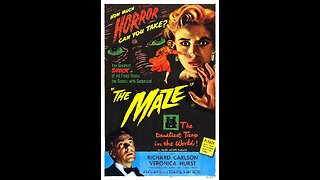 1:20:23
1:20:23
Classic Films & Movies Archive
6 days agoThe Maze (1953) | Directed by William Cameron Menzies
262 -
 5:13
5:13
Members Club
5 hours agoProposal Fails You Won’t Believe 💍😂
3.78K -
 LIVE
LIVE
SportsPicks
3 hours agoCrick's Corner: Episode 66
70 watching -
 29:09
29:09
The White House
3 hours agoPresident Trump Participates in a Bilateral Meeting with the President of Ukraine
11.6K46 -
 1:47:30
1:47:30
Tucker Carlson
3 hours agoAuron MacIntyre: The American Empire Is Racing Towards Collapse. Here’s How to Prevent It.
67.4K61 -
 1:04:35
1:04:35
Mark Kaye
3 hours ago🔴 Trump and Zelenskyy Plan Oval Office Rematch!
7.12K2 -
 1:04:36
1:04:36
Sean Unpaved
3 hours agoBehind the Snap: Unpacking Giants' QB, Saints & Browns Battles, Caleb's Climb, & Cowboys' Plan B
32.6K -
 LIVE
LIVE
Barry Cunningham
6 hours agoBREAKING NEWS: PRESIDENT TRUMP MEETS WITH ZELENSKY AND OTHER WORLD LEADERS!
2,056 watching -
 LIVE
LIVE
Nerdrotic
5 hours ago $2.06 earnedSuperman GUNNED DOWN | Marvel Phase SUX - Nerdrotic Birthday Nooner 508
604 watching -
 18:52
18:52
Neil McCoy-Ward
3 hours agoBrace Yourself… They’re Coming for Everything You’ve Got!
12.4K9
